Road King 12/20/02 Part II
By Robin Technologies |
I couldn’t think or speak. I had a week and a half to insure that this puppy ran. I could sense fangs growing under my upper lip. I began to snarl as my fingernail extended beyond my cold hard hands. My eyes reddened, and I wanted to ride. Without the throttle cables I could use the cruise control, if it still worked. I could jam it into gear and fly. Frank hit me with a torque wrench. “We’re burnin’ daylight,” he snapped, “Let’s measure the cables and install the left Knuckle style grip.”
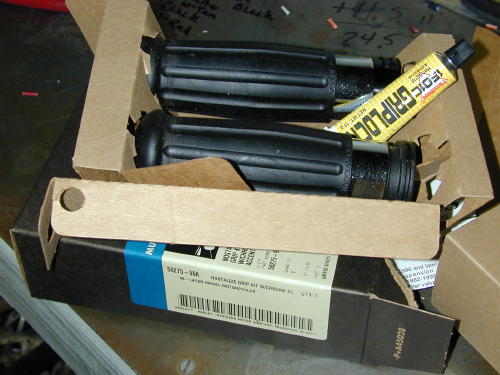
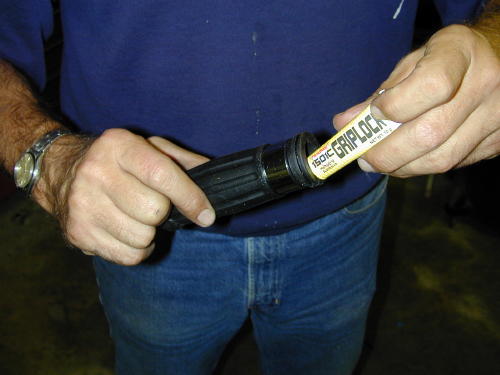
After wiping the grip end of the bar down with alcohol, the grip interior was coated with the rubber cement, that came with the grips. Then it was immediately slipped into place.
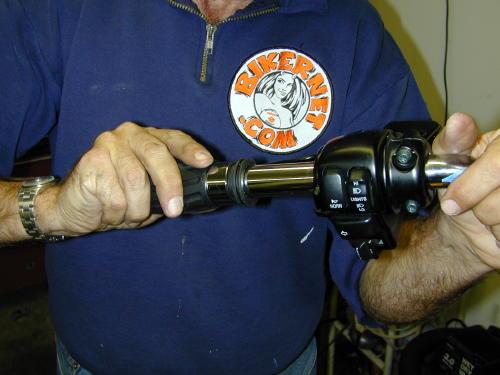
I snapped out of my Werewolf London fog. We measured the clutch cable then compared our findings with the throttle cables. As I suspected, lucky 13 inches to make up for the 12-inch taller bars that were an inch wider than the stock units. Frank made a B-line for the phone to call Barnett’s and ordered the cables. We were scheduled to roll up to the fleet center for a performance upgrade on Friday. It was Tuesday and the cables wouldn’t arrive until Thursday. It was going to be a close call. “Barnett has been around since Moby Dick was a minnow,” Frank said. I’ve been ordering custom cables from them since I was in my 20s and first influenced by Apehanger madness. “They are as reliable as the sun on the coast,” Frank continued, but I was still nervous.
We weren’t done yet. We torqued (15 foot pounds) the bars into place and began to cut and fit Goodridge brakes hoses, distributed by Barnetts and Custom Chrome. Another delicate operation.
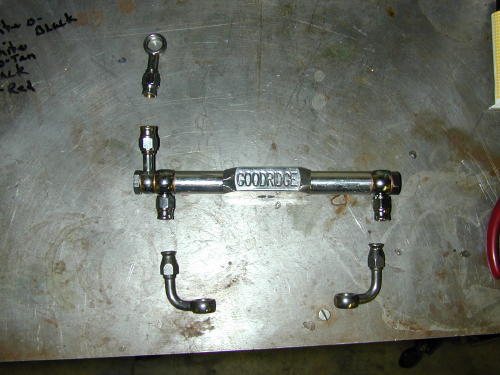
The King has dual disc brakes and the fittings had to be installed just right, tightened properly and finally torgued into place. From the bottom of the triple-trees we used the stock measurement to the calipers from the existing junction under the trees. The new lengths of Goodridge hose were cut with the largest, strongest side cutters I had. Before any fittings were installed we slipped a 2-inch piece of black 3/8-inch diameter shrink tubing over the hose. Next a chromed pinch fitting was slipped over the cable. Frank brought the tools and supplies including a tool to spread the braided hose after the rubber housing was stripped away to allow the new fitting to be installed.
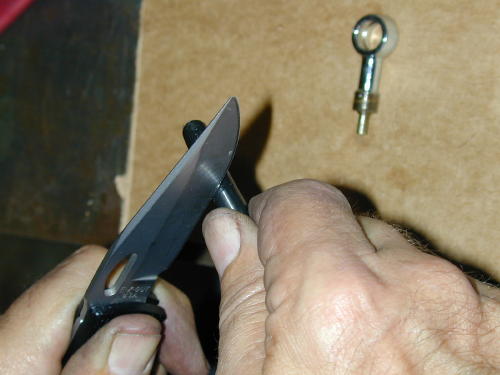
Stripping the rubber sleave back from the end about an inch.
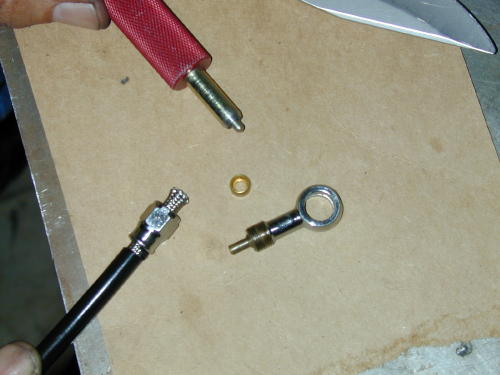
Here’s all the components involved in the process.
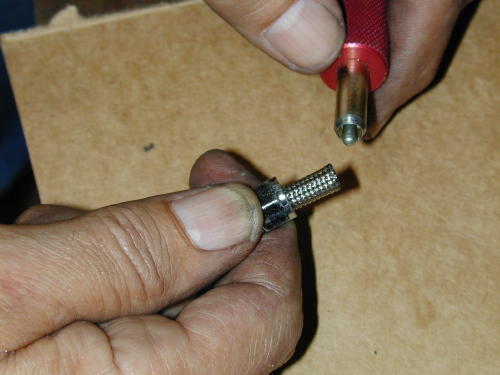
The tool used to spread the braided steel shield.
Then a small brass round furl (like a brass ball-bearing with a hole in it) is slipped over the plastic lining. It must be pushed to the point where the internal brass ridge meets with the end of the plastic liner. The other half of the fitting with the long tube is shoved into place. In each case we clamped the fitting between two sheets of leather then began to tighten the sleeve onto the fitting. In each case they were a bear to tighten down indicating that we had succeeded in a strong, secure grip.
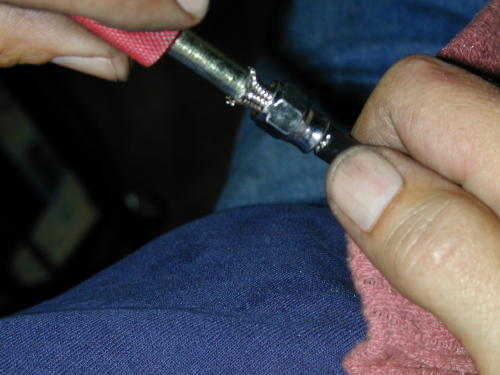
The spreading process involves shoving the tool into place and swiveling it to make sure the braided area is spread consistently.
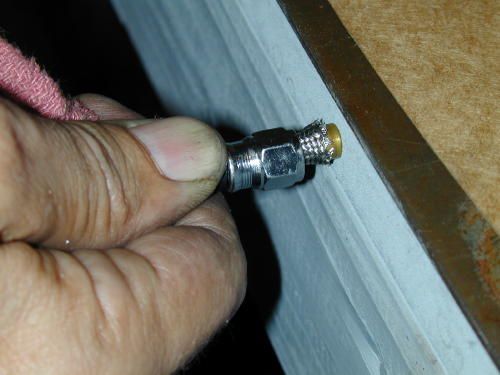
Installing the furl is simple, just slip it on carefully then push it into place. But, inspect the inside to make sure the plastic hose is against the interior ridge.
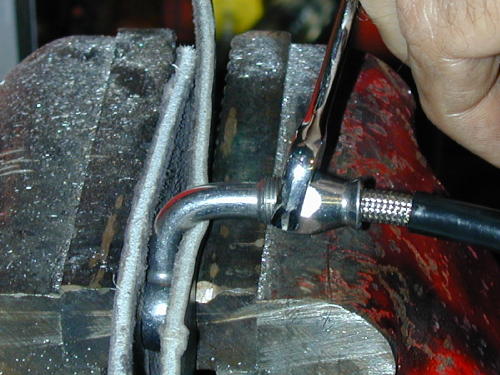
Now tighten the pinch fitting. Note the leather pads in the vice to prevent damage to the banjo fitting. These puppies are tough to tighten down, take your time.
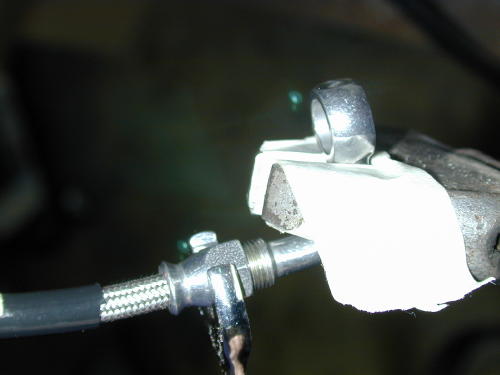
Here’s another way to hold the banjo fitting for final tightening. Be careful not to bend or damage the sealing surfaces.

Note the two bronze washer/gaskets on either side of the banjo fittings for proper sealing which is critical to your brakes.
After each line was carefully constructed, they were installed on the bike after some jockeying with the Goodridge billet junction under the tree which fit precisely.
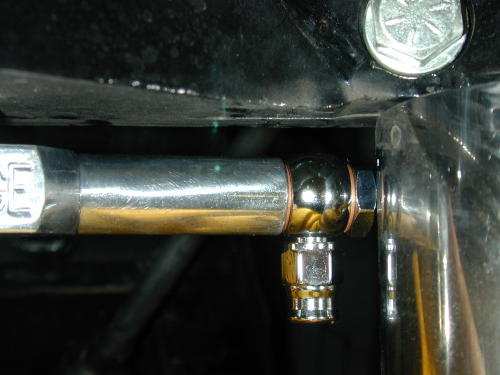
For some reason, this Goodridge junction mounted extremely snug between the fork tube guards. For awhile we thought we were in trouble.
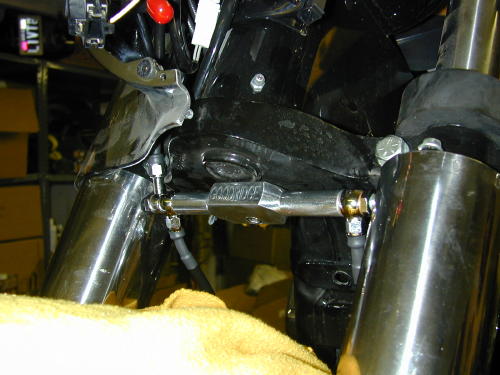
We followed the original routing of the stock brake line through the nacelle. With the lines in place we torqued them down (17-20 foot pounds). I took the easy way of bleeding the brakes. I pulled on the lever gently allowing the bubbles to pass through the master cylinder. It took a while, and I had to keep filling the reservoir as the the lines drained the supply.
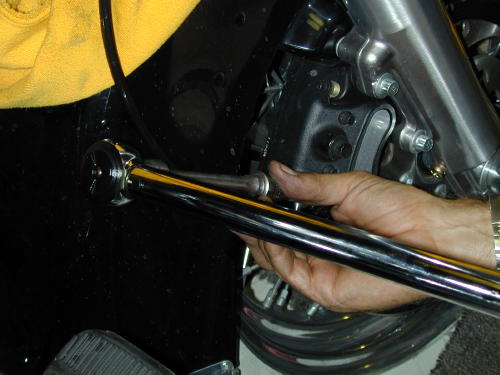
We used the stock 12-point fittings which torqued down easily to 17-20 foot pounds, which seemed like a lot.
We had completed all that was possible for Tuesday and I swung my leg over the saddle once more. As fire and smoke poured from my ears Frank crept out of the garage and into the night.
Thursday morning I paced the vast porch in front of the headquarters waiting for the UPS man. The truck sped past without a hint of slowing. I called Frank, he called Barnetts. I called the Fleet center after finding that the cables wouldn’t arrive until Monday morning, guaranteed. We had an American Rider magazine deadline, but more importantly I had a run-to-Arizona-deadline for the following Friday. I started pacing the garage and bowing to the new 16-inch apes. I knew, by the power of the Ape, we would succeed.
At 9:00 a.m. in my boxer shorts, Monday morning, I met the UPS man and signed for the Barnett package. I started to lube all the cables then decided that I should get dressed.
In order to install a new clutch cable the face of the transmission must be removed. I was surprised that this was the first item that I ran across on the King that was a pain in the ass to install. The entire exhaust system had to be loosened all the way back to the rear muffler isolator. before the clutch release housing could be removed.
With large clip ring pliers the throw-out mechanism was set free to release the clutch cable which virtually snapped into place. Then the cover was spun to allow the cable housing to unscrew. Next the new cable was fed along the same route as the stock job.
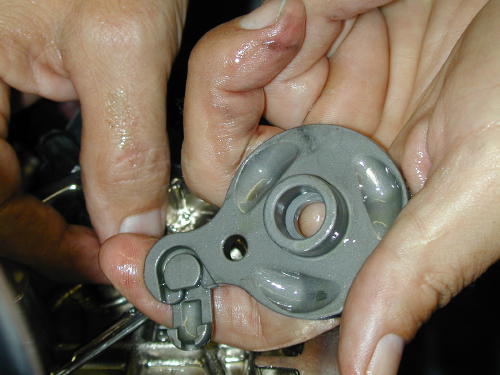
Once the clutch release cover is removed and the clip ring snapped out, you can see the outer ramp with the coupling ready for the cable.

If you look close the cable has been fed through the hole and is heading towards home.
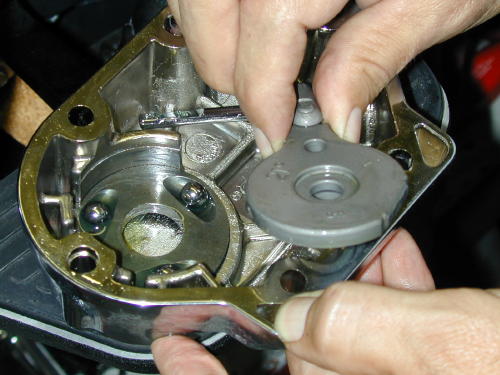
Now with the new cable attached the outer ramp heads back into position. Watch you don’t tilt the case. The ball bearings will escape.
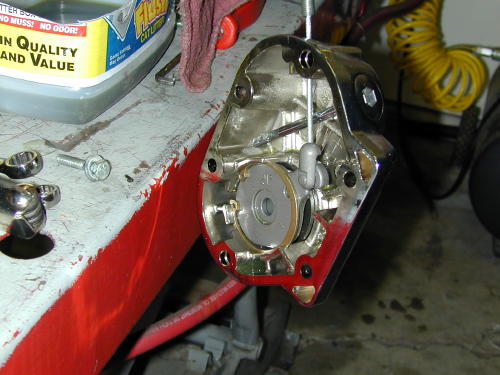
This shot shows the entire clutch release assembly complete. Remember as you reposition the clip ring to put the sharp edge up for the most secure bond.
We discovered that we had a lot of slack and rerouted the clutch cable outside the front motormount to eliminate some. Then the tranny cover gasket was wiped clean and the cover replaced (torqued to 10-12 foot pounds), then refilled with tranny fluid to the appropriate level with the bike upright and the dipstick threads just touching. We filled it to the top dipstick mark, about 3/4 of a quart capacity.
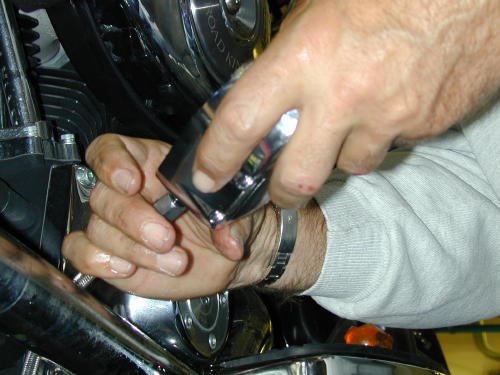
With this assembly you spin the cover onto the cable, not visa-versa.
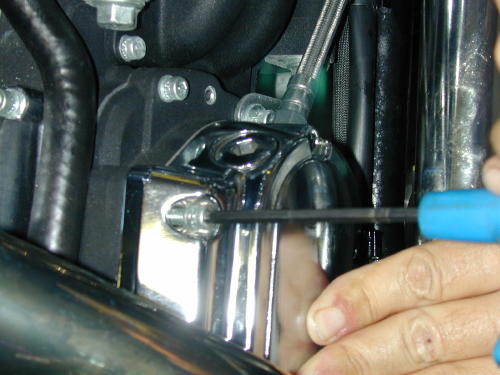
According to the book, the torque specs call for 10-12 foot pounds of torque to snug up the clutch release cover.
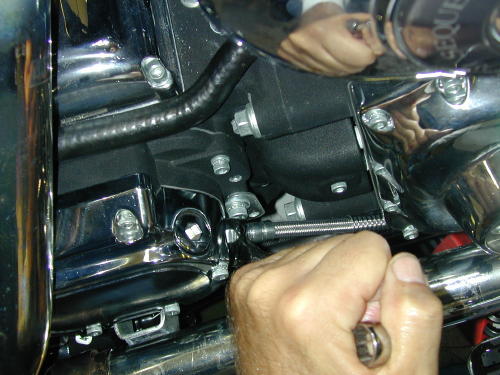
With a 9/16 box end wrench snug the cable housing down with a new o-ring attached.
We jacked-up the gas tank to afford us access to the fuel injection throttle cable routing. With the three tank mounting bolts removed the tank was lifted easily until a chunk of wood could be wedged under the front of the tank. Then I figured out which cable was what. With a small Crescent wrench, I loosened the throttle cable adjusters and took out all of the adjustment to allow lots of cable slack.
The unit with the small spring around the cable at the throttle body end was the push cable. I fed the braided cables through the runners as if they were stock cables. You will note, if you attempt this, that there is a Cruise Control connection in one of the stock cables at the neck. We unplugged it with trepidation. I wasn’t sure what havoc it would cause. I hadn’t tried the Cruise control. As it turned out, it’s a sensor to kill the control, if you back off the throttle abruptly.
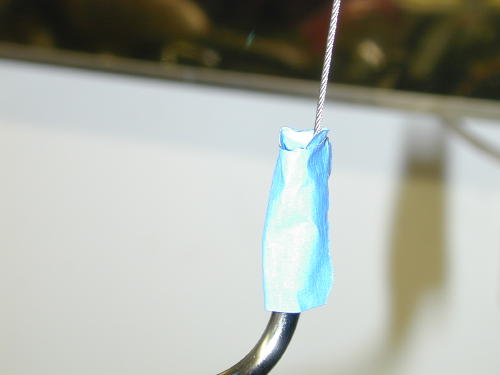
Lubing throttle cables starts with wrapping the cable housing with a little masking tape to create an oil container. Fill it with a light 3-in-1, silicone, or Marvel Mystery oil and let it seep into the housing. Fill it several times.
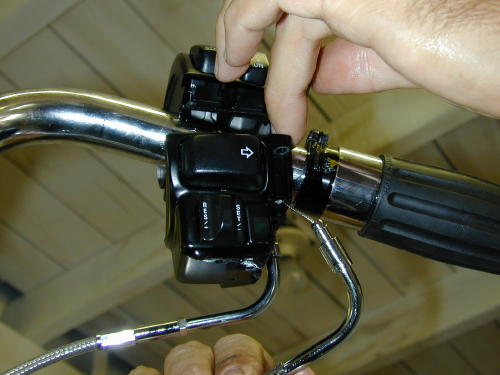
Feed the cables up through the throttle casing. With a little force they will snap into place.
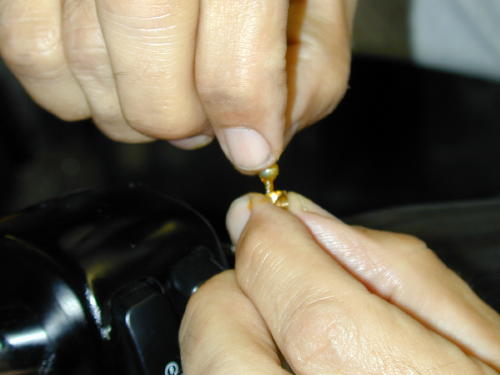
Make sure to grease the brass barrel before installing it to the cable end. The grease will help hold the barrel in place.
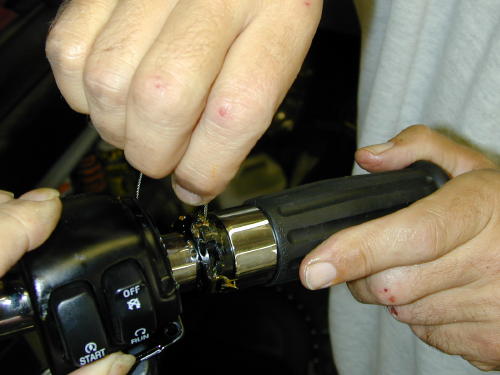
With the Barnett cable set at the most slack position, slip the barrel and cable onto the greased throttle guide grove.
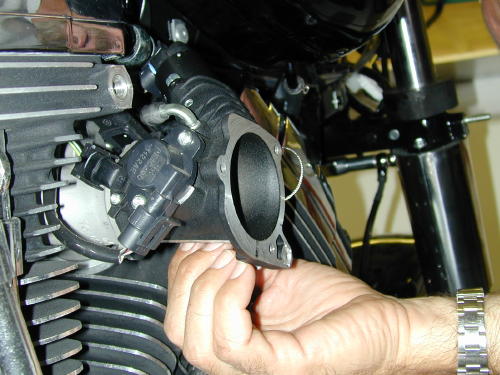
This is not a good shot of installing the cables into the guide slots in the intake module, but it’s easy. Just make sure you have the right cable in the right slot. It doesn’t hurt to grease them which we forgot.
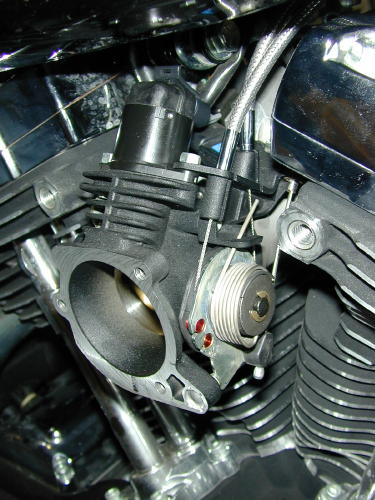
Here’s the cables in position. That odd short cable on the side is the cruise control job.
Make sure you oil the throttle cables before they are snapped into the throttle housing on the bars, because the spring clips that hold them into place are a bitch to remove. The cables were both put into place with brass rollers, “After you grease the throttle and cable runners with a Q-tip,” Frank reminded me. Be careful not to lose those tiny brass suckers. I was told later to try to adjust the cables evenly under the throttle and make sure you have slack in both lines so you don’t have continuos drag on the cable fittings.
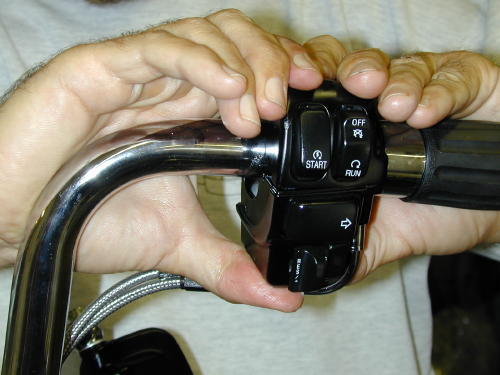
Here’s the throttle body in place waiting for the front brake mastercylinder.
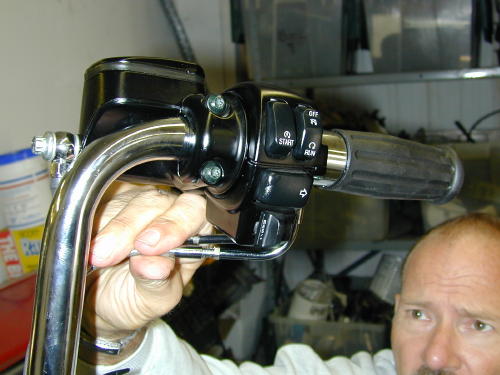
According to experts, you should adjust the cables so that the adjustment screws are approximately equal in length. My adjustment had to be straightened out at a later date.
Finally we replaced the air cleaner backing plate using Phillips screwdrivers to hold the gasket in proper position. Next the breather hoses had to be pushed onto the head fittings and lined up with the air cleaner element. Lastly the cover was installed. It was time to ride.
But not so fast Kimosabe. We had to install the riser cover, the nacelle trim and the headlight assembly. We were hauling ass.
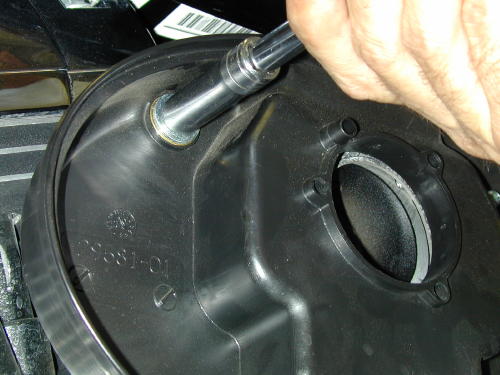
The actual breather fittings hold the air cleaner backing plate into place.
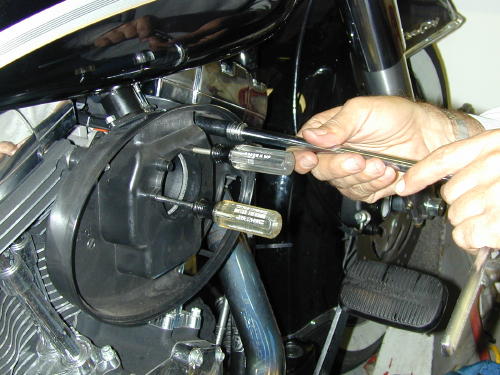
Use small Phillips screwdrivers to hold the air cleaner gasket aligned.
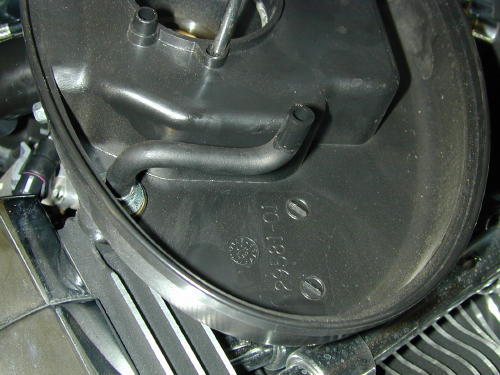
Push the hoses into place keeping in mind that they feed into the air cleaner element.
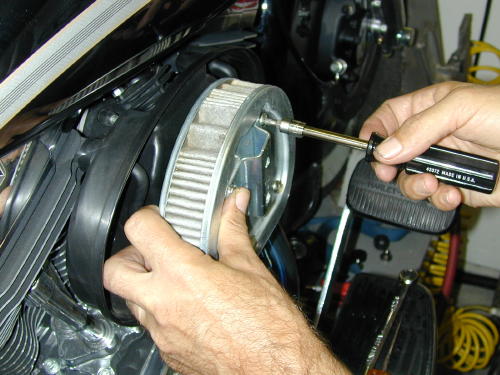
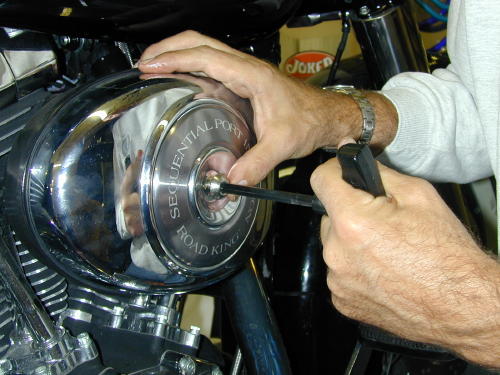
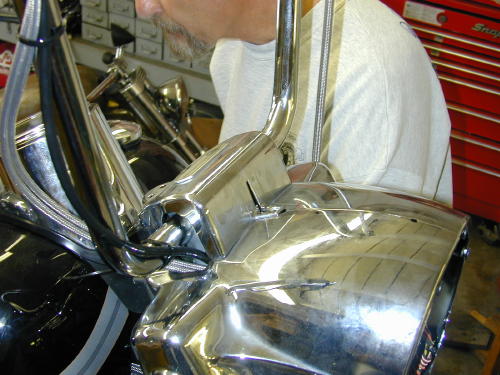
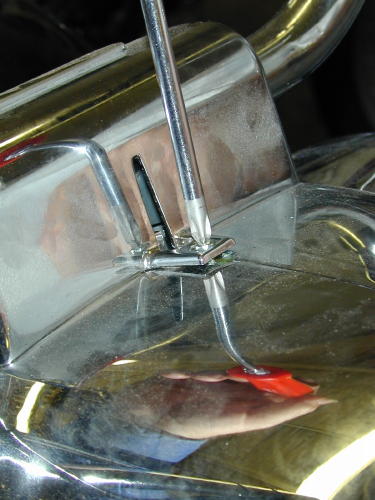
This little nut and screw are a bear to replace but must be handled before the nacelle strip can be installed.
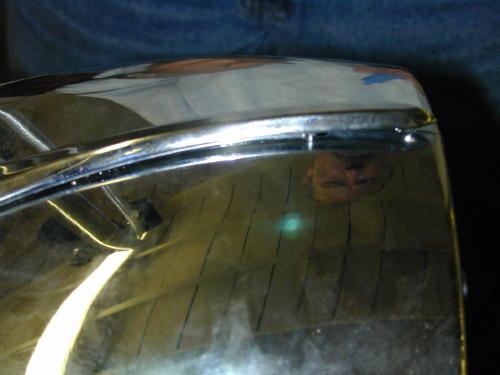
This slightly out-of-focus shot shows the little stud that slips through the nacelle. Make sure the strip is locked into the riser cover slot before you tighten the nut.
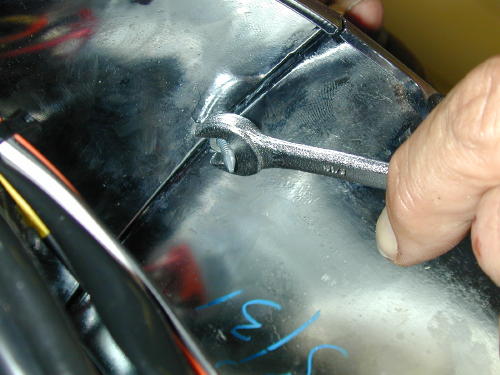
Tighten the nut lightly with blue Loctite to keep it from rattling loose.
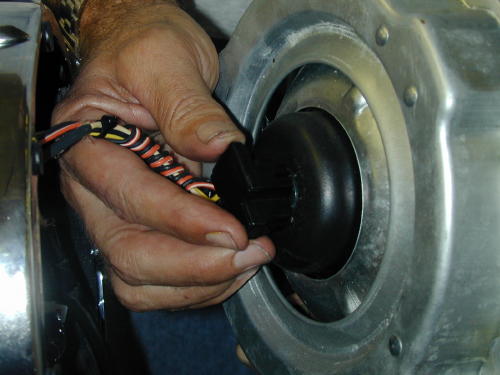
Don’t forget to plug the headlight in before you install it, like I did.
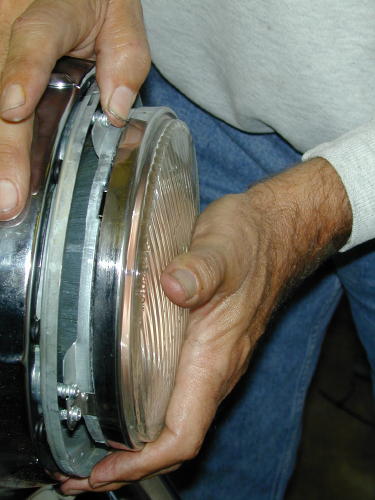
Install the headlight assembly with all eight black screws. Leave the bright adjustment ones alone, unless you lowered your bike. Then it needs adjustment.
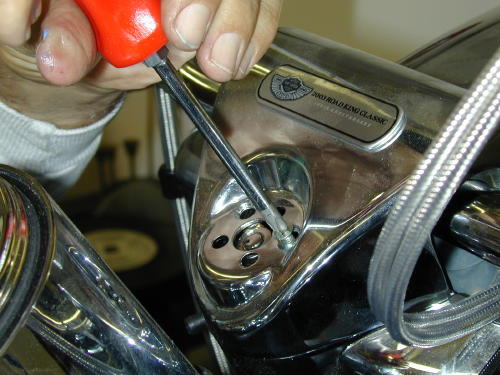
We could screw the riser down with the Phillips screws and replace the snap-on ignition ring last. I still don’t like the way it fit and need to check it again.
By noon on Monday we had completed the Highbar installation and I was itching to hit the road. We had moved our appointment at the fleet center from Friday to Monday morning, then to Monday at noon. We didn’t roll up to their doors until 1:30 p.m. and Alan, the master mechanic announced that he was leaving at 4:00. We were burnin’ daylight once again. Would the pressure every end?
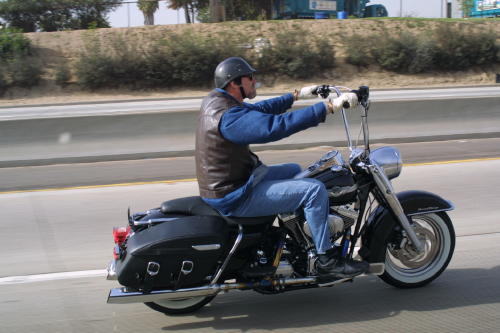
The final Frank shot with one hand hanging outside of a van window. I want to thank Frank for the use of his tools and his photographic and technical skills. Those elements and my bumbling hands make these techs as complete as they are. Believe me, it’s a bastard to build a bike, write a tech and take the shots at the same time. We’ve done it before, but a team efforts helps a helluva lot.
Next, we’ll install a performance package with Screamin’ Eagle heads, cams, air cleaner and two into one exhaust that we had jet hot coated. Hang on.
–Bandit

The Magnificent 5-Ball Factory Racer Featured
By Robin Technologies |
.jpg)
Editor’s Note: Our 5-Ball factory racer was feature in Heavy Duty Magazine in Australia recently. It’s the largest selling custom bike mag Down Under. The story and the photos were handled by the amazing Smilin’ Doc Robinson, the longtime tech editor. I’ve left the story alone for your viewing pleasure. Enjoy.–Bandit
Many interesting and colourful characters populate the biker world and Keith “Bandit” Ball walks tall among them. And not only because he tops out at six-foot five inches. Lifetime biker, author, longtime Easyriders’ editor, custom bike builder, salt racer, founder of the premier web site Bikernet.com, Bandit is all this and more.
Get him settled in the comfortable lounge seat in his Los Angeles abode, pour him a stiff whisky, and sit back as he shares tales of the road, some that would make your hair curl, others that are genuinely side-splitting and always among them, lessons to be learned about life.
I figured that the best way to introduce this build to HEAVY DUTY readers is to give it to you in Bandit’s own words: “For decades guys have built vintage- looking scooters with late model drive-trains. Hell, I built another one at Strokers Dallas in the ’90s. Before I dreamed of it, Arlen Ness built a ’20s vintage scooter and sidecar around a Sportster engine.
Randy Simpson built vintage kit bikes. Don Hotop built some of the finest vintage-styled customs and recently I saw a ’20s styled bike at the SEMA show in Las Vegas built by the Shadley Brothers for House of Kolors. Beautiful piece. So I ain’t the first by a long shot. But there is something in the air recently about respecting the old iron and bringing it back to life. Some of it has to do with restrictions, and building older bikes is unrestricted. Some of it has to do with nostalgia and some is just a wild departure from the last project. I’m excited every year about this learning process.”
I asked Keith to sum up the vision that drove this build: “Well I built it in the teens vintage style, but with my height and long limbs I had to scale it up a bit. It’s built for long miles, with floorboards, a sprung seat, rubber grips, tall gearing and a spare gas tank. Every custom motorcycle build is an adventure. It takes me from one crazed time in my wild life to another. Fortunately, I’m not spilling my guts about another woman I lost during a knuckle-busting build. But this build did represent turning points. I’m rapidly closing in on my mid-sixties and about ready to sign up for Social Security. It also represented our stinky economy.”
Bandit is such an industry icon and it is not surprising that many of the leading lights of the motorcycle aftermarket were involved in this build, blokes like Ron Paugh of Paughco, leading manufacturer of custom parts and accessories for the past forty-three years, Rick Krost of US Choppers, Chica, who needs no introduction, Gard Hollinger of LA Choprods and HEAVY DUTY photographer Glenn Priddle who made the sweet seat.
Here’s Bandit again: “The key to the success of this project is the drive train. I sought a Crazy Horse V-Plus, 100-inch engine for several reasons. It has a classic design, renewed performance, cool looks and a left-side carb. I coupled it to a JIMS 5-speed transmission with a Baker kicker unit and Baker N1 shifting drum, so I can run the tank shifter and find neutral without a problem. The rocker clutch system I put together from old H-D parts while I fabricated the tank shifter.”
When he hasn’t got a fast motorcycle between his legs, or a whiskey in one hand and a beautiful redhead in the other, Bandit is happiest welding, soldering, wrenching, milling and turning metal in his secret and damn well-equipped lair beneath Bikernet HQ. His other love is writing, usually upstairs in his 1923 shop, behind his glass-topped Panhead-motor desk, rattling his computer keyboard, churning out another fiction book, a book for motorbooks, magazine articles (sometimes for HEAVY DUTY), or news, or one of dozens of tech articles for Bikernet.com.
And for those of you who are truly interested in the real guts of bike building, let me recommend reading the whole story of this build on the Bikernet.com web site. It runs over some eleven parts and is well illustrated with photographs showing each and every step of this build.
If you only read one part of the full story, make it Part 6 where you’ll see the immense amount of work that went into the rear fender fully detailed as master metal shaper Chica gets to work. But once again, I strongly recommend you read the whole thing as a salutary lesson on just what goes into a ground up build. Without the space limitations of a magazine Bandit is able to show and tell stuff that you won’t find elsewhere. To find it, go to Bikernet.com and click the Free Departments button and select Techs and Bike Builds and scroll backward through the various articles until you find Part One and take it from there.
I really dig this bike in every aspect; the concept of honouring old iron in this way, the marriage of old school looks with a nod here and there to practicality and safety, given that brakes back in the first two decades of the twentieth century were mighty primitive to say the least. I love that shifter in all its brassy mechanical glory, the vintage touches like the chain oilers and the leather strap holding down the battery and the cool fuel tank mounted up top to extend the bike’s range.

Having examined it closely, both during construction and in its completed state, I can attest that the fit and finish all over is excellent and detail touches like the pin striping are icing on the cake. Keith thanks Sin Wu for her part in this build and reckons this woman is a keeper, and I can understand that. This bike is a beauty and will look just as cool in fifty years from now. Way to go Bandit, I’ve seen several of your other builds but with this one you’ve climbed a pinnacle. HEAVY DUTY is proud to feature it in our pages.

BIKERNET EXTREME GUTS&BOLTS TECH CHART
ENGINE
Type: Crazy Horse Power Plus 100
Capacity: 100ci
Cases: Stock
Crank Stock
Bore: 3.874″
Stroke: 4.25c
Heads: Stock
Ignition: Thunderheart
Carburetion: S&S Super E
Manifold: Stock
Air cleaner: powder coated by Worco
Exhaust: Bandit built
Muffler: Stainless Scorpion from John Reed
Estimated power: 80hp
TRANSMISSION
Year: 2006
Type: JIMS
Number of gears: 5
Gearchange: Bandit built
Baker N1 Shift Drum
Clutch: BDL
Primary drive: BDL Classic powder coated by Worco
Rear Drive: Exile chain
SUSPENSION
Front: Paughco narrow tapered leg springer
Triple Trees: steel from Paughco
Mods: 2″ under length
Rear: Rigid U.S. Chopper design
WHEELS
Front: Black Bike dimpled 23″
Tyre: Avon
Brake calipers: GMA by BDL
Brake rotor: H-D
Brake lines: John Reed
Rear: Black Bike dimpled 23″
Tyre: Avon
Brake caliper: Exile
Brake rotor: Exile Sprotor
FRAME
Type: US Choppers vintage rigid
Make: Factory Racer by Paugho
Year: 2009
Rake: 30 degrees
Seat: Glenn Priddle
CONTROLS
Handlebars: Narrowed Flanders
Grips/levers: H-D, BDL/GMA
Risers: DPPB bronze dogbones
Master cylinder: GMA front
Mirror: Lowbrow
Headlight: pinstriped by George the Wild Brush
Footpegs/forward controls: Paughco vintage footboards
Rear brake master cylinder: H-D
Speedo/tacho/oil pressure: Biker’s Choice Vintage Sportster
Taillight: powder coated by Worco
Other modifications: rocker clutch system made with old H-D parts, Phil’s Speed Shop wiring harness and ignition system, alternator charging system by Spyke
GUARDS/TINWORK
Front guard: missing
Rear guard: Chica
Fuel tank: Paughco
Trim: gone
Oil tank: Paughco
Other modifications: Vintage H-D tool box and brake linkage by Paughco, Reserve gas tank by Mike Pullin
COMMENTS: This bike was built in the teens vintage style, but built for long miles with footboards, sprung seat, rubber grips, tall gearing, and spare gas tank. The plan was to ride to Sturgis, but I never got out of Dodge. Now the plan is to ride it to Arizona for the too broke for Sturgis run to Salome, a little sun burnt town in the middle of nowhere. But it has a very cool or western saloon on the edge of town.
Partners in Crime:

Sturgis 2000 – Part 1 Whiskey, Women and the Open Road (Continued)
By Robin Technologies |
|
Continued from page 1…… I was about to reach for the phone book one morning, on an ass-saving spring hunt, when the mail arrived with an invitation to the Harley-Davidson new-model announcement. At that point I was spending every extra moment in the garage and interruptions were a problem. But the factory has always been supportive and I couldn’t miss the new bike review so I signed on for the event. It took place in Pasadena and all the moto-journalists from the Southern California region were on hand. Occasionally during the presentation I would peer at the list in my pocket and go to the dingy corner where the heads were to make a call about chrome or parts, or I’d call headquarters to check in with the crew. Some years the Harley announcements indicate business as usual at the factory with only minor changes. This year was a vast contrast to the status quo. It was immediately evident the company was making strides to capture a larger segment of the aftermarket with its accessory production pace and the focus on custom parts. The models radiated custom touches. They had finally truly lowered a bike, the new Lowrider Dyna. Road Glides were getting much more engineering attention. Performance was advancing quickly with a Holley Carb introduction and big-inch motor kits. Some of the new paint schemes reached deeply into the custom culture for colors and designs.
Then they came to the new narrower, lighter, police model for 2001. Cop bikes didn’t mean a hill of beans to me, but I scanned the more agile machine that is now available for individual sales and they’re cheap. Dan Ackroyd should get a new one. I noticed springs under the solo cop saddle and immediately jumped to my feet. Two representatives from the factory rushed to my side. “Can we help you answer any questions about the new police model?” one of the engineers asked. I started babbling about this stretched rigid I was going to ride to Sturgis and the two contemporary thinkers backed away as if my radical concept might rub off on them. I ordered a set later that day. They proved to be … well you’ll see. The frame was sent to the powdercoater, the chrome went out and the sheet metal was shipped to Harold’s. The waiting game began while I chased any missing parts. By the time the sun was blazing in the single window of our tiny headquarters, the frame was back in the garage and up on a towel-covered lift. The chromer made me wait another day. I was in the midst of a bolting-together orgy when the dark-haired one appeared in the doorway of the Bikernet den, peeling out of her threads.
Her alabaster skin looked like cream flowing into a hot cup of coffee. The satin shaved surface was too delicate to touch. What the hell is a biker to do when heaven is standing nude in the doorway? The crew was looking at 34 days until departure. I was looking at green eyes, a sensitive smile and … priorities men, priorities. It was a factor of hours and parts availability, plus watching for problems. Everything was seriously locktite drenched, tightened and tightened again. I notice a weak link immediately in the wheel spacing. This was an odd, uncalled-for operation. You buy wheels, they come with spacers. You install them and it’s a done deal. You go for a ride. So what was the problem? The tubes had been cut and collars added to assist with holding the grease near the bearings, and to hold the spacer centered when the axle was removed. They weren’t shabby. The dilemma made me second-guess my installation. I checked and rechecked the life-threatening problem. If I left them alone, I would certainly be a candidate for a high-speed wobble. If I set them up too tight, I could burn up the bearings in the desert and be left alongside the road to fry in the sun. Something had to be done to correct the wheels or find out where I went astray. With spacers the correct length, the wheels and brakes could be installed for the last time and anything that could reach final assembly made me smile and saved time. We were frustrated. I centered the wheel and began to space the P.M. Calipers. Something wasn’t right. There was .020 slop in the center spacer that pre-loads the Timken bearings. I was blown away and stayed up until 2 a.m. with a sheet of glass and wet and dry sand paper trimming the spacer down while insuring the flat parallel surface to the bearing race as left intact. I finished uncertain of the tolerances. Later I found that the tolerance prescribed by the factory is .004 to .014. It is recommended that with aluminum hubs you should lead your figure to the .004 side. There was another weak link and Harold mentioned it as soon as he received the mounted Sportster Tank. “That tab system is a little shaky, Bandit.” What could I do? I had two 1/8-inch-thick straps that ran the entire length of the tank and out both ends by three inches. At the last minute I eliminated one because I felt it would be too difficult to bondo. The tank was now in Harold’s hands and time was running out. If I had sent the bare frame to Harold, he would have mounted the gas tank by his proven method. The decision had been made and I would be forced to live with it. We kept moving. Ah, but there was another adjustment that lurked in the back of my mind, although Giggie from Compu-fire checked my installation and gave it a thumbs up. I was sketchy about the primary drive adjustment. I had slipped the original inner-primary O-ring between the engine cases and the motor plate for vibration relief. Bad move. The BDL belt was too tight.
There was no slack in the belt and I wanted some. I had to loosen the transmission, unbolt the motor-plate from the engine and move the tranny forward as much as possible. It worked out perfectly, but just in case, I ordered a spare belt (I broke a primary belt in ’97 outside Denver). Giggie from Compu-fire helped kick off the wiring with the installation and timing of the Compu-fire single fire ignition. With it in place sans the Voes switch (this is a chopper, right?). About that time, a tall Asian in a flowered bikini and a black towel strolled past the headquarters on her way to secluded Cabrillo Beach. The entire crew was distracted. It wouldn’t be the last time Sin Wu captured my concentration. She became our lunch time mascot, dropping in from time to time to check the progress and tantalize us. The rear wheel had yet to be spaced properly. It suffered from the same malady as the front wheel and the last thing I wanted storming through my brain at 5 a.m. on a highway in the middle of nowhere was my wheel spacers. We were forced to remove the rear wheel again. I had built in a stud for the hydraulic brake switch behind an exhaust pipe as part of the exhaust bracket. The notion was to hide that ugly bastard yet make it accessible if need be. As it turned out, Joker Machine builds a micro brake switch into their forward controls. Ultimately a dice was drilled and tapped to conceal the stud. Just as I finished the wiring, the paint was delivered. Harold and I discussed the paint scheme at length. The first problem was the frame paint. We were limited to a bright metallic blue. I sent Harold a chunk of square tubing painted the same color to match. He studied it and went to work. We discussed white pearl or cream colored flames and he decided to add a silver accent. We couldn’t decided what color to pinstripe with. We discussed red, pink (no way), even green, but nothing jumped out at us. When Harold called and said he’d pinstriped it gray, I choked. It sounded drab, lifeless. A week later, after clear coating and drying, the paint was shipped. I had become best of pals with the UPS guy, who showed up daily. When he showed up with a small package he’d be greeted with a long face from a disappointed crew member. “We need bigger boxes and more of ’em,” Wrench told him one morning. We did. We were biting our nails, watching the clock and the calendar. The plan called for a running motorcycle two weeks before the takeoff date. The first stretch of road to Phoenix was 450 miles of blistering desert and I was riding alone. I needed a break-in period. Most years we had little or no break-in time. Last year the Excelsior-Henderson had no miles on it after High Tech Custom Cycles customized the rowdy 85-inch monster. I had it for two days before leaving. The first day the front brake kept locking up and we discovered chrome chips in the front master cylinder. With that fixed, I thought I was good to go until the starter motor blew up in my face the night before takeoff. We made arrangements with Bert’s Cycle Mall in Azusa to fix it. I hired a guy to drive my truck, my bike and me to Bert’s, where we sat for half the afternoon while they replaced the starter and some fried bushings, then retuned the bike with a new computer program. Dr. Hamster and I sat in their waiting room with our gear and waited patiently for the verdict. It finally came with a road test by the main mechanic. He rolled out of the parking lot without making eye contact with either of us.
The year before that, it was the street stalker built essentially by Bartels’ Harley-Davidson. Before that, it was the touring chopper built by Jesse James. All of the above are professionals who are constantly building bikes, have mechanics and extensive tools and supplies. I’m not, and my guys all work on old Panheads. So when we took on these projects as non-professional, skirt-chasing, beer-drinking geeks, we wanted more time to correct all the bullshit mistakes we would make. As it turned out, we didn’t make any more mistakes than the pros had in the past. Plus the feeble, leaning Bikernet headquarters held nearly every tool we needed to keep the operation going. As the sheet metal arrived, Sin Wu and I slipped into the basement of the vast Bikernet headquarters to un-box, un-peanut, un-bubble wrap and un-cellophane the paint. The gray pinstripe was perfect, the finish clean and classic. We made love in the basement in celebration and as a tribute to the notion that this underground slab of concrete would soon become the international Bikernet shipping and receiving department. Fuck, life can be exciting. Sin went home and the brothers began to install the tank and sheet metal.
We were moving fast. Time was running out and days seemed to disappear. At one point, we had the grandiose notion that the bike would be ready for the Exceptional Childrens’ Beach Ride in Ventura, California. We couldn’t make it. Then the Calendar Girl Show loomed. What was once the Mikuni Bike Show at the Santa Monica Airport had transcended into the Calendar Girl/White Bros. Show in a small park near the looming bow of the Queen Mary. Cool location, but could we have the bike up in time? Wiring went easy with the internal tubing installed in the frame by Daytec. Tubes ran from the back of the seat post to the top motormount and down the seat tube to the oil pump. I quickly discovered that I could run two switches in the top motormount and Giggie suggested a polished aluminum plate to conceal the switch backs and the single circuit breaker. Giggie emphasized that we use mil spec (military specification) or Marine switches. I had purchased plastic Marine switches but wasn’t confident in them. I wanted to head over to Neptunes Electronics for some heavy duty mil spec metal units, but it never happened. The wiring continued with two switches to control all the electronics on the bike. An on/off switch turned on the ignition and the brake and tail lights and energized the high/low beam switch. The on-off-on switch controlled the headlight and that was all. For the starter switch we used Custom Cycle Engineering’s new mechanical push button, which mounts directly to the starter solenoid of the Compu-Fire starter. It’s the cleanest switch in the world and works like a champ, but if your pipes come anywhere close to the switch, watch out. It’s easy to burn your mitt when the bike is hot. Plus the switch is bolted to the right side of the bike and down low. If that’s going to be a problem with the carb and reaching the throttle, you need to consider those obstacles. It worked like a champ on this rigid with the pipes we chose. For our pipes, we picked a set of Samson 2 1/8-inch drag pipes for a Dyna Glide because they don’t make pipes for rigid frames. From a performance standpoint, I wanted the 98-inch S&S stroker motor to run as effortlessly as possible. I had discovered by mounting a Compu-Fire single-fire ignition system on the touring chopper that it calmed that stroker motor, so I did the same on this one. I wanted to even the exhaust system for firing balance. One pipe was 12 inches longer than the other and hung down too far, which would hamper ground clearance. We took two inches out of the down stroke. Wrench gas-welded it back together with a coat hanger. Then we cut the pipe to even the lengths to 27 inches. That seemed precariously short for the diameter of the exhaust, so we took two Samson exhaust muffler baffles, cut them in half and installed them. Finally, for styling purposes, we asked James Famigatti to scallop the ends of the pipes to contour the shape of the Milwaukee Iron fenders. We called Mikuni America and asked about the carburetor. Lee, the man responsible for every Mikuni carburetor that flies into the states for motorcycles, asked, “For your bike?” “Yep,” I said. “You’re going to install it?” “Yep,” I said. “Forget it,” he said, “Bring the bike to me. We’ll make sure the intake is correct and the cables match, and that the bike runs.” I didn’t know what to make of it, but I did as I was told and delivered the bike to the Mikuni factory. With the swift action of Barnett cables, S&S and American Iron Horse, the correct intake was procured for the tall barrel S&S stroker engine that tucked the polished 42-mm slide carburetor in close to the engine. They fired and tuned the bike for the first time. The technician, Bryan, warned us to back out the air mixture screw half a turn when I reached the altitudes of Denver. They also installed a large tear-drop, exposed K&N air cleaner that would afford the engine all the air it wished to gulp. Time was running out. We still needed miles on the bike but we had no speedometer and no idea where to put it. The cable was in the garage and the drive unit had been installed on the front wheel, but the actual speedometer was nowhere to be found. Then it dawned on me that the ’84 Shovelhead in Dallas had just the speedometer we needed, but planned not to use. I called and asked the crew at Dallas Easyriders to ship the unit quick and it was on its way.
|
Sturgis 2000 – Whiskey, Women and the Open Road on the Blue Flame
By Robin Technologies |
|
 Unlike many years in the past, I didn’t rely on any builders to make the deadline for the trek to the Bad Lands. The Bikernet crew handled building two road-sizzling chops in two and a half months. I’ve got to tell you that it felt good to get back in the garage amongst the socket sets, grinders and torches. Although the drunken work ethic was strong, several times during late-night wrench fests I came mighty close to firing myself. However, since I was one of a very small crew of volunteer wrench merchants, it didn’t make solid sense. Nutboy was there until he couldn’t handle the clogged pressure cooker in the garage, so he grabbed 30 college coeds and flew to Ireland. Never did get the meaning of all that, but it sounded like good fun. Agent Zebra flew in from Miami to pitch his movie 1%er for the 43rd time and came by the Bikernet headquarters to assist with his bike. I quickly discovered that the bull riding champion/survivalist can’t turn a doorknob, never mind a wrench. Renegade lost his patience and we kicked him out of the garage and told him to return to Hollywood and, “Don’t come back without a contract.” Wrench was constantly on hand, Snake was constantly drunk and Oz could never get away from his computer monitor long enough to help, but he was a constant source of phone-advice.
Renegade came to the garage daily to criticize everything from finish choices to components. That bastard would make a kid cry about going to Disneyland. He hasn’t had a good word to say since I met him in 1972, but he’s my brother. Whatta ya gonna do? Our challenge was to build two bikes and ride to Sturgis for the first Sturgis Bikernet Chop-Off, a bike-building competition between Bikernet East and Bikernet West. Great plans don’t always pan out, yet become blessings in disguise. We finally turned one world-class custom, which was not the road bike we needed, into two distinctly different asphalt gobblers. Were we up for the task? Did we have the skills and tools to build the bikes? Would they run once they were completed? Had I lost my eye for solid choppers or my mechanical touch? Keep in mind as this saga unfolds that this (Bikernet) is a start-up business, competition and life change. I’ve been helping people get their businesses, projects and products off the launching pad for almost 30 years. Now, faced with no paycheck and no expense account we attempted to build two bikes from the ground up just months before Sturgis 2000. In addition, we would be judged on who had the coolest chop and whipped the other son of a bitch from its designated homeland, namely Miami and San Pedro in Los Angeles, to South Dakota. With the Bandit II dismantled, we stood back and evaluated the situation. We had another set of wheels hanging around in the garage and miscellaneous other parts. Agent Zebra is a short, wiry asshole, so the Paughco frame went to him, along with a set of H-D custom wheels and rotors. We split the P.M. brakes between the two bikes. We checked our leaking bank accounts and began ordering parts. Since the frame for my ride had to be ordered from Daytec, we started on the Agent’s bike first. The original Bandit II narrow glide went back on the stretched Paughco Softail along with P.M. brakes and Harley Thunderstar wheels and rotors. The 88-inch CCI engine slipped into place along with the Baker five-speed transmission. As the days rolled along, we plucked more parts from my pile just to keep the starving Agent’s project rolling. The frame was still painted with the Bandit II theme, along with the tank, so we stuck with it. A Fatboy rear fender was fitted over the 160 Avon Tyre and sent to Phil Stadden for paint along with the West Coast Choppers front fender. The completeness of the 88-inch Rev Tech engines made the project much smoother. The Baker Transmission was a jewel to deal with and improved the ride immensely. With a few odds and ends from the extensive, “if you need it – they have it,” Custom Chrome catalog, the Zebra special was coming together. We had a minor clearance problem with the frame and engine. Fitting the 160 tire under the fender was tight and making the brakes work was a bit of a challenge. In no time, the bike was running and on a custom-painted Gold Rush Semi heading to Miami for the Agent. We shipped it to Eddie Trotta at Thunder Designs in Fort Lauderdale for break-in, a seat from the infamous Keith and tweaking.
Of course the Agent couldn’t leave well enough alone and he decided to have special panels painted on the sides of the tank and fender announcing his arrival. The paint work was handled by Eddie Meeks in record time, but it still sliced away at Zebra’s time for break-in. The crew at Thunder Cycle, with less than a week before kick-off, pulled burn-outs up and down the tourist-packed streets of Fort Lauderdale in an effort to spin the miles onto his new odometer. All right, you’re beginning to get the picture, but there are more obstacles to come. The young muscular Zebra had this Germanic girlfriend. She was tall and thin, with super-model looks, natural blond hair and blue eyes like you only see in Scandinavia. She had a whisper of a voice and could speak very little English. Unbeknownst to the Agent, he was in love. He bought her furniture, a car, took care of her expenses, etc. while he was working. Suddenly his Los Angeles highlife went into the shitter and he was forced to move quickly to Miami and set up a crack house in the middle of Cuban controlled South Beach. The competition didn’t take to the blond boy from Kansas, and they dropped a pill in lovely Nicole’s soup. She immediately fell out of love with Zebra and the world stopped. Not only did he lose his girl, but his access to a car and all the furniture in his pad. His massive, attack-trained Malinwa dog, Apache, went homeless on the streets of Miami while Zebra panhandled for coins along the route to the Badlands. On the other hand, my life was a circus of broken promises. Calling in a favor, I contacted Milwaukee Iron for fenders. I had helped Randy build his business from the beginning, yet when the fenders arrived, the UPS dude stood there with a unexpected C.O.D. request, and there I was, in the middle of a financial no man’s land. That scenario happened more than once. We even had a Bikernet sponsor sign our contract then go back on their signature. But “give up” is not written in the Bikernet mantra, so we rolled up our sleeves and kept wrenching. For every time I felt screwed, there was a bright star, a blessing in disguise, a pearl in our soup. The Weerd Bros. from Phoenix not only were helpful beyond our wildest dreams, but their product turned out to be a superb ride and a life saver. Harold Pontarelli, owner of H-D Performance, called me one day about a year and a half ago, while I was still at Easyriders, and said that for running some of his bikes in the mag and for being a friend, he wanted to comp me a paint job. I thanked him profusely, but never expected to take him up on the offer because I knew my days at the page factory were numbered. A couple of months after I left, Harold called me to say his promise was good whether I ever did a thing for him again or not. I was blissfully floored. Custom Cycle Engineering, which you can see featured on the site in our Panhead project section, has always been a good friend. I run their rubbermounted dogbone risers on all my bikes.
Finally, Ron at Paughco never hesitates to assist in any way he can. So for every screwing, there was a blessing. Finally, a company I had never had a chance to work with came to my rescue in the final hour. It’s odd that some of the companies I had assisted for years couldn’t step up. Yet the folks at Joker Machine, whom I hadn’t worked with, went out of their way to assist. Geoff and Diane were there when I needed them and I will be forever grateful. Their machine shop is impeccable, the product precise and well thought through, and examples showed up on the road to Sturgis from time to time. They take particular care with polish and chrome. Being flexible is a necessary evil to building a custom. When the bell tolled and the slick-as-a-perfectly-curved-tit Daytec frame arrived, we had five weeks to build the Blue Flame from the ground up. The custom Daytec rigid was ideal for the 14-over Weerd Bros. front end. Tony Day said of the specifications, “An Eddie Trotta formula frame.” Eddie from Thunder Designs in Fort Lauderdale builds a hard-riding stretched Softail chopper that makes riding like first-time sex. The question at that point was whether to send the frame with the sheet metal to Harold in Vacaville, Calif., or to powdercoat in three days and have the chassis building underway while the sheet metal was under the spray gun. Powder has its color limitations. It’s tremendously durable and strong, but comes in few colors. We found a company in Orange County, Primo Powder Coating (Huntington Beach, that has an unheard-of two-stage powder, so I was relieved not to build another fucking black bike. I love black scoots, but I’ve built one too many, including the Excelsior-Henderson last year and the ’97 Street Stalker from the prior year. It was time for a change. While waiting for the welds to cool, we debated whether to powder coat. While wondering, we narrowed a ’50s cop-bike solo seat one inch and Nuutboy fabricated a steel frame and pivot point. A bracket on the frame was modified to allow the seat to glide up and down with rear spring action. Two studs were welded in the center of the frame rails to correspond with the studs on the underside of the seat, but what about springs? The old Bates springs were never strong enough to carry the weight of a man. I had to find a set of 4-inch tapered coil springs that would handle my ass to the Bad Lands. It was June and the sun was as hot as my love life. Something sparked and a dark-haired bundle of intrigue entered my lonely existence in the middle of a bar fight. Although the pressure was on, she remained a soft-spoken Valium in tight pants. She was like finding a jewel in a trash bag full of crushed beer cans. Initially I was concerned, curious and watchful as she roamed in and out of my days, bringing coffee cake in the morning and sex at night. Her schedule fit well with work on the Web site, books and bikes. She showed up on my doorstep at 10 p.m. and slipped out at midnight. She had an 11-year-old daughter whose school was up the street from the Bikernet headquarters. She’d swing by in the morning on her way to work with packs of oatmeal and creamers, stay a few minutes and disappear out the door. She didn’t ask questions, didn’t seem bothered by anything and loved sex — my kind of woman. But I was focused on the goal to build the bikes and driven to ride to Sturgis.
I was about to reach for the phone book one morning, on an ass-saving spring hunt, when the mail arrived with an invitation to the Harley-Davidson new-model announcement. At that point I was spending every extra moment in the garage and interruptions were a problem. But the factory has always been supportive and I couldn’t miss the new bike review so I signed on for the event. It took place in Pasadena and all the moto-journalists from the Southern California region were on hand. Occasionally during the presentation I would peer at the list in my pocket and go to the dingy corner where the heads were to make a call about chrome or parts, or I’d call headquarters to check in with the crew. Some years the Harley announcements indicate business as usual at the factory with only minor changes. This year was a vast contrast to the status quo. It was immediately evident the company was making strides to capture a larger segment of the aftermarket with its accessory production pace and the focus on custom parts. The models radiated custom touches. They had finally truly lowered a bike, the new Lowrider Dyna. Road Glides were getting much more engineering attention. Performance was advancing quickly with a Holley Carb introduction and big-inch motor kits. Some of the new paint schemes reached deeply into the custom culture for colors and designs.
Then they came to the new narrower, lighter, police model for 2001. Cop bikes didn’t mean a hill of beans to me, but I scanned the more agile machine that is now available for individual sales and they’re cheap. Dan Ackroyd should get a new one. I noticed springs under the solo cop saddle and immediately jumped to my feet. Two representatives from the factory rushed to my side. “Can we help you answer any questions about the new police model?” one of the engineers asked. I started babbling about this stretched rigid I was going to ride to Sturgis and the two contemporary thinkers backed away as if my radical concept might rub off on them. I ordered a set later that day. They proved to be … well you’ll see. The frame was sent to the powdercoater, the chrome went out and the sheet metal was shipped to Harold’s. The waiting game began while I chased any missing parts. By the time the sun was blazing in the single window of our tiny headquarters, the frame was back in the garage and up on a towel-covered lift. The chromer made me wait another day. I was in the midst of a bolting-together orgy when the dark-haired one appeared in the doorway of the Bikernet den, peeling out of her threads.
Her alabaster skin looked like cream flowing into a hot cup of coffee. The satin shaved surface was too delicate to touch. What the hell is a biker to do when heaven is standing nude in the doorway? The crew was looking at 34 days until departure. I was looking at green eyes, a sensitive smile and … priorities men, priorities. It was a factor of hours and parts availability, plus watching for problems. Everything was seriously locktite drenched, tightened and tightened again. I notice a weak link immediately in the wheel spacing. This was an odd, uncalled-for operation. You buy wheels, they come with spacers. You install them and it’s a done deal. You go for a ride. So what was the problem? The tubes had been cut and collars added to assist with holding the grease near the bearings, and to hold the spacer centered when the axle was removed. They weren’t shabby. The dilemma made me second-guess my installation. I checked and rechecked the life-threatening problem. If I left them alone, I would certainly be a candidate for a high-speed wobble. If I set them up too tight, I could burn up the bearings in the desert and be left alongside the road to fry in the sun. Something had to be done to correct the wheels or find out where I went astray. With spacers the correct length, the wheels and brakes could be installed for the last time and anything that could reach final assembly made me smile and saved time. We were frustrated. I centered the wheel and began to space the P.M. Calipers. Something wasn’t right. There was .020 slop in the center spacer that pre-loads the Timken bearings. I was blown away and stayed up until 2 a.m. with a sheet of glass and wet and dry sand paper trimming the spacer down while insuring the flat parallel surface to the bearing race as left intact. I finished uncertain of the tolerances. Later I found that the tolerance prescribed by the factory is .004 to .014. It is recommended that with aluminum hubs you should lead your figure to the .004 side. There was another weak link and Harold mentioned it as soon as he received the mounted Sportster Tank. “That tab system is a little shaky, Bandit.” What could I do? I had two 1/8-inch-thick straps that ran the entire length of the tank and out both ends by three inches. At the last minute I eliminated one because I felt it would be too difficult to bondo. The tank was now in Harold’s hands and time was running out. If I had sent the bare frame to Harold, he would have mounted the gas tank by his proven method. The decision had been made and I would be forced to live with it. We kept moving. Ah, but there was another adjustment that lurked in the back of my mind, although Giggie from Compu-fire checked my installation and gave it a thumbs up. I was sketchy about the primary drive adjustment. I had slipped the original inner-primary O-ring between the engine cases and the motor plate for vibration relief. Bad move. The BDL belt was too tight.
There was no slack in the belt and I wanted some. I had to loosen the transmission, unbolt the motor-plate from the engine and move the tranny forward as much as possible. It worked out perfectly, but just in case, I ordered a spare belt (I broke a primary belt in ’97 outside Denver). Giggie from Compu-fire helped kick off the wiring with the installation and timing of the Compu-fire single fire ignition. With it in place sans the Voes switch (this is a chopper, right?). About that time, a tall Asian in a flowered bikini and a black towel strolled past the headquarters on her way to secluded Cabrillo Beach. The entire crew was distracted. It wouldn’t be the last time Sin Wu captured my concentration. She became our lunch time mascot, dropping in from time to time to check the progress and tantalize us. The rear wheel had yet to be spaced properly. It suffered from the same malady as the front wheel and the last thing I wanted storming through my brain at 5 a.m. on a highway in the middle of nowhere was my wheel spacers. We were forced to remove the rear wheel again. I had built in a stud for the hydraulic brake switch behind an exhaust pipe as part of the exhaust bracket. The notion was to hide that ugly bastard yet make it accessible if need be. As it turned out, Joker Machine builds a micro brake switch into their forward controls. Ultimately a dice was drilled and tapped to conceal the stud. Just as I finished the wiring, the paint was delivered. Harold and I discussed the paint scheme at length. The first problem was the frame paint. We were limited to a bright metallic blue. I sent Harold a chunk of square tubing painted the same color to match. He studied it and went to work. We discussed white pearl or cream colored flames and he decided to add a silver accent. We couldn’t decided what color to pinstripe with. We discussed red, pink (no way), even green, but nothing jumped out at us. When Harold called and said he’d pinstriped it gray, I choked. It sounded drab, lifeless. A week later, after clear coating and drying, the paint was shipped. I had become best of pals with the UPS guy, who showed up daily. When he showed up with a small package he’d be greeted with a long face from a disappointed crew member. “We need bigger boxes and more of ’em,” Wrench told him one morning. We did. We were biting our nails, watching the clock and the calendar. The plan called for a running motorcycle two weeks before the takeoff date. The first stretch of road to Phoenix was 450 miles of blistering desert and I was riding alone. I needed a break-in period. Most years we had little or no break-in time. Last year the Excelsior-Henderson had no miles on it after High Tech Custom Cycles customized the rowdy 85-inch monster. I had it for two days before leaving. The first day the front brake kept locking up and we discovered chrome chips in the front master cylinder. With that fixed, I thought I was good to go until the starter motor blew up in my face the night before takeoff. We made arrangements with Bert’s Cycle Mall in Azusa to fix it. I hired a guy to drive my truck, my bike and me to Bert’s, where we sat for half the afternoon while they replaced the starter and some fried bushings, then retuned the bike with a new computer program. Dr. Hamster and I sat in their waiting room with our gear and waited patiently for the verdict. It finally came with a road test by the main mechanic. He rolled out of the parking lot without making eye contact with either of us.
The year before that, it was the street stalker built essentially by Bartels’ Harley-Davidson. Before that, it was the touring chopper built by Jesse James. All of the above are professionals who are constantly building bikes, have mechanics and extensive tools and supplies. I’m not, and my guys all work on old Panheads. So when we took on these projects as non-professional, skirt-chasing, beer-drinking geeks, we wanted more time to correct all the bullshit mistakes we would make. As it turned out, we didn’t make any more mistakes than the pros had in the past. Plus the feeble, leaning Bikernet headquarters held nearly every tool we needed to keep the operation going. As the sheet metal arrived, Sin Wu and I slipped into the basement of the vast Bikernet headquarters to un-box, un-peanut, un-bubble wrap and un-cellophane the paint. The gray pinstripe was perfect, the finish clean and classic. We made love in the basement in celebration and as a tribute to the notion that this underground slab of concrete would soon become the international Bikernet shipping and receiving department. Fuck, life can be exciting. Sin went home and the brothers began to install the tank and sheet metal.
We were moving fast. Time was running out and days seemed to disappear. At one point, we had the grandiose notion that the bike would be ready for the Exceptional Childrens’ Beach Ride in Ventura, California. We couldn’t make it. Then the Calendar Girl Show loomed. What was once the Mikuni Bike Show at the Santa Monica Airport had transcended into the Calendar Girl/White Bros. Show in a small park near the looming bow of the Queen Mary. Cool location, but could we have the bike up in time? Wiring went easy with the internal tubing installed in the frame by Daytec. Tubes ran from the back of the seat post to the top motormount and down the seat tube to the oil pump. I quickly discovered that I could run two switches in the top motormount and Giggie suggested a polished aluminum plate to conceal the switch backs and the single circuit breaker. Giggie emphasized that we use mil spec (military specification) or Marine switches. I had purchased plastic Marine switches but wasn’t confident in them. I wanted to head over to Neptunes Electronics for some heavy duty mil spec metal units, but it never happened. The wiring continued with two switches to control all the electronics on the bike. An on/off switch turned on the ignition and the brake and tail lights and energized the high/low beam switch. The on-off-on switch controlled the headlight and that was all. For the starter switch we used Custom Cycle Engineering’s new mechanical push button, which mounts directly to the starter solenoid of the Compu-Fire starter. It’s the cleanest switch in the world and works like a champ, but if your pipes come anywhere close to the switch, watch out. It’s easy to burn your mitt when the bike is hot. Plus the switch is bolted to the right side of the bike and down low. If that’s going to be a problem with the carb and reaching the throttle, you need to consider those obstacles. It worked like a champ on this rigid with the pipes we chose. For our pipes, we picked a set of Samson 2 1/8-inch drag pipes for a Dyna Glide because they don’t make pipes for rigid frames. From a performance standpoint, I wanted the 98-inch S&S stroker motor to run as effortlessly as possible. I had discovered by mounting a Compu-Fire single-fire ignition system on the touring chopper that it calmed that stroker motor, so I did the same on this one. I wanted to even the exhaust system for firing balance. One pipe was 12 inches longer than the other and hung down too far, which would hamper ground clearance. We took two inches out of the down stroke. Wrench gas-welded it back together with a coat hanger. Then we cut the pipe to even the lengths to 27 inches. That seemed precariously short for the diameter of the exhaust, so we took two Samson exhaust muffler baffles, cut them in half and installed them. Finally, for styling purposes, we asked James Famigatti to scallop the ends of the pipes to contour the shape of the Milwaukee Iron fenders. We called Mikuni America and asked about the carburetor. Lee, the man responsible for every Mikuni carburetor that flies into the states for motorcycles, asked, “For your bike?” “Yep,” I said. “You’re going to install it?” “Yep,” I said. “Forget it,” he said, “Bring the bike to me. We’ll make sure the intake is correct and the cables match, and that the bike runs.” I didn’t know what to make of it, but I did as I was told and delivered the bike to the Mikuni factory. With the swift action of Barnett cables, S&S and American Iron Horse, the correct intake was procured for the tall barrel S&S stroker engine that tucked the polished 42-mm slide carburetor in close to the engine. They fired and tuned the bike for the first time. The technician, Bryan, warned us to back out the air mixture screw half a turn when I reached the altitudes of Denver. They also installed a large tear-drop, exposed K&N air cleaner that would afford the engine all the air it wished to gulp. Time was running out. We still needed miles on the bike but we had no speedometer and no idea where to put it. The cable was in the garage and the drive unit had been installed on the front wheel, but the actual speedometer was nowhere to be found. Then it dawned on me that the ’84 Shovelhead in Dallas had just the speedometer we needed, but planned not to use. I called and asked the crew at Dallas Easyriders to ship the unit quick and it was on its way.
“It’s good to go,” he finally said without looking up. In the midst of rush-hour traffic, we rolled onto the freeway toward Sturgis.
The year before that, it was the street stalker built essentially by Bartels’ Harley-Davidson. Before that, it was the touring chopper built by Jesse James. All of the above are professionals who are constantly building bikes, have mechanics and extensive tools and supplies. I’m not, and my guys all work on old Panheads. So when we took on these projects as non-professional, skirt-chasing, beer-drinking geeks, we wanted more time to correct all the bullshit mistakes we would make. As it turned out, we didn’t make any more mistakes than the pros had in the past. Plus the feeble, leaning Bikernet headquarters held nearly every tool we needed to keep the operation going. As the sheet metal arrived, Sin Wu and I slipped into the basement of the vast Bikernet headquarters to un-box, un-peanut, un-bubble wrap and un-cellophane the paint. The gray pinstripe was perfect, the finish clean and classic. We made love in the basement in celebration and as a tribute to the notion that this underground slab of concrete would soon become the international Bikernet shipping and receiving department. Fuck, life can be exciting. Sin went home and the brothers began to install the tank and sheet metal.
We were moving fast. Time was running out and days seemed to disappear. At one point, we had the grandiose notion that the bike would be ready for the Exceptional Childrens’ Beach Ride in Ventura, California. We couldn’t make it. Then the Calendar Girl Show loomed. What was once the Mikuni Bike Show at the Santa Monica Airport had transcended into the Calendar Girl/White Bros. Show in a small park near the looming bow of the Queen Mary. Cool location, but could we have the bike up in time? Wiring went easy with the internal tubing installed in the frame by Daytec. Tubes ran from the back of the seat post to the top motormount and down the seat tube to the oil pump. I quickly discovered that I could run two switches in the top motormount and Giggie suggested a polished aluminum plate to conceal the switch backs and the single circuit breaker. Giggie emphasized that we use mil spec (military specification) or Marine switches. I had purchased plastic Marine switches but wasn’t confident in them. I wanted to head over to Neptunes Electronics for some heavy duty mil spec metal units, but it never happened. The wiring continued with two switches to control all the electronics on the bike. An on/off switch turned on the ignition and the brake and tail lights and energized the high/low beam switch. The on-off-on switch controlled the headlight and that was all. For the starter switch we used Custom Cycle Engineering’s new mechanical push button, which mounts directly to the starter solenoid of the Compu-Fire starter. It’s the cleanest switch in the world and works like a champ, but if your pipes come anywhere close to the switch, watch out. It’s easy to burn your mitt when the bike is hot. Plus the switch is bolted to the right side of the bike and down low. If that’s going to be a problem with the carb and reaching the throttle, you need to consider those obstacles. It worked like a champ on this rigid with the pipes we chose. For our pipes, we picked a set of Samson 2 1/8-inch drag pipes for a Dyna Glide because they don’t make pipes for rigid frames. From a performance standpoint, I wanted the 98-inch S&S stroker motor to run as effortlessly as possible. I had discovered by mounting a Compu-Fire single-fire ignition system on the touring chopper that it calmed that stroker motor, so I did the same on this one. I wanted to even the exhaust system for firing balance. One pipe was 12 inches longer than the other and hung down too far, which would hamper ground clearance. We took two inches out of the down stroke. Wrench gas-welded it back together with a coat hanger. Then we cut the pipe to even the lengths to 27 inches. That seemed precariously short for the diameter of the exhaust, so we took two Samson exhaust muffler baffles, cut them in half and installed them. Finally, for styling purposes, we asked James Famigatti to scallop the ends of the pipes to contour the shape of the Milwaukee Iron fenders. We called Mikuni America and asked about the carburetor. Lee, the man responsible for every Mikuni carburetor that flies into the states for motorcycles, asked, “For your bike?” “Yep,” I said. “You’re going to install it?” “Yep,” I said. “Forget it,” he said, “Bring the bike to me. We’ll make sure the intake is correct and the cables match, and that the bike runs.” I didn’t know what to make of it, but I did as I was told and delivered the bike to the Mikuni factory. With the swift action of Barnett cables, S&S and American Iron Horse, the correct intake was procured for the tall barrel S&S stroker engine that tucked the polished 42-mm slide carburetor in close to the engine. They fired and tuned the bike for the first time. The technician, Bryan, warned us to back out the air mixture screw half a turn when I reached the altitudes of Denver. They also installed a large tear-drop, exposed K&N air cleaner that would afford the engine all the air it wished to gulp. Time was running out. We still needed miles on the bike but we had no speedometer and no idea where to put it. The cable was in the garage and the drive unit had been installed on the front wheel, but the actual speedometer was nowhere to be found. Then it dawned on me that the ’84 Shovelhead in Dallas had just the speedometer we needed, but planned not to use. I called and asked the crew at Dallas Easyriders to ship the unit quick and it was on its way.
With a couple weeks left, I called Joker Machine daily. I didn’t want to press, but I was going out of my mind. My contact, Geoff, had faced some health problems and decided that smoking was his cure. I didn’t want to add to the stress of building high-precision, very costly components that were already on back order. I considered myself a nuisance so I was trying to tread lightly. The staff at Joker was more than helpful and I finally got the call from Geoff. “Come on out and we can bolt on the parts right here. I’ve even found a guy around the corner at Greased Lightening who will make up the brake lines. We finally got the stuff back from chrome, but as usual, all the elements aren’t perfect. You’ll have to roll with one polished piece. The others were sent back to be rechromed.”
I respected his desire for perfection and that he had paying customers breathing down his neck, so I was perfectly happy to take whatever he had. Jay from Station 34 in San Pedro, a cool restoration shop built in an old gas station down the street, volunteered to haul me out to Azusa to the Joker Machine facility. Jay from Japan works with the Japanese Easyriders Magazine and wheels and deals with bikes back and forth to Japan. He was also building a rigid to ride to Japan until I helped him make a contact with the Harley-Davidson fleet center and he was able to borrow a Road Glide. The cheater. Anyway, we loaded the Blue Flame into the back of Jay’s ’79 ranchero and hauled it out to Joker, where we installed the forward controls. Then we rolled a couple blocks to Greased Lightening where the owner, Mike Ingle, custom made the hydraulic brake lines for the front and rear brakes. We bled and tested them and loaded the bike for the return trip to Pedro and the first start up. Mike’s shop is small, but his engine building facility is well equipped. He’s experienced and ready now to take on building engines for a larger clientele. He told us that when bleeding brakes, smearing a tad of grease on the threads of the bleeder nipple prevents air bubbles from creeping around the threads and results in a more positive bleed. An hour later, we pulled up in front of the hot rod body and paint joint around the corner from the headquarters. Henry the proprietor and Bob, the owner of one of Henry’s creations, came scrambling out of the corrugated steel building to check the metallic blue monster sticking way out of the back of the baby blue Ranchero. Using Henry’s driveway for an assist to Jay’s ramp, we unloaded the bike easily and fired it to life for the first time. In the back of my mind I planned to use Eddie Trotta’s break-in scenario where he rides the bike for one mile then tweaks, the next day he rides it for 10 miles and tweaks some more, then 50 miles, and so on. I liked the notion and the bike rumbled easily but idled too high. I rode it around the block and discovered a number of tweaks that needed to be addressed immediately. The formula was working. We pulled the bike into the garage as the dark-haired beauty arrived. We celebrated the occasion with more than just a drink. The night was gone in a blur of sex, sweetness and excitement at bringing the beast to life.
I’ve been building bikes for 30 years and the exhilaration of a metallic accomplishment that can carry you across the country is still the same. It’s something like sex and winning the lottery. Although nothing compares to sex, like, well … more sex. We’ll leave that for another discussion. I had less than 10 days left when I took the bike for its 10-mile excursion. It ran fine, but the tightness of the belt was bothersome. Something was rubbing on the final belt. The rear wheel spacing was slack and there was still no speedometer. The rear fender was finding its home and the bolts needed to be tightened. The new front brake line needed to be secured and we discovered some industrial wire cable ties with rubber inserts that would do the trick. We removed the inserts and polished the aluminum, and we had a couple of custom hydraulic hose guides. I mounted one to the Weerd Bros. lower triple tree by drilling and tapping a small hole, but I made sure to go in about an inch so I had plenty of thread depth. I also made sure I had enough fasteners to have them match if and when I ran the speedometer drive. I had 10 days to put 500 miles on the bike and dial it in for the 2000-mile jaunt across the desert to the Black Hills. With another round of tweaking under my belt, I rode the bike down the coast for breakfast an put another 50 miles on it. I pulled into a gas station to refill and couldn’t get the gas cap off the Sportster tank. It was a carefully manufactured super clean custom cap that fit right down on the surface of the tank. Damn it looked clean, but the gripping edge of the cap was less than an 1/8-inch thick and a hair off the surface of the new paint. With little surface to grip, it wouldn’t budge. I stood in the station perplexed. I knew I would run out of fuel before I returned to headquarters. Unlike most of the stations in L.A., this one actually had a technician, and a wrench who spoke English. On top of that, the man was generous with his tools, another rarity. I borrowed his largest pair of channel-locks and a rag that I draped over the cap and the top of the tank. The cap came loose. Another item to be tweaked. When the weekend came for the calendar show, the bike had a couple hundred miles on it and I had less than a week until departure. There was still no speedometer but the bike was running fine. I had yet to respace the rear wheel, but two women wanted my company at the show and how could I possibly resist? The sun was ablaze as the girls followed me into the check-in area where I planned to display the bike with Joker Machine’s fine rides and then at the Mikuni booth, which sat alone on the edge of the water without any bikes or babes around it to draw the crowds to their product. I ran into a girl who I had once come very close to dating on a regular basis, Lexy, a blond bomb shell with tiny feet and a skirt that could have been made out of one of my Hawaiian shirt sleeves. She dripped with sexiness as I greeted her. The dark-haired beauty at my side stared at the youngster in the stretched-on skirt and her emerald eyes glistened with some mysterious feminine emotion. Sweat beaded on my forehead and the sun hadn’t even crested the horizon yet. The show was flawless and I escaped early to log on more miles and spend some quality time with the lovelies who chaperoned me through the bikinis and chrome. I continued to ride whenever I could while making arrangements for the trip. A noise nagged me and I suspected the BDL system, which is the easiest thing in the world to install if you watch the spacing and the initial alignment. If I ever install one again, I’ll know just how to go after it, and the thing will be a breeze. I also noted some aluminum shavings in the clutch basket. I kept riding, adjusting and tightening the Joker Machine mirror, which was very flexible and sturdy. The Joker controls worked perfectly and I found a couple CCI frame clamps to hold the clutch cable in proper alignment. Two days before departure I pulled the rear wheel for balancing and fixing the spacing. This time a neighbor had loaned me a flat belt and disc sander and I immediately took too much off the spacer and had to take it to the local shop for shims. The next morning I was at Century Motors first thing. When I asked about shims, the mechanic looked at me with disgruntled eyes, stroked his long beard and said, “I’ll check the washer drawer.” I jumped in the flamed Bikernet T-bird and hauled over to California H-D for an assortment of shims, which I quickly took back to Century Motors. With the proper alignment and the wheel carefully balanced, I returned to the garage for installation. Then I decided the noise was coming from the clutch and began to dismantle it. I couldn’t seem to knock the clutch nut loose and more loose ends began to appear. It was Wednesday, with a day left before a crack-of-dawn departure on Friday, but the signs were pointing at a postponement until Saturday morning. Thursday morning I had lists in my pockets and notes on the Panhead Desk. The spare bedroom was becoming the packing department with my bedroll, my HA leather vest, a Prison Blues denim jacket from Chrome Specialties, my ditty bag, extra sunglasses and shirts. The bedroll was rapidly being buried under shit I threw on the bed every time I wandered down the hallowed Bikernet hall.
With each new creak of the feeble hardwood floor, I thought of something else. Sun Block, bungee cords and the battery charger for the cell phone. Just before noon, as I was writing news for the Web site, the UPS man showed up with a small square box. It contained the Custom Chrome Speedometer. I stopped to sign for the package, confirmed what it was, then headed to the garage. The Blue Flame stood majestically in the dim light as I studied its sleek form. She was beautiful and gave off a sense of alertness and anxiousness to hit the road. I wanted to load up and cut a dusty trail that minute, but I had lists to check off, calls to make, the news to finish. I was waiting for Bikernet patches to arrive. The UPS man had already left. If I waited one more day, perhaps? I looked at the speedo and set it on the bench. I went back to the glass Panhead and kept hammering on the news, although my heart was heading for the door.
That afternoon, I finished the weekly update and jammed for the tilting garage. Nuutboy had already broken under the extreme pressure and hauled ass for foreign shores. Wrench checked into rehab for the 24th time. He had been awake for three weeks and was beginning to look like the guy from the “Living Dead.” Japanese Jay threw up his hands, jumped on the bike from the Harley fleet center, and hauled ass for the border. Renegade bitched and moaned, but under his breath, after smoking several joints, said, “Nice bike.” We knew then I was good to go. I dialed Giggie in a frenzy, “Could I have knocked the clutch hub loose?” “Don’t sweat it,” he said, “It’s tight, but what about the plates?” We had installed a plate wrong and metal-to-metal grating was taking place. With that fixed, I moved on to a shim to prevent the starter jackshaft from peeling away the aluminum on the inside of the BDL support bracket. I was beginning to feel that tight feeling of a motorcycle without any loose ends, except for the speedometer, which I was holding in my hand behind the top triple tree. It seemed to fit and I ran the cable. No problem except the cap holding the cable into the bottom of the speedo didn’t seem to work. It came with another cap and that didn’t work either. My mind raced with options. Throw it into the street and forget it? Find something with the correct thread size and make a cap? That seemed to be an option and I jumped into the flamed T-Chicken and roared to the marine store.
The threads were fine and the same size as any toggle switch nut, except nothing was available except toggle switch waver nuts. I tried the hardware store. The owner who never smiles, then the employees, the Asian with one bad arm who doesn’t speak, and the Hispanic who is always eating burritos no matter what time of day it is pointed at the fastener wall and ignored me. I searched and searched until I had to ask for help. They shook their heads and I searched some more. I screamed, they hid behind paint cans. I couldn’t believe that they would have every size 1/2-inch nut except this one. I roared off to Neptune’s electronics. The owner, in the shop that hadn’t changed since the ’50s, looked at me and said, “Yep, had some of those, but I don’t know where.” He didn’t and I left feeling dejected. It was almost 4:30 as I tore along the harbor while dialing the cell phone. “Phil,” I said gritting my teeth, “You know anything about speedo cables?” “Yep,” he said, as he eyed my CCI cable, “it’s easy to get these things wrong,” and referred me to Drag Bike Engineering on Artesia Boulevard in Gardena. I drove up Western Boulevard, which sucks. It runs north and south through the middle of the Palos Verdes Peninsula. It’s a four-lane boulevard that’s bordered by every goddamn franchise jip joint, fast food place, square boring store front on the planet. The only item it contains more of is stop lights. So I drove, and stopped and drove, and the street narrowed. I rolled out of San Pedro into Lomita, then Torrance and into some places I had never heard of when I finally hit Artesia. I hung a left and there was Drag Bike Engineering, a clean, well-stocked shop. Phil told me to ask for Jim and I did. Only two knowledgeable riders were in the pristine shop and one said, “Don’t I know you?” I looked at him hard and thought about all 30-some years I’ve been riding and stumbling in and out of events, parties and runs. I hadn’t a clue. “Yeah, a couple of years ago at Kern River,” he said, smiling. The most vivid memory of the Kern was hitting a guy in the face with a bottle of Cuervo Gold ’cause he pulled a knife on one of our guys for the second time. I warned him the first. It wasn’t him, thank God. I introduced myself again, apologized for not remembering anything except what was on my check-off list for Sturgis and asked about the cable. Jim came out from the back. “Yep, those cables are tough to match.” He wandered over to his rack, pulled off another CCI cable and tossed it on the counter. “See if this will do the trick.” I pulled my knife and began to slice at the plastic wrapper, immediately slitting my thumb wide open. Maybe the pressure was getting to me. The cable was perfect and I bled all over his counter. Jim gave me a Band-aid as his partner put a plastic coating over the braided cable and I hit the road. Good byes are tough, sometimes, and we bounced joyously into the wee hours before she slipped from my arms and into the harbor night. Blissfully high on several stimulants, I attempted to mount the speedo. I had to drill a 3/8-inch hole in the top triple tree. I did so crooked and with that disappointment dampening a near-perfect evening, I went to bed. I was beginning to cut into overtime. Had the Agent left from the east coast? I could care less. He had his bike a month ago. If he chose to dick around, well that was his problem. I had my list to contend with. The final nights were spent saying goodbye to a woman who had made my summer come alive. She was different than so many women I had met. There was no pretense. She had been born and raised in San Pedro and she could give a shit less about Hollywood, stardom or money. She lived a simple life as a single mother of three kids while looking after her aging father. She had roots and was securely attached to them. There appeared to be no agenda, although since splitting from her abusive biker, druggie husband of 15 years she felt ripped off by him and life. She wanted the family /husband and ordinary home and hated the fact that it all was torn from her. There was also something nasty about this woman who seemed to glide along on tender feet. Her dark wavy hair looked wonderful no matter how she combed it. It seemed astonishing that if she grabbed it and shoved it into a rubber band she suddenly took on a whole new look, yet just as beautiful as the one before. She also had a thirst that once unleashed seemed to permeate her being. If I cared for her, she blossomed, like a brilliant sunlit bloom. And so her sexual appetite was replanted in fresh soil to flourish. It’s as if a woman needs only to have the door carefully opened and the bud goes wild. As I sat back and watched this flower bloom again and again, I relished the minutes we had together. Although my body was floating on air, my mind was aghast with the trivial elements of the trip. I awoke with a start. Only 24 hours to go. She held on as I threw socks over my shoulder into the pile burying the Bandit’s bed roll and began a hectic countdown. The morning began with calls to the patch maker. He gave me some bullshit story about a supplier overseas after the son of a bitch told me they did all their work in-house. I made my way to the garage and reinstalled the speedo several times, corrected the clutch and then hit the spare bedroom and the pile of laundry over the bedroll. I loaded it and unloaded it, checked and rechecked. Then I slipped the heavy bag above my headlight. Tie wraps usually work well to hold it in place, but sometimes not well enough. It seemed to shift six inches off center as soon as I stood the bike upright. I fired the loaded bike in the late afternoon and headed for a refueling station. The Blue Flame had less than two miles on the new speedo when I pulled it back into the garage for final tightening. It was good to go and she was about to come. I locked the back door. The next time I would open it would be to head out at the crack of dawn the next morning.
I had planned to wake up at 4 a.m. and leave at 5, but when she rolled on top of me, for some reason I couldn’t move or toss her aside. I didn’t struggle, but as the sun broke above the harbor like a fresh egg cracked into a hot frying pan, I pushed the rigid into the growing warmth and fired her to life. I pushed off with a full tank of gas and no idea of my capacity or mileage. I rolled along the harbor as the 18-wheelers were beginning to rumble in and out of the teeming container docks. The tug whistle blasted above the sound of my modified drag pipes as I rolled onto the freeway heading north to the 91 and north again to the 605 and north again to the 10, where I would set for 430 miles, heading east to Phoenix. I have a code, that I like to cut through at least 100 miles the first leg out. Depending on the length of the day, I slice off smaller chunks as the day dwindles. You know the saying: “Let’s ride, we’re burnin’ daylight.” My first stop was 101 miles out and the tilted, 3.2- gallon gas tank took 1.841 gallons. That was 54 miles to the gallon. I stopped just past Yucaipa, and I thought of Rip and all his trips from Yucaipa to the Valley. ‘Bout 100 miles in rush hour traffic to work on a motorcycle is nothing to sneeze at, and it’s surprising that something other than motorcycles killed him. As I fueled, I started to strip off the outer layers. Since it was cool when I left, I had on thermal undies, Wranglers, an Excelsior-Henderson sweatshirt, the Prison Blues denim and little Joe’s leather vest, except this one I ordered in brown. I had to wear something different and it was cut larger than the first black one. I would like to be able to afford another lambskin shirt out of brown, also. In the process of stripping off the jacket and strapping it to my bedroll along with a spare primary belt, I bungeed the bedroll to the trees and bars and it quit bouncing around.
I rode another 30 miles and came across Hadley’s, a famous spot for date shakes. Unlike my usual gotta-get-there demeanor, I pulled off the freeway and took a break. Already I was feeling solid about the bike as I stood and watched the sun turn up the amps. The outlook for flat Phoenix was 115 degrees of misery, and I would be riding into the pressure cooker just when the flame reached its max. Behind the scheduled departure time by one hour, I felt both the pressure to keep moving and the release of being on vacation. Yet was this competition with the bastard on the far coast a vacation? Or was it an endurance contest to test my cracked and bruised bones to the Black Hills on a rigid? A rigid? I pondered the question. I hadn’t noticed any discernible terror permeating my 52-year-old muscles or frame by the rigidity of the structure I was riding. Was I deceiving myself about the ride or was it acceptable? Without checking a damn thing on the bike, I gulped down the mixture of dates, bananas and ice cream and hit the road. Damn, that was delicious, but I had a desert to cross on a new motorcycle, through a no-man’s land during the sizzling summer. I kept telling myself that this Sturgis would be different. I was riding a rigid. I would take it easy. The bike needed a break-in period, it needed to be checked out, watched over and I wasn’t no spring chicken. Fuck all that shit. I had worked hard all summer building two bikes. I’d been riding bikes before I drove a car so I wasn’t going to change my style. I rode hard and the bike was going to be forced to handle it. I kept moving up the freeway, through Palm Springs toward Blythe, on the border of the sunshine state and Arizona. For me, Blythe represents reaching the outskirts of Los Angeles and escaping into the forgotten lands of a desert, of Indian reservations and not much else. I like that. I enjoyed the two-lane road that meandered through the low shrubbery and intermittent cactus, surrounded by miles of fine white sand that stings your eyes and catches in the sweat on your sunburnt brow. There’s a silence out there, a solitude that’s hard to find in L.A. Sure, once out of the city there are other counties, other communities, but it’s all the same. One franchise after another, shouting at travelers from the sides of the freeway. I needed to get away and I don’t feel as if I’ve gone a mile until I hit Blythe. It’s a small, sun-bleached truck stop in the middle of nowhere where a biker can refuel and have a meal, then ride a mile to the border and shit-can his helmet. The remainder of the trip would be helmet free. I pulled in under a canopy at the Chevron and refueled. It was hot and I took my slicker, spare drive belt and Prison Blues jacket off my bedroll and unzipped the tool pouch. I have a pack of Allen wrenches in the pocket. I went in the station after refueling and stretched in the cool air of the interior. The two girls behind the counter gawked at the road warrior standing before them and hurriedly gave me the change for my jug of chilled water. I could feel them checking me sideways as I walked into the sun. I had passed a caravan of VW drivers on some sort of product test. The group of Europeans compared notes about the cars and tried to discuss my stretched chopper with me. I don’t speak German. Hell, even my Spanish is rough, but I made do.
I tried my best while adjusting the peg angle on the Joker machine forward controls, to tell them the code of the west and how choppers had taken California from the Spanish. They wandered off pointing at the Blue Flame in amazement. The bike was handling well and the ride was superb. For A rigid, I seemed to be floating on air. I must give the H-D folks the credit and Nuutboy, the man responsible for narrowing the seat pan and building a support frame under the seat. There was no side-to-side slack. The up and down movement was unhampered and the springs carried my weight without a problem. When I first hit the road, I was concerned about my fat-assed weight on the two spindly coil springs and tried to sit forward on the seat to prevent fatigue and over extending their life. I realized before long that there was no way I was going to put my riding position behind the longevity of the springs. I couldn’t stay focused on preventing trucks from running over me. The Joker Machine pegs were well designed and executed. The were designed to allow me to change the angle in case my feet were vibrating off the pegs and change the pivot angle. I made one of the pegs flat and slightly lifted the heel rest on the other. It was a test. The polished chrome surface of the pegs was slick and my old Niki hiking boots were dancing off the surface, precariously close to bouncing off the brutally abrasive concrete below. I chose to wear these leather, low-cut boots for a couple reasons. I generally wear leather cowboy boots. Here’s why: If you wear tennis shoes or rubber soled boots and need to put your foot on the pavement while the bike is rolling, anything that sticks will shove off to the rear and you’ll immediately find yourself bouncing along on your knee. If you can’t put your foot down in an emergency, what the fuck good are you? Many riders wear rubber-soled boots for a specific reason: They’re resistant to oil and chemicals. If you’re in dust or dirt and trying to push your machining around, you get better traction (you should be riding, not pushing). But that’s slow-speed shit. To me, it’s the fast shit you need to concern yourself with. Your boots should have tough but slick leather soles for serious survival. So when picking my wardrobe for the run, I wanted something with some give for the slick foot pegs. Leather soled boots would glide right off. On the other hand, I wanted something hard enough to be less than tire-sticky on the pavement. These hardened Nikis seemed to do the job. Fortunately I never had to test their high-speed capabilities. With the pegs adjusted and enough water in my gullet to keep me from passing out in the heat, I rolled out from under the shade of the gas station canopy and back into the blistering sun. I pulled off the side of the highway under a sprawling billboard welcoming me to the Arizona desert ahead. The sign said freedom to me. I wanted to yank off the jockey-styled helmet and throw it in the gulley with the creosote, tumbleweed and empty junk food containers that line Interstate 10 all the way to the east coast. I let my helmet go a couple of years ago in Utah on my way to the rally, but this year my budget was tight. It took every dime to build the bikes and pay the bills before I headed out. I left Los Angeles with only a $100 bill in my Wrangler pocket. My brother in Phoenix would refill my run fund because I had put our Sturgis motel on my credit card. I would take his cut in cash. Enough cash to keep me going, I hoped. With 160 miles left to make the 429 to Phoenix, I kept rolling. I was already confident that I could make 100 miles without hitting reserve, so I cleared the trip gauge before I left each gas station and it acted as my gas gauge. As I rolled into the desert, the sun was reaching noon high and I thought about the machine beneath me. There’s a sense of fight and might or doom and gloom in each machine I ride. You just know after a couple hundred miles whether the bike is good for the long haul, hanging on for dear life or crumbling under your feet. It’s a matter of sound, vibration and a feel for the driveline balance. I had worked hard to keep the driveline poised, but I had no concept of how the Daytec frame, the Weerd Bros. front end or the Road Wings wheels would stand up under the continued strain. I had been disturbed at the poor pre-load spacing of the Timken bearings in the wheels. The company seemed to be floundering. A collapsed wheel at 80 mph would make me wish I had skis strapped to my ankles. I had allowed a longtime friend of mine and a man who understands and owns long bikes ride my bike during the break-in period. I rode along side him on his black West Coast stretch. I concentrated on watching the frame and front end on the uneven surface of the Santa Monica Freeway. I was surprised to see a 14-over front end work that well. The polished aluminum tubes glided effortlessly up and down after I had installed six ounces of heavyweight Rev Tech oil in each already-wet tube. If the front end had been dry, we would have poured eight ounces in each. The wheels were hard to read. I hadn’t balanced the front, but it didn’t seem to hop on the grated concrete. When the pavement was smooth, the bike appeared to glide along. As I reached the California border, I knew I had over 500 miles on the engine and could raise the speed limit. Until that point, I had kept the revs alternating and not locked on any particular speed, but now it was time to start checking the vibration barriers. I wanted the engine and driveline to hang tight up to about 80 mph and so far the vibration was minimal past 70, so I worked up the speed slightly to test the resonance. Some 20 miles past the border, I began a 75-80 mph test. The adjustment to the foot peg angle worked perfectly. No longer was I forced to put slight pressure on the outside of my feet to hold the hiking boots on the pegs. The back and forth pivot adjustment seemed to afford me a better position for resting my feet. At times though, I wished for mid controls. I could push it to 80 mph and my feet stayed on the pegs. I began rolling at a constant 75-85 mph range. The driveline appeared to be tight. I would need to check fasteners once I rolled into Phoenix. They would tell me how the frame felt about the ride. Something else milled around in my feeble brain cells, besides my melting forehead and Agent Zebra on the east coast with a two week head start. I knew how he rode, how he abused motorcycles. He would be lucky to make it to the Florida state line. Aside from a mental check list of a myriad mechanical considerations, there was another woman seeping into my consciousness. A silky-haired Asian woman with dark eyes and a taller-than-average form. We had never discussed a relationship like I had with the dark-haired beauty. Sin would just stop by from time to time at lunch and crawl into bed almost without a word. She was emotionally soft and timid. She studied at Cal State Long Beach, something about sea life, seals, otters and such, but she grew up in San Pedro. She was young, in her late 20s, and I knew she would be moving on when the summer ended. She was a bashful volcano, waiting to erupt on several fronts. As Sturgis neared, I had become so caught up in what had to be done that I didn’t pay attention to what was going on around me. Sin became suddenly sullen about a month out. She didn’t say anything as I babbled about the bikes, the Web site and the trip. At first she seemed preoccupied with a buxom blond named Coral, whom she met at the beach a half mile away. Coral was obviously bi and aggressive and was tempting Sin into a fling. The encounter became hot bedtime talk and our love making hit an all-time fevered pitch. Sin was aware that she was attracted to the hot blond with the bubbly personality and tits to match. Sin wanted me to watch out for her and began to talk about a tryst at the headquarters. Although quiet and bashful, Sin had a complete back tattoo with a Geisha girl at the center. A mermaid covered one shoulder, but the Geisha girl, fully clothed with a gown that flowed down her spine, was the center of intrigue. The woman in the tattoo seemed torn, yet proud and centered. As Sin bent over the bed, she talked about Coral’s body and her touch. I looked at the permanent illustration of the Geisha and could see the questioning in her eyes. I had told Sin about the dark-haired one and she respected my involvement and didn’t pressure me. This was all supposed to be fun but I sensed her attraction to Coral was growing, and I knew from Coral’s e-mails that she was hungry for Sin’s tall form, milky skin and big boob-job tits. The mixture was pure ecstasy for me. I was dancing on a dangerous cloud and as I headed across the desert, gradually twisting the Joker machine throttle farther and farther past the 85-mph line, I realized that emotions were beginning to reach a collision point. Coral was introducing herself into my life, one that was being shared by the unknowing dark-haired beauty with a quiet stillness about her and Sin, a women so beautiful I knew the thought of keeping her was out of the question. It was a firy bouquet that couldn’t bloom for long. An 18-wheeler retread exploded and pieces of tire jettisoned in every direction. The truck directly behind the offending vehicle veered and for a few treacherous moments it acted as a steel snake slithering in and out of my lane. I may fall apart in some situations, but in an impending accident I become calm and watchful, hoping to make the appropriate maneuvers. I kept my eyes open for a slight movement, an escape hatch, or another idiot to become involved. I blasted through a cloud of dust and returned to my thoughts of Sin’s tits bouncing below me, her sleek youthful fingertips taunting her nipples, and her words of lust toward another woman drawing me to the brink. Many times I craved for the bikes to be completed so I could have Sin over more. Tonopah finally showed up on a sign as I careened past at 85 mph and the ambient temperature passed 100 degrees. I pulled in and refueled. I was still pulling down 50 mpg, which blew me away. Theoretically I could get 150 miles out of this shapely 3.2-gallon Sportster tank. One of these days, I would like to take two weeks to get to the Bad Lands. I’d like to ride like a fuckin’ tourist, taking all the small roads, gawking at the tundra and pulling off at the viewpoints to check out the majestic canyons. Instead, I ride like I have one day left to live, like I will receive a ten spot for every vehicle I pass, and I want to make a million in a day. It’s fun, I can’t deny it. On the other hand it’s ridiculous. A small Lexus will do 160-mph without blinking an eye and could out-accelerate, out-maneuver and outrun my ass, yet I’m the one pushing the limits. Guess I’ll never learn. I had an ice cream in Tonapah and every son of a bitch I passed over the last 100 miles gently rolled by while kids in the back listened to CD’s and the folks bitched about loud bikes, promising to write their senator when they returned from vacation. Truckers I had blown past rolled on by and by the time I got back on the road I could ride for all I was worth (not much at the moment), and I could just catch ’em before I hit the city limits of Phoenix. But goddamnit, I was going to give it a helluva try. I fired up the Blue Flame, dropped the clutch and wheelied onto the freeway. “Look out you bastards, I’m comin’,” I screamed as I hit 80 mph and merged into the No. 2 lane. I have yet to read a map before entering the Phoenix freeway system. I always roll in and wonder where the fuck I am. I ask around and finally find the way to Easyriders of Scottsdale. This time, the I-10 interchange was closed and I was forced to exit. As I pulled off the freeway, I asked a bunch of Native Americans in the pickup next to me how to get to Scottsdale. They looked at each other in bewilderment, pointed in several directions and finally the driver gave me directions that I couldn’t understand and was dubious to believe. I’m more and more surprised when asking directions of locals, the percentage who don’t know where the fuck they are. Most can’t speak English, especially kids. I asked one kid where Broadway was in Phoenix. He didn’t have the slightest. Ironically, the gas station he was working in was on Broadway. I finally got the word that I could take a big busy street directly into Scottsdale or take another one that led me through a bad section of the area on the way to my destination. It was 115 degrees when I pulled off the freeway and started bouncing from one stop light to another. My informant failed to tell me that the street I chose lead me directly into the international airport, so I suddenly found myself weaving in and out of terminal traffic. I came out of the airport unscathed and was dropped onto a freeway. I was fuckin’ lost. The freeway lead me directly to the one and only Scottsdale offramp and I gladly jumped off the freeway. I knew I didn’t have far to go to get to downtown, but I could sense the engine was tiring of the 118-degree heat and needed a break. It had performed perfectly and deserved to relax. I pulled into Myron’s Easyriders store adjacent to his Billet Bar, coasted under a canopy and shut off the engine. It ticked a sigh of metal relief as I walked into the shop and shouted for service. Fonz, the parts man, and Myron stood basking in a frosty level of air conditioning. Brownie, a veteran mechanic, immediately checked out the Blue Flame, changed the oil to straight 60 weight as prescribed by the manual for consistent temps above 80 degrees and recommended an alternator plug strap. I had made a mental note to bolt one in place several times, but never acted upon it. One of the guys handed Brownie the strap and he eyed it suspiciously and looked at me. “You like this one or do you want me to use one that works?” “Needs to work,” I said, and they found a Custom Chrome strap that I hadn’t seen before. It is held on by two case bolts and the plug can’t move. Myron owns the ER store, the bar next door and the Scottsdale Worlds gym, so when I’m in town, I have Brownie work on my bike while I hide under the misters in the Billet Bar patio and play pool. When the master of disaster can get away, we head to his gym. I was behind in my workouts so we hit it hard — chest, triceps, back, biceps and abs. I spent two hours trying to make up for sporadic workouts over the last two months. Myron’s gym doesn’t have that day spa look of soft tones and plush carpeting. It’s more reminiscent of the iron pit at San Quentin, if they allow them anymore. There’s lots of chain link separating various areas of equipment. Lots of mirrors, black rubber padding and polished diamond plate. The ceiling is high and industrial and the brother spends 11 grand a month on air-conditioning in the summer. Cindy, Myron’s wife, runs it and teaches aerobics. That evening, I had dinner with Myron and Cindy at their home, with three snarling dogs at my side throughout the meal. I wasn’t sure if they wanted me or the marinated chicken breasts on my plate. I sat very still and tried to make idle conversation before I returned to Karl’s house for the night. Karl is the fire chief for the rural metro area of greater Phoenix. He’s about 6-foot-3, 250 pounds, an ox of a man with a constant smile. Although it was 118 degrees during the day, the thunderstorms rolled in by the late afternoon and hit hard in the evening. Just as we were about to bed down, lightning rocked the windows and slabs of sideways rain slammed against the stucco home. Tree branches broke off, filling the pool with pine needles. Ten minutes into the gale, the lights went out and Karl went into action. He’s been trained to be calm when the shit hits the fan and he did just that. He gave orders, checked for electrical outages and possible fire hazards, then settled the rattled family down. His wife, the bouncing beautiful Cheri, is an emotional whirlwind unplugged, which seems to control big Karl. I was trying to sleep on the couch while the women screamed at the crackle of lightning and the crash of timbers. Flashlight beams crisscrossed in the darkness. I like Arizona, but the heat coupled with violent storms had me itchin’ to get the fuck out of Dodge. It was time to move. The next morning, after breakfast at Stan’s diner in Scottsdale, we rolled north toward Payson on our way to Holbrook. Stan’s is a small joint in a dull rectangular building downtown, that Stan tried to spruce up with adobe chairs and tables. A skinny waitress came to take our order but since this was Myron’s regular digs, he went directly to the chef in back and nodded. That was enough. The chef knew what to do. Karl and I attempted to order with smiles on our unshaven mugs but the waitress was dry as toast, and edgy. The cactus twig of a woman could not comply. We had been trying the low carb regimen and Karl had lost 40 pounds, but she couldn’t allow us to substitute potatoes for tomato slices or cottage cheese for toast. We ended up ordering everything a la carte. At first our easy-going hackles were raised because we wanted to hit the road early and slice away some dusty miles, then eat in some strange hole-in-the-wall joint in nowheresville, Arizona. But the more we irritated her, the more fun we had. She was spitting in our scrambled eggs by the time we finished with her, but it was worth it. Phoenix is a strange city. Surface streets are straight and packed with stoplights. We headed out a country road through one boulevard stop after another. Suddenly we were out of the flat city and into the country, winding into the Mazatzal Mountains on Highway 87. At one point we pulled off the highway at an All-Bike junkyard Rye, Ariz., a town with a population of 300. There were acres of bikes rotting in the elements.
At this point there were four of us. Myron was riding his black, detailed 2000 Dyna with a 95-inch kit, stretched tanks and a custom windshield. As usual, his bike was immaculate with chromed Harley mags and diamond cut cylinder fins. He had soft bags beside the rear wheel and a bolt-on sissy bar with bags attached. He was one comfortable mutha as we cut through the canyons. The man generally wears a long sleeved T-shirt with a regular T-shirt over it and his HAL vest, plus a scarf. He rides fast and tight. Myron has always reminded me of longtime friend George Christie, the president of the Ventura chapter of the Hells Angels. Although Myron is a massive weight lifter, and George trains in martial arts, the two men are similar height with jet-black hair (graying some, now). Both men are born leaders and strong riders. Karl was on his lowered Softail with drag pipes and drag bars, with his buoyant wife of 25 years at his back. The couple have raised three gigantic kids, consequently Karl doesn’t have new bikes yearly, custom paint jobs and chrome. He’s saddled with a non-working mother and three money-soaking monsters to raise and he’s proud of every minute he can keep the clan in college, clothes and wheels. I respect the fact that Cheri stays home with the kids. It’s a full time vocation and perhaps the most important job on the planet.
The mountains were striking and I’m constantly amazed at the Arizona beauty. The state is diverse and open. No wonder people are lining up to move there. It’s a killer place to live. The diversity is unreal, from the arid, open, hot-as-a-mutha desert to the rolling, pine-strewn mountains and the Grand Canyon area. We stopped in Payson for gas. I had clocked 87 miles and took 1.9 gallons. I was still rolling along even in erratic terrain and getting 45 mpg. I bought a cheap tire gauge and checked my tire pressure. Brownie had jacked it up per the tire specs, but I was more flexible and had another priority — the ride. The front tire being on an extended front end didn’t need 50 pounds of pressure and the rear 180-18 Avon needed to be as soft as possible, so I dropped the 40 pounds to less than 30. As I stood there, Cheri chatted away about one thing or another, constantly making sexual references to the most absurd articles. She somehow found honey mustard dressing sexual, or elevators, though I could understand her phallic reference to pickles. As we moved into the hills, the incline felt good to the 98-inch S&S motor. Rumbling up a winding incline, we found ourselves behind several motor homes and a logging truck. When we hit a passing lane, two tourists melded to the right and the logging truck and one camper stayed to the left as if in a 1/4 mile they could pass the other dog-slow travelers. I down shifted and poured the fuel to the stroker, which climbed on the other vehicles like they were standing still. The lumber truck was barely reaching the rear bumper of the motor home when I split between them. I blasted over the rise ahead and began a high-speed decline. I slowed slightly to let the others catch me, but they didn’t come. I slowed some more, then suddenly noticed a thundering 18-wheeler bearing down on me. I had upset the trucker and he planned to flatten my ass. The rigid Blue is light, and I was discovering lightning-fast throttle response. I bolted forward. I spun the throttle, again, and it came alive like the crack from a high velocity .22. Then I noticed a new vibration. It was coming from the tank. The truck was trying to gain on me again, and I slipped the polished 42-mm Mikuni more fuel and she responded like a tongue to a sensitive clit. The bike jumped and roared ahead. Again, a rattling screamed at me from the top of the frame and I pulled my gloved hand off the left grip and put it on top of Harold’s paint work, which glistened in the sun. My teeth immediately responded to the touch. Something was wrong, but I had a semi barreling down on me and I couldn’t stop. I didn’t want to pull over and give him an open target so I pressed on the tank with my left hand and pushed harder on the throttle with my right. I raced past the signs indicating a dangerous decline ahead and warning truckers to check their brakes. The guy behind me had no notion of using his as he sped to catch me. Fortunately, I could outrun him, if I were riding a bike built for mountain riding. This was my first opportunity to test the handling of the 38-degree raked frame with the 6 degrees in the Weerd Bros. front end. I had specifically built in plenty of ground clearance by cutting the Samson pipes and lifting the front header. There was nothing on the left to interfere with the road and I had a solid six inches of ground clearance underneath the frame. As I leaned I felt the bike want to tumble so I poured more fuel and the front wheel tracked the corner smoothly. The next corner was well marked for speed and curvature. I dipped low and accelerated. Although the rake generally, with speed, wants to force the bike to go straight, the additional rake in the triple trees minimized the trail and the front end adjusted easily to the turn, but I was trying to hold on to my vibrating gas tank at the same time. Another series of turns were dead ahead and the screaming logger was shifting gears 30 feet from my rear Avon. He knew the road better than I did. I took the shift as a signal of manageable turns ahead and turned the throttle. The bike jumped forward and I released the tank to handle the curve. To my left were open oncoming lanes through sliced mountains. To my right was a sheer precipice and a majestic valley a couple thousand feet below. I pushed the Blue Flame and it responded like a thoroughbred. It felt strange. I had ridden choppers for years, but in the last decade I hadn’t ridden a bike with this length of front tubes. The Jesse James touring chopper had a severe turning radius restriction with the bags, but this machine seemed to have no bumpers, no drag, no pegs that prevented me from leaning it closer to the asphalt, so I pushed. The only thing that would hold me back from making the next turn was Avon traction, a flexing Daytec frame or a squirrely front-end. I seemed to handle turns to the right easier than to the left, and I dipped as the curve unveiled itself. The truck was right on my ass as I hit the 35 mph turn at 60. The most terrifying aspect of any turn is the visual. Can you see the chamfer and the complete arch? Is there a mountain on the inside preventing visibility? Are you heading downhill? Downhill racing is the worst. You can let up on the throttle and the bike won’t slow down. That’s the last thing you need when you realize that your bike cannot make the corner. I needed deceleration and it wasn’t there. I had pulled away from the truck, but the tank was singing a violent tune. I ignored the horrible vibration and dipped the machine to the right. To my amazement, it went over easily. Nothing scraped, skipped, twisted or jiggled. The tire remained firmly planted to the road’s surface and I accelerated through the turn and into the next one. The truck loomed behind me except it wasn’t barreling after me this time. The postings along the side of the mountain warned of the steep slope, brake testing and slow trucks. The driver had chosen to ignore the warnings and careened after me, but now in the rearview mirror the trucker’s load seemed out of balance. The massive logs were jostled. The truck leaned at an odd angle. The driver had abandoned the pursuit in favor of saving his own neck. Smoke poured from the brakes as he tried to control the 80,000-pound vehicle before he encountered another curve along the perilous slope. I glanced at the valley below and decided he was more of a threat now than when he was pissed and in control. I turned up the heat and headed quickly away from the collision-bound truck. We had several junctions ahead, including 377 to Holbrook, 277 to Snowflake and 260 to Show Low. With each curve I was forced to test, I became more confident in the Daytec chassis and long Weerd Bros. wide glide front end. I had never owned a chopper that handled with this much ease. I seemed to be able to dip the flaming scoot over so far that my calf was parallel with the pavement. I hit the town of Heber where we had planned to stop for a piece of peach pie, but I blew right through. I passed the 377 turn off and prayed that the trucker survived, but was on his way to Snowflake. I split off on 260 toward Show Low and quickly found a safe place to pull over to check my tank and wait for the others. The rear tab on the tank had broken and the vibration between the remaining tab was eerie, but with the 3M weather stripping holding the tank to the frame backbone and the front tab in place, all appeared secure. Myron pulled up with Karl and the emotional Cheri shouted, “That truck was after your ass.” We only had another 30 miles to go but we hit a hardware store and, based on expert breakdown recommendations from Karl and Myron, I picked up more 3M stripping, JB Weld, sand paper and some grommets. I rode carefully for the final 30 miles into Holbrook where we copped a couple of rooms and prepared to operate on the Blue Flame.
I almost had to pry the tank off. The rear tab was toast and I spent an hour cleaning it. I mixed and spread the JB weld, put down new 3M weather stripping and reinstalled the tank. It was time for happy hour and we walked to the local cowboy/sports bar across the highway. There’s an odd sensation that comes over a rider with a busted machine. It’s as if you know you must hike to the top of the hill, but you’re bleeding. You know you’re going for it, but not sure how you’ll make it. Still you keep moving forward. Holbrook was our stopping point about 250 miles out. The bar was cool and for some reason, perhaps the unrelenting heat, we ordered margarita after margarita, then chicken wings, chicken tenders and more wings. Those little puppies were smoldering but went down like chips at a Mexican restaurant. We munched as if we weren’t going to eat for a week, then went in search of peach pie. Why is it that once out of California, fresh vegetables and fruit seem impossible to come by. If I couldn’t have sex, I wanted peach pie, and for some odd reason, it seemed as rare as a whore in church. The next morning, Myron and I got our asses in gear and loaded our scoots. Karl and Cheri were returning to Phoenix the long way through the mountains and Flag before getting home. We said our goodbyes and headed out. It was odd, or maybe not, that Myron and I were travelin’ without maps this year. We remembered the time we rode into Colorado by mistake and Mark the Warrior was mapped to the max. This was going to be an odd trip without a map. Sorta like sailing to Hawaii without a compass. We were flying by the seat of our pants. I babied the Blue Flame onto I-40 and tested it with my left glove. Not an ounce of vibration. It felt as if it was welded to the frame. I took it easy for another 40 miles then rolled it on. I had an entire fuckin’ tool box in the compartment of my handy-dandy bedroll. Hell, if it broke, I’d fix it. We rode to Gallup, N.M., some 98 miles to the east, pulled in and gassed up. A big Indian behind the counter told us, “Just stay on this street til you get to the Mexican restaurant — best food in town. Hang a right there and you’re on 666 heading north to Shiprock. Should take you about 2 hours.” “How about peach pie?” I asked. He just shrugged. An older gentleman dressed in Indian attire and turquoise jewelry looked at us through squinted eyes surrounded by leather-tough skin. “Two hundred miles,” he said. We looked at him, then at the younger man who ignored the bent over old dude with the knowing eyes. Something wasn’t right. We copped out and Myron bought a map. We rode the lumpy street for five miles until we came across the turn for 666 and the restaurant. Inside, we opened the map. He had purchased a perfectly good map of Utah. We weren’t going there, so I folded it and set it beside my napkin while I ate huevos rancheros, then asked the waitress how far Cortez, Colo., was. I’m not sure she knew what state she was in, but she delivered some mean salsa. After eating, we strolled out to the bikes and the waiter followed us. “You forget this, senors,” he said, handing me the map. I waited for him to return to the restaurant then shit-canned the map. We don’t need no stinkin’ maps. Myron’s wheel was clicking and it felt strange in the turns, so we had pulled it apart in Holbrook and found nothing. It sounded even worse as we pulled onto Highway 666 heading north, unaware of how far Cortez or Shiprock were. We just kept riding. The straight stretch from Gallop north was dry and hot, just under 100 degrees as we plowed into a junk yard of a town called Shiprock, named after one of the massive outcroppings in the desert. The roads were torn up like they were when we came through in ’97. We tried to find peach pie, but struck out, so we stopped at a McDonald’s for a shake. We were befriended by a small young Indian man wearing a camouflage hat and pants, a Vietnam ribbon and a tightly pressed denim shirt. He sat across from us, bent over in our direction and started the conversation like he had access to a couple of slices of black market peach pie. He glanced around the plastic franchise nervous like. His voice was slow and low and he peered at me like I was a passenger in De Niro’s “Taxi” movie. His eyes were deep and haunting. He whispered about the Harley he wanted to own more than anything, a Sportster he was planning to leave his wife and kids to get. I got it. If anyone heard him tell that story and it got back to his wife, he was toast. We pulled our chairs closer to the young man and listened intently as he explained his dream. I gave him a Bikernet sticker while wishing I had a Sportster in my bedroll. I would have gladly given it to the man. You could see the intensity in his eyes, the longing and the desperation. Apart from 15 liquor stores and the big Mac, the town had little to offer. On the outskirts there was a track of desolate homes indicative of the area. Each structure was about the size of a single, shoe-box mobile home. They were all painted brick red with white gravel roofs. A winding gravel path wound between them and small tufts of cactus. That was it. No garages, decks, driveways or carports. Each one was worn down by the sun and the wind that kept them engulfed in a cloud of dust. We noted the depressing atmosphere that loomed like acid rain over dying crops and got the fuck outta there. It was only 31 miles to Cortez. We rolled in before 3 p.m. and pulled up to the Best Western inhabited by the Hamsters. In fact, so many of the furry beasts were riding out that they had taken over two motels. My first impression as we pulled into the parking lot packed with dressers was a question. Where were all the custom bikes? The Hamsters have a reputation for being rich and riding nothing but $50,000 customs. From the looks of the parking lot, and the lines of black dressers, I had run into a HOG chapter on its way to the rally. My version of the dubious Hamster mantra has always been a club for custom builders and custom bike enthusiasts. As far as I’m concerned, that’s still the case, although as the guys get older, most can afford something comfortable for the long haul. Arlen Ness still rides a full custom all the way to the Bad Lands. And as far as being wealthy, most of these guys weren’t born that way. They worked for it, building a business that finally became successful. So now they have some money and deserve it. They also employ many riders, like Phil and Karen Day of Daytec. You couldn’t meet more down-to-Earth people. Arlen began his working life as a postman while building bikes in his garage. It’s only idiots like myself who decide to drop everything, go through a divorce and write books for a living who are on the brink of poverty. At least I can say I’m not a yuppie. The tank was still in place, Myron’s wheel continued to be round and roll as we pulled in just before a thunderstorm. Adjacent to the motel was a run down but functioning gym. Although the equipment was rickety and loose we hammered our bodies until we couldn’t walk and beat feet out of there. Every year on the way to Sturgis, Thomas throws a major party for his wife, Cheryl. Tom and Cheryl ride from the Bay area to Sturgis annually on one of Arlen’s luxury liners. He pushes that black beast with red and orange flames, with his wife on the back throughout the entire trip, keeping up with us hot rods. Quiet and unassuming, they plow down the freeway each year dressed in all black, riding hell bent to reach the Bad Lands. Each year at one stop, Thomas makes arrangements to feed and pour for all the Hamsters to celebrate Cheryl’s birth and their relationship. I don’t need to eat or drink that night. It’s enough to watch Cheryl’s face glow as he introduces her once more to the rabid clan. She glows with appreciation and love for her man. The “wind ’em up” call came at 7 a.m. the next day and a handful of riders jammed to breakfast, scarfed their eggs and omelets, asked for peach pie without success and rushed back to the motel to be with the gang as they rode out. We had 320 miles to go through Durango, over the pass into Silverton, up to Delta and into the mountains leading to Aspen. About 30 of us rode out together. There’s nothing more boring than riding in a pack. You can’t look around, check out the girls or look for peach pie. You can’t stop to pick your teeth, scratch your ass or look at the valley below. You can’t fuck around and do wheelies or someone will vote you out of the club. Well, we learned this the first year and then gradually worked our way to the front of the pack and disappeared over the horizon ahead. If a club wants to look impressive, they should meet five miles from their destination and ride together into town. Riding in a pack is fuckin’ dangerous but damn, it looks impressive. It’s the slow guy in the middle of the pack who falls asleep and wipes out the rest. Since I was still testing the handling of the blue chopper, I held back as we entered the mountainous curves leading out of Durango along the narrow gauge railroad into the steep mountains ahead. The tank held fast as we rolled through the sweeping bends and I warmed up to the morning sun. Soon I was trying to drag something as I careened around one curve after another, reminiscing about the touring chopper four years ago and how I had to shift my weight to keep the bike as upright as possible until I could get to a welder at a gas station in Silverton.
As I cruised into the old mining town, I pulled into that same gas station and two of the guys who helped weld the swingarm into place were still there. One showed me his Knucklehead chop at the house behind the station. Some of the guys who hadn’t eaten breakfast were chowing down — another reason packs are a pain. So I grabbed my work gloves, saddled up and headed out of town with one Hamster wannabe behind me on his dresser. Little did I know that this would become a day to remember. We blew out of town and into the hills beyond. The trip at that point was perhaps the most picturesque, with rivers running through the pines below as we rolled through Montrose, then Delta and off at 133 toward Carbondale. We were making good time until we came to a small canyon outside of Carbondale, where the road was torn down to the dirt, grated and driven on enough to become washboard. The rigid handled it well, but I didn’t like the jarring impact on the tank. It seemed to scream as I bounced from one pothole to the next ridge and gully for three long miles. When we finally pulled onto the smooth pavement, I knew I was in trouble. I had a new series of vibrations screaming at me. Another 30 miles and we stopped for gas in Carbondale. We had covered 122 miles. Although I was richening the mixture due to the altitude, I put a mere 2.216 gallons in the chopper for 55 mpg. Aspen wasn’t far off. All we needed was fuel and 23 miles and we would be staring at a Jacuzzi, a pool and drinks. I looked at my cellular phone entrepreneur partner, Milo, and at my tank. Both the front and the rear tabs were broken and basically the tin tank with 25 pounds of gasoline stored inside was being held on with a piece of 3M tape a 1/2-inch wide. Milo shook his head, but I had to jinx the situation. “No problem,” I said, “I had to pry off the tape the last time. It’ll hold.” Yeah, right. Half way up the hill toward Aspen, I went over a slight bump in the road and the tank landed in my lap. Milo was in front and I lost him. I held onto the tank and pulled over. Setting it back in place, I stared at the wonderful paint work by Harold Pontarelli and pondered my situation. I wasn’t thinking immediate fixes. I was thinking about tomorrow and finding a welder, about the outcome of this run, and finally about Agent Zebra and the east coast contingent that was barreling up from the southeast. I had to make it, to fix the fucking tank and keep rolling. I was riding the first rigid chopper to Sturgis in, well, there were perhaps infinite rigids converging on the Bad Lands, so what was my point, anyway. Finally, I awoke from my nightmare, dug out a bungee cord from my bedroll, ran it over the tank, behind the gas cap and down to the front legs of the frame. It seemed to be stable so I rode on into town holding the tank with one hand. We were staying at a swank hotel in the center of trendy Aspen, but all the glitter and class only told me there wasn’t a welding shop in town. I had a mission. I unloaded my shit, checked into my room and picked up the phone. Myron came in about the same time, went to the room and tried to turn on the television. It didn’t work. That was a precursor to the events that lay ahead. I made call after call until I found a welder in Basalt, some 30 miles away. While I was calling all over the valley, Myron attempted to order something to eat, but the swank lodge didn’t start room service until 6 p.m. The welder I was looking for couldn’t be squeamish about welding gas tanks and I made sure to mention that pitfall immediately while calling around. With the welder lined up and a plan in place, I went to the bar to get a drink to calm my nerves. The bar didn’t open for another hour, but Myron and I glared at the barkeep until he found a couple glasses and filled them with Jack. We opted for an early dinner in town, so we attempted to clean up for the event. In the head, I stepped on a piece of glass and bled all over the slate floor. Then I attempted to iron a shirt, but the iron didn’t work. Myron, Milo and I went to dinner with Randy Aron of Cycle Visions in San Diego. I offered to pay for dinner, since Randy was going to run my ass around Aspen to find a welder, but my credit card was turned down. Plus the restaurant didn’t have any peach pie. Hell, the shitty tabs on the tank were my fault, not Randy’s. I was beginning to feel jinxed. El Swank Aspen hotel seemed OK. What else could go wrong? I discovered later that Wachovia bank was trying to track me down. Seems some biker had accosted my card and was riding to Sturgis on my dime, ‘cept that crazed thief was me. Randy, a young, stylish sorta rider is one of those Hamsters everyone complains about. He doesn’t look like the average biker. He drives a new truck and builds world class custom motorcycles. He’s talented and good looking but how did he get there? He started a plumbing business 20 years ago and worked his ass off. He took the risks, learned the trade, found customers, dealt with employees and finally became successful. Let’s shoot the mutha fucker. While the rest of the crew slept in their little sawdust Hamster Beds, I crept out at 6 a.m. and loaded the long chop next to Randy’s hand- formed dresser in his truck. We paid close attention to my sketchy directions and rolled out of the mountain pass down to Basalt where we took a right on Frying Pan Road and found a small industrial building. I pulled up to 3-D Iron and Mike Horn, a skinny, wrinkled man, greeted us with the bad news.
Peering up at me through thick glasses, he said, “If it’s a gas tank, we won’t weld it.” Reaching for the tank that we had taken off the frame, wrapped in towel and duct taped for security, I noticed that liquid had filled the corner of the truck bed. On second glance, I became rudely aware that the petcock had come open and it was gas that soaked my clothes and my bedroll. I rolled my eyes and asked if we could pay for the equipment and weld it ourselves. “Nope, can’t do it. Insurance liability, you know,” he said. “But I will make a strap for the tank.” While I stared at the old welder in astonishment and tried to explain that I spoke to someone who had given me the green light, I knew it was futile. I could see a guy in the back of the shop bent over a bare metal trailer frame. He would only glance in my direction from time to time. Perhaps it was the guilty culprit who said to bring the tank down. Randy stood beside the truck and greeted several guys from the sheet metal shop next door.
Most of the middle-aged workers were going to Sturgis and they readily struck up a conversation. The shop was neat and most of the guys had salt-and-pepper hair pulled into pony tails. Randy tapped me on the shoulder. “These guys will let me use their mig welder,” he said, referring to the team at T&E Marshall Enterprises Inc., makers of custom sheet metal and heating systems. We finally had a formula for success. The old guy from the crappie shop made the strap and drilled the holes while we emptied the tank and readied it for welding. Randy flushed the tin container with water, then held the tank mouth against the exhaust pipe of his truck until the carbon monoxide dissipated any gasoline fumes. The tank smelled clean and he fired his lighter above the mouth. Nothing. In a matter of five minutes, it was ready to weld safely. Randy tested the welder on a piece of scrap. The mig would do the job, but he wasn’t as comfortable as if he had his tig. The mig would have to do. Welding dissimilar metals together is a trick I was once very adept at. The 16-gauge material of the Sportster tank had to be mated to the 1/4-inch thickness of the strap and Randy went to work. Sparks flew, metal crackled and paint sizzled as he welded the tab in several places.
Since I had brazed the original tabs in place, the braze melted and flowed into the welds, causing them to sputter. We let the tank cool and filled it with water. It leaked, my worst nightmare. Even worse than breaking tabs or having a loose tank was the threat of a leak. Randy tried again, but the leaks were coming from under the tab where it was impossible to reach with the welder. In an attempt to fix the existing leaks, Randy blew a hole in the tank. He worked on the hole, then I suggested that we braze over the welds to seal them. It wasn’t a bad idea, but a torch and braze was going to generate much more heat to a wider area and Randy was considering the damage to the paint. So far, Harold’s creativity was unscathed. Finally, Randy and I began an hour job that could have taken 15 minutes. Because of the bondo smoke and the steam from the wet rag Randy held close to the area I was attempting to braze, the torch kept blowing out. It took forever to coat some of the welds with brass. We checked the tank again with water. It seemed to have sealed. We packed up and headed north. Checking tank leaks with water is like filtering your gas with screen door mesh. It’s an indicator, but not a good one. I felt that the only way to guard against gas seeping through the welds was to seal the tank. We had some discussion about saving the tank and welding on it in the future with sealant inside, but finally settled on trying to find some Custom Chrome Tank Creme, a three-stage process. We went to a small diner for lunch and I got back on the phone.
The Harley shop in Green River didn’t have it, nor did any of the other bike shops in the valley, but there was a shop in Aspen. It wasn’t in the phone book and couldn’t be reached by directory assistance. I called the Harley shop back and was given the number for Aspen Custom Motorcycles. I dialed and there was only an answering machine. Tired and dejected, we rambled back toward town. During one of our last installation attempts, we broke off the stud that held the rear tab in place. Now we needed an auto parts store for a large hose clamp and some rubber insulation to prevent the clamp from tearing through the durable powder coating finish. We pulled up in front of a Napa auto parts store and parked beside a blue and silver pickup with Krylon letters across the back window, “Aspen Custom Motorcycles.” Inside, a thin man with dark hair and youthful features leaned over the counter wearing a black Aspen Custom Motorcycles T-shirt. I introduced myself and he asked us to follow him. Two blocks away, this guy had his shop set up in a single storage unit stall (970) 544-9419. His undercover shop was complete with three stage creme sealer and we bought his only kit, thanked him and hauled ass for the Swank Hotel. In front of our room was an outdoor corridor leading to the bar and outdoor pool. I picked up several towels, borrowed a large bucket and we went to work. The first stage was a mixture of water and a strong detergent that was supposed to soak in the tank for four hours. We didn’t have the time and let it set for an hour. In the meantime, the guys in Randy’s room where having trouble with the plumbing. After I flushed the toxic mixture into a bucket, I poured it down the toilet in Randy’s room. I knew I should have stopped, but I was beyond the point of no return. I returned to the bike for stage two – flushing the tank with a strong solvent. Again the remnants of the explosive liquid were drained into the toilet. Meanwhile, hotel maintenance men and managers descended on Randy’s room, where a couple of riders had set up their joint rolling station. Plungers, tools and snakes were moved from room to room. Four rooms were effected and they were going to have to snake down from the roof. Randy shook his head. “Won’t work,” he said and poured the final stage of thick milky fluid into the tank. This process included sloshing the creamy liquid around the tank for 10 minutes, letting it set for 20, then sloshing again before draining. Randy sloshed and coated the lining of the tank for what seemed to be hours, making sure every crevice received its fair share. By this time evening was upon us. The tank was supposed to dry for 24 hours. I didn’t have time and Randy suggested that we use a hair dryer to speed up the drying process. The instructions specifically warned against the use of hair dryers because the final process was extremely flammable. Randy continued draining the thickening substance back into the bottle it came from, as we pondered the question. At one point, we tried putting the tank in front of the air conditioner to augment the flow, but there had to be a better way. Finally someone hit up the maintenance crew for a shop vac. As the sun sank, we started sucking the fumes from the tank outside our room.
At one point, two girls showed up, one 22 and the other 27. They wanted to smoke a joint and party some, but the fumes held them at bay. Both were wearing shorts and tank tops and carrying shopping bags. One included a couple pairs of spiked heels that they quickly unwrapped and promised to sport for us. One had on a top buttoned up the front over no bra, and her tits were pressed so hard against the mint green fabric that the heavenly mounds creased the material. When she leaned over to slip on the shoes, we gasped in unison. Whatever it is that makes a woman’s body magic to a man, is a wonderful thing unless abused by either party. If a woman minds that a man gawks at the flesh exposed by too little clothing, she should cover herself. These girls didn’t mind. In fact, they enjoyed it and wanted more. We could have given in to them except we had a mission and a deadline. After the girls asked some probing questions and we didn’t respond appropriately, they rolled themselves a doobie and departed. There was another problem with nubile girls finding their evil ways into our lives. We were staying with 100 of our closest, most gossipy friends in the same goddamn hotel. Speaking of gossip, I hadn’t heard from Zebra for two days. He was supposed to hook up with a pack of riders in Tennessee, and perhaps they roasted him instead of a pig. I didn’t know his whereabouts, but I kept calling his cell phone hoping to hear the number had been permanently disconnected. At 6 a.m. Friday, the phone rang. Larry the mobile mud slide maker was leaving his room to meet me in the parking lot to lend me gas. I was hoping to sleep in, but noooo. I wrestled my ass out of bed and out to the bike with the tank. After setting it on the bike, it was difficult to tell that it had been through hell the previous day. I mounted it, hooked up the lines and went back to bed. I told Larry never to call me at 6 a.m. again and to keep his gas. I wanted to let it air for a couple more hours. At 9 a.m. we put gas in it for the first time from Howard’s truck, just a quart. We loaded up and hit the first station. We were Denver bound. Some of the guys were heading into the pass above, but rumor was that the straight shot was down to Green River, over to the 70 Freeway and into Denver. It was 30 miles out of the way, but we chose the straightest shot. The freeway is only two lanes wide but it meanders along railroad tracks and rivers toward Vail. We stopped for gas in Eagle and were passed by 30 Hamsters blasting onto the freeway. How they beat us I will never know, but I sent my navigator his walking papers the next day. We caught the furry beasts outside Vail. Traffic began to bunch up and we kept riding faster, splitting lanes and running the gauntlet between the very fast cars and extremely slow trucks. Treachery was all around us as we crested a pass and could see the dots of a pack of bikes in the distance. The tank was holding and the bike hadn’t burped, coughed or sputtered. It could handle anything I dished out. I turned the throttle and it responded. About 25 miles outside Denver we blew past the guys in yellow and another couple miles down the road it began to rain, then hail. We ducked off the freeway, pulled on our slickers and found a log cabin watering hole.
That last 25 miles were the worst of the trip. It rained off and on as the traffic became thick as mud on your boots. Lane splitting is not allowed and when we attempted to play ignorant travelers, motorists tried to hit us. As the sun broke over the parking lot of cars, the humidity rose with the mercury. Of course we got lost at one point, found the Two-Wheelers shop and ultimately the hotel. There was a major party planned for the 25th anniversary of the shop, but the threat of rain and the 450- mile trip to Sturgis the next morning forced us to take it easy and hit the hay early. We tried a local restaurant for grub, but they still didn’t serve peach pie. The next morning, Myron and I were on the road by 4:30. An odd feeling swept over us as we rode Highway 25 in the dark. In the rolling fields and wide open spaces of Colorado, it was as if we were lodged on the brink of the city. There wasn’t a row of houses or an industrial park once we turned north and it felt good. We rumbled for 90 miles until we arrived at Cheyenne, Wyo., for breakfast. We hit the road for another 75 miles and pulled off in Wheatland where we refueled and had one of Myron’s safety meals and coffee. He works out constantly and feels that his success in the gym is attributable to his intake of protein. He doesn’t eat a lot or poorly, but often and bushels of protein. As we walked out of the restaurant, we were met by Cheryl. Tom’s bike had a broken shift lever and he was working on it. “How the hell did you get here?” Myron asked. “Uh,” Cheryl muttered, not sure what to say. “What time did you leave?” I asked. “6:30,” she said. We looked at each other in dismay. Myron jerked on his gloves. “Let’s ride,” he shouted, “We’re burnin’ daylight.” We spit dust and rocks as we blasted out of the gravel lot and onto the highway. Suddenly he was hell bent for leather. We stopped just for gas in Orin and headed east on 20/18, blasting toward the small town of Lusk, Wyo.
At the end of town we stopped for another safety meal. We had 130 miles to go to get to Sturgis, but the roads would narrow and we’d have to slow down. Across the street the bikes were lined up in front of the western bar. I liked this town. It’s small but has some action going for it. As we turned toward the door of the Del Rey Cafe, Milo strolled out the door pickin’ his teeth with a tooth pick. “Damn!” Myron said and almost abandoned his safety meal stop. “What the fuck are you doing here?” Milo shrugged, straddled his all-black dresser and took off. The waitress would melt a good man’s bones with her silky, fair complexion, even lighter hair and brilliant blue eyes. My words were stumbling when I asked for peach pie, but I lost all interest when I discovered that she had just run out. “You mean you didn’t save me a slice?” I shouted, throwing my tan gloves on the table. In Newcastle we stopped momentarily for gas, but as we paid our ticket we noticed Hamster Jeff pull into the station. Myron grabbed his gloves and headed for his Dyna. “Fuck the peach pie,” he shouted again, “Let’s ride.” I tried to holler to Jeff as we headed out of the station and hit the highway toward Four Corners. We were in a race now, and although Myron said to most riders as we left them in bars and gas stops, “Keep it under a hundred,” this time it was different. If we had open straight roads ahead, throttles would be pegged to the stops. He couldn’t figure out how these bastards who left the motel two hours after we did were catching up. Hell, we were rumbling along at 85 plus, but we had 14 meals to their one cup of coffee. What the fuck? Now we were in narrow canyons weaving through packs of bikers heading to their homeland. Again the chopper handled the curves as if I were on a rice rocket, dipping and bending with each bank. Each gas stop was spoke to spoke with lines of motorcycles to refuel. Each bar looked like a popular biker hangout from Southern Calif. on a Sunday afternoon.
They were coming from all directions. The rumor of afternoon thunderstorms had us pushing the envelope. Our bikes were a mess, but they were running and we were ready to hit the home stretch for our abode in the Bad Lands. Finally, in Spearfish Canyon 15 miles from home, we slowed and enjoyed the Jack Pines and the bustling brooks that bordered the winding road. We were home. Home to the biker, the outlaw, the bandit and to every fucking rider in the world who enjoys open roads, beer, broads and peach pie. Now if we could only find the girl, or at least a piece of pie.
–Bandit
|
Road King 4/18/03
By Robin Technologies |

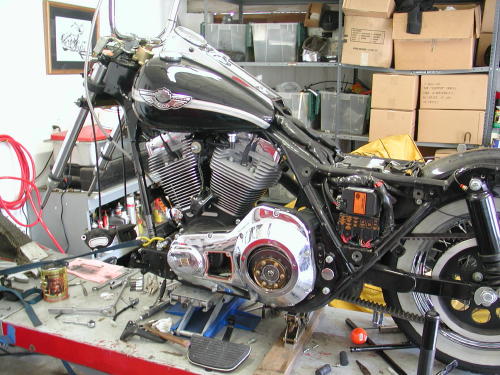
The King stripped for powder coating.
The plan was to strip the bike of all the brackets, tabs and accessories we could get our hands on and have them black powder coated by Custom Powder Coating in Dallas a Bikernet Sponsor.
We ordered additional accessories to enhance the clean black effect. First we ordered the Harley-Davidson black mag wheels and floating rotors with black centers. We pondered the front fender and trying to black out all the trim. During research we discovered, in the Winter P&A catalog, brackets to allow a Fatboy fender to be bolted in the King front end. The Fatboy fender is a cleaner unit, but it still has rivets and ribs. We opted for a solid black Street Stalker fender that’s clean as a whistle and light as a feather.
We also decided to switch the rear turnsignals out for the new Screamin’ Eagle teardrops and the narrower light bar. When they arrived we had to tear the lights down. We cut the two plug wires in a staggered fashion. The light bulb was then removed and we used a coat hanger tool to hook the plastic base and pull it out of the shell. Lastly we ordered the Harley-Davidson fender, license plate mount.
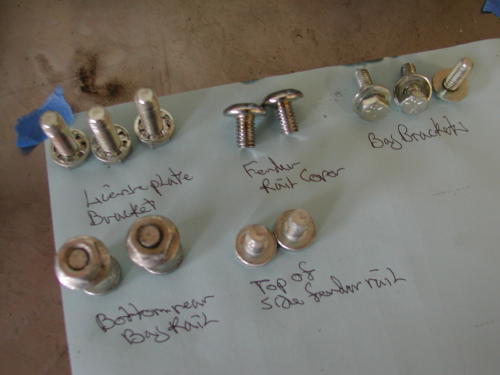
The first thing we did was to clear off our bench and tape down a couple of large sheets of paper. We organized every nut and bolt, screw and spring.
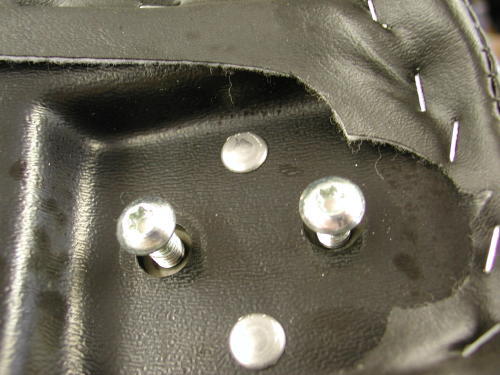
I ordered the billet seat tab from the catalog in the Multi-fit area. When I ordered a slim seat it didn’t come with a tab so I had to move the tab each time I switched seats. I powder coated both for more simple assembly in the future.
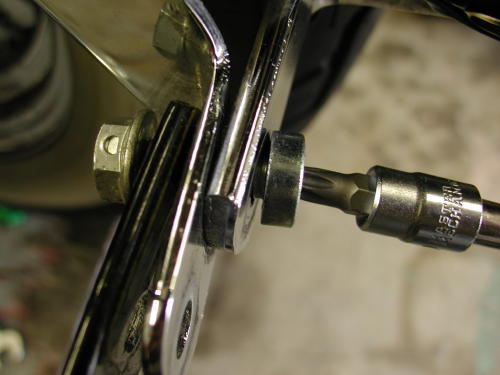
Nuttboy and I started the process removing the bags. I began the process of removing all the bag brackets and roll bars. Each time we removed a fastener we set it on the sheet of paper and wrote a description.
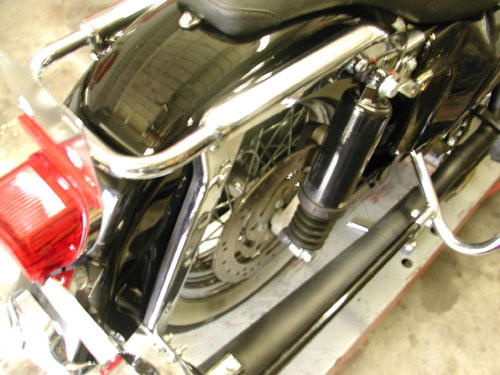

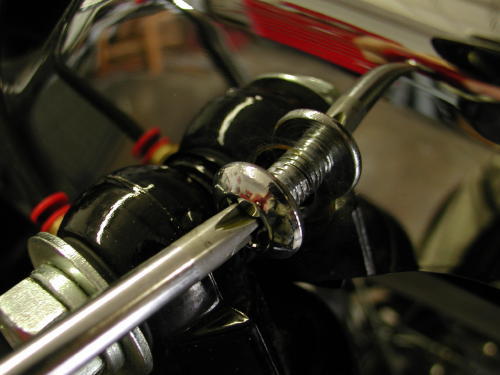
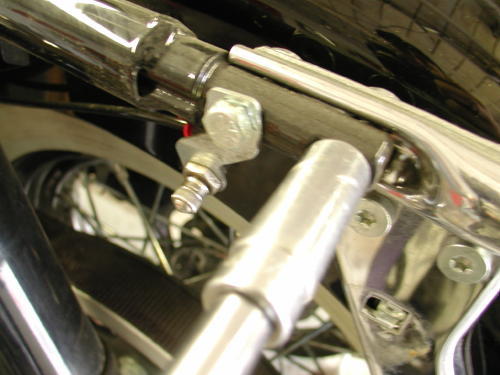
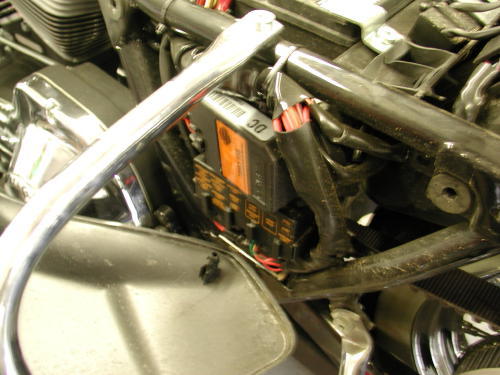
We had to pop the plastic side panel loose and take the seat off to get at the roll bar fasteners.
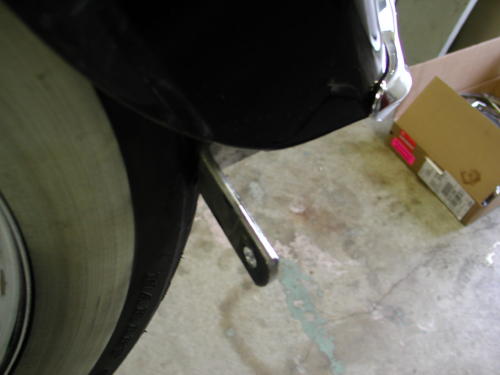
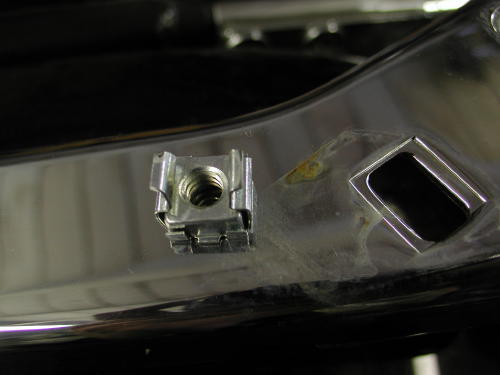
This shows one of the bag bracket fasteners that are inserted into the bag rails. I thought about pulling them for fear that the heat from the powder coating process would weaken the spring tension. We tested the theory by leaving some in place. We didn’t have a problem, either way.
On the left side I had to remove the passenger footboard to take the derby cover off. With each note on the sheet of paper we listed the number of fasteners for each application. The more information the better. I had to remove the seat and the King side panels to take the bag roll bars off. Many of these items were held on with Torx bolts. It’s a good notion to buy a set.
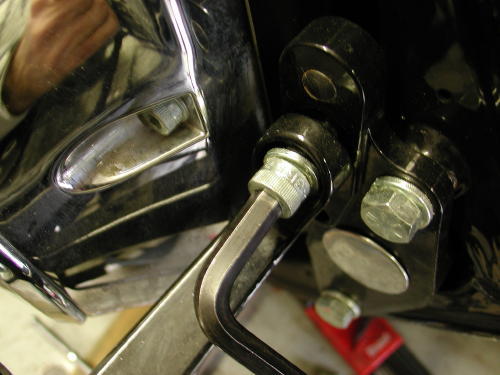
This footboard had to go to reach the derby fastener.
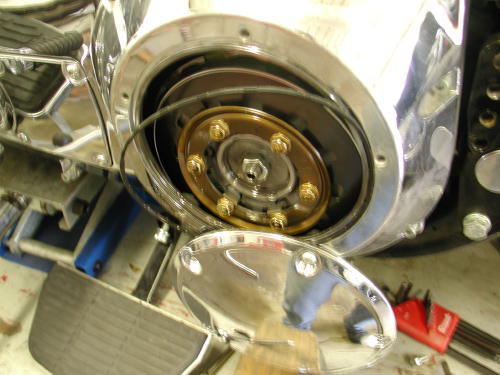
I started to remove the shift levers and discovered that I had to remove the footboard to reach the inspection cover Torx fasteners. I wasn’t sure if the footboards would have black in their future. At first I reviewed the area of the black board that would show, just the rim. Then we turned the board over and studied the way the rubber suspended pads were installed. We discovered that the pads are removed easily with a punch to the edges of the bottom protruding rubber lips. The boards went into the box for powder.
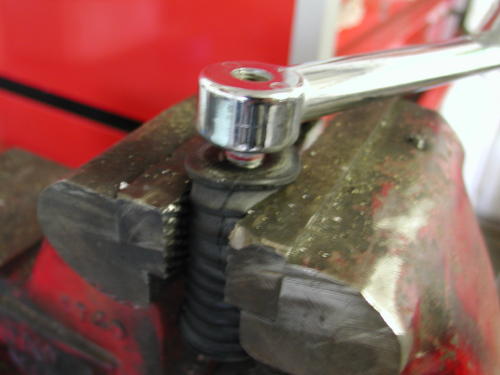
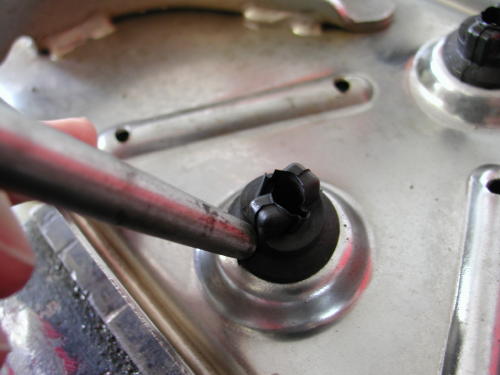
This was a simple process to tapping the edges of the rubber with a large tap and rubber hammer. We tried driving them out with the tap first, through the center. That didn’t work.
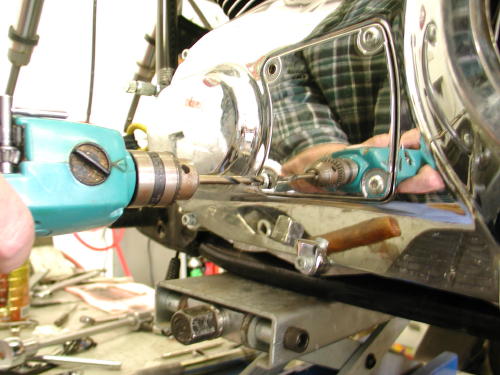
The mechanic’s law calls for one screw or fastener to seize every time. We had to drill out one of the inspection cover screws.
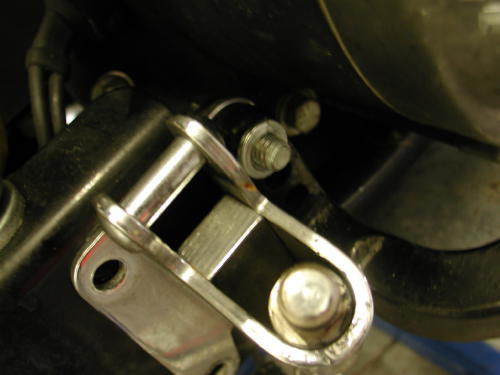
I tried to take off the kickstand the old fashioned way by removing the tooth then pivoting the arm forward. The spring wouldn’t come loose. I had to remove all the fasteners.
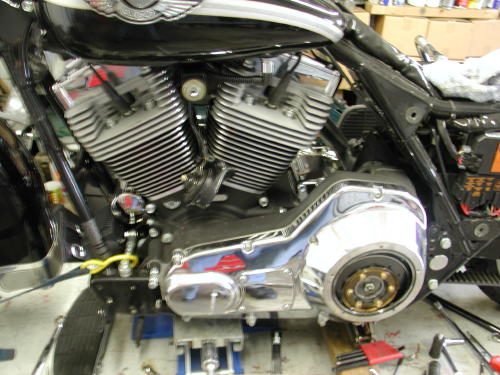
Metric fasteners haunted me from time to time, including the red Loctite touched horn fasteners which were #10 metric sockets. The Showa front end was covered with metric 12 point fasteners. It forced us to hit a commercial tool shop for 12-point metric sockets.
As the last of the fender rail parts came off we marked the loop that carried the license plate. We planned to replace the license plate holder with a fender-mounted job that attached below the taillight. We cut off the existing license plate loop, then I brazed washers and nuts so we could screw small orange reflectors in place.
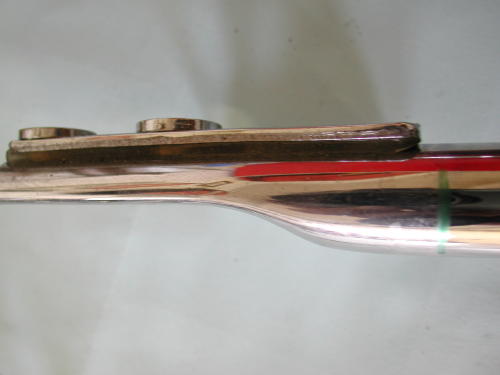
We marked the old license plate rail with a felt pen so the cut would fall just under the fender rail cover.
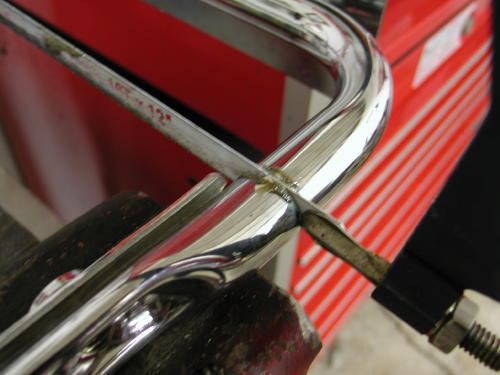

We didn’t use these reflectors. We were looking for Harley orange reflectors with steel backs.
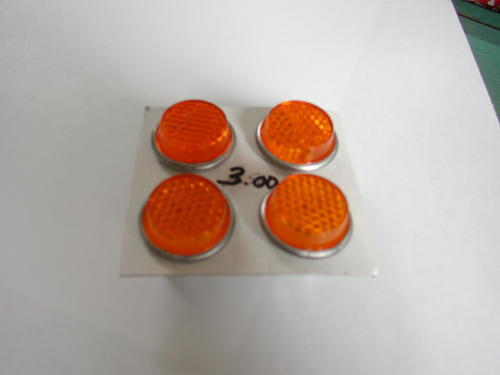
After a swapmeet run we had the right stuff for the job.
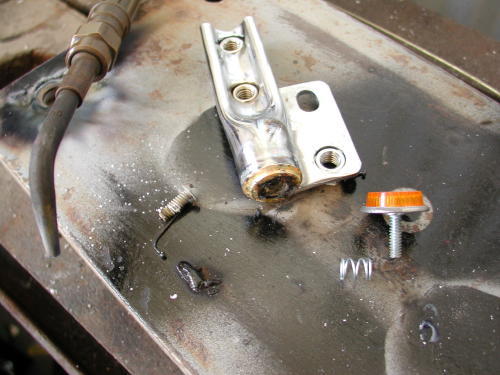
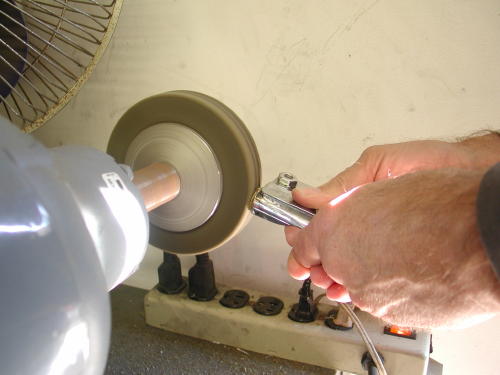
Sin Wu wandered into the garage just as I turned off the torch. She shuts down productive activity wherever she goes. She had a couple of alloy knitting needles that she offered us. I discovered in short order that the long alloy knitting needle worked perfectly for removing the hard-to-reach cotter key behind the brake pedal.
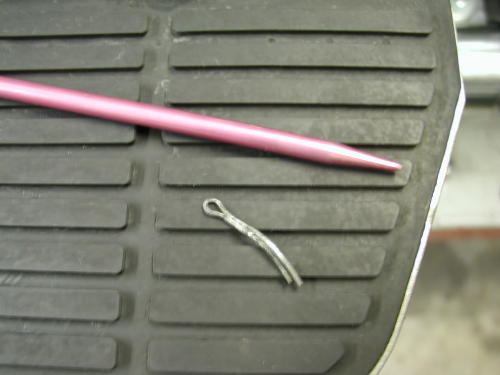
I had the toughest time retracting the clevis pin from of the pedal that hinged on the master cylinder piston. Finally it was removed with a punch from under the frame. The brake pedal caused me so much pain it didn’t make it into the powdercoating box. We painted it with a rattle can after prepping.

Continued On Page 2
Sturgis 2001 Part 2
By Robin Technologies |
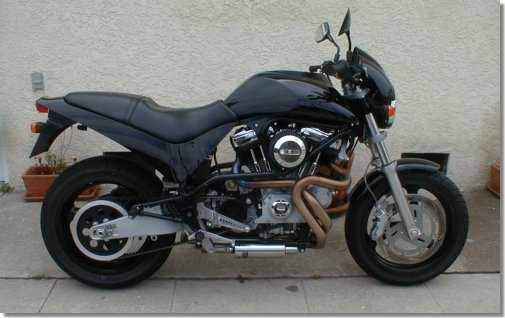
Here’s a couple of shots of the Bikernet Street FightingBuell for Sturgis 2001. This is how it currently stands with ahandfull of minor modifications and a lot of plastic removed. Let meknow what you think.
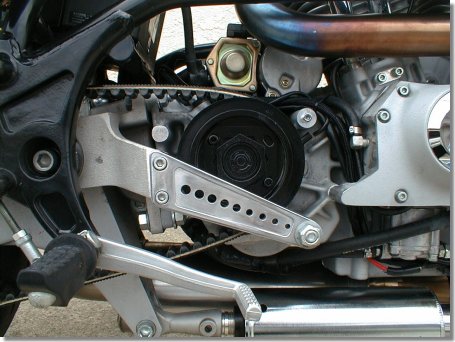
Note the pulley guard. We had the notion to take levers andbraces like this off, lightening-drill polish and replace. Not sureif that’s going to be the bit, now, but this brace was the test. Ithink we’ll powdercoat rather than polish.
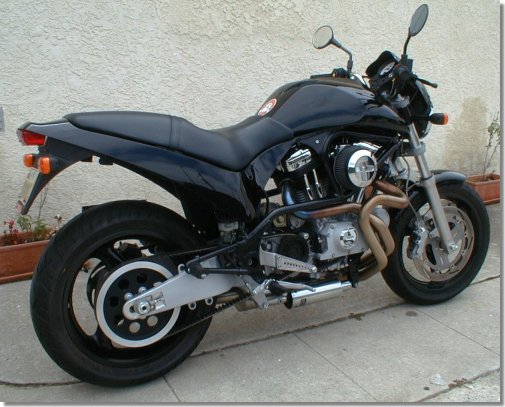
Trying to keep polishedaluminum up on a bike that’s well ridden is a pain in the ass. Haveyou seen a polished engine after a ride to Sturgis? We plan to removethe triple trees and swingarm. The tabs for the plastic dust shieldsneed to be removed and then the parts need to be polished to removethe ribs and casting marks before we decide on a finish.
Let us know what you think. I think I should black powercoatthe swingarm and maybe the trees and lower legs. We’re looking for apainter for the sheetmetal, and we’ll be ready to rock.
–Bandit
Sturgis 2001 Buell
By Robin Technologies |

It’s part of our job as moto-journalists to try what’s outthere in the American market and report back. The ultimate test is to take a bike, customize it and ride it to Sturgis. What could give you a truer test of a bike’s ability to look cool and endure a long run? I’ve been fortunate enough to customize and ride everything from nearly bone stock bikes to ground-up customs. Each trip is an adventure. Each run has varying characteristics, and with each journey there’s a new woman, but that’s my problem.

This year we needed to make a choice. I had a Kenny Boyce ProStreet frame that I planned to load a Twin Cam engine into and rideto the Badlands. I also had a 2000 Buell M-2 and I had recentlyinstalled dual Mikuni carb heads on my ’48 Panhead. Since I’m alsoworking on a Pro Street custom for Dr. Ladd Terry, the Bikernetmorale officer, I decided to hold onto my Pro Street project for nextyear. Another doctor, Dr. Hamster, had been working on his 34 VL andwas excited about riding it to Sturgis. We both knew that the antiqueride would be a long shot.

On top of the time/money consideration, I enjoy riding the M-2. It’s the hotrod of Harleys, light, agile, brakes like a madman and hauls ass. The guys at Harley like to refer to Buells as their street fighters. I have to agree. So I decided that I needed to put some miles on it and experience its ability for distance. Like last year when I told folks that I was going to ride a rigid toSturgis, I got the same reaction to the Buell. I rode it toLaughlin with a passenger and soft saddlebags. The bike handled likea dream. At 100 mph, it was more stable than most Big Twins, andacceleration was always at hand. There’s no hesitation from zip to 100 mph, and that’s my riding range.I was advised at one point to put a smaller pulley onthe rear for lower rpms while cruising. Later I found that themodification had its glitches. I found that the bike was glass smoothat 100 and still zippy and that was good enough for me. We began aseries of mild mods with a cam change to the Screamin’ Eagle raceversion and added the stainless race header. My partner to Laughlinhad a blast and was so comfortable she passed on several rest stops.We kept going and ran out of gas in the desert. So you can understandwhy there’s a new woman each year. She’s still out there somewhere.In the final analysis the decision was made to ride the Buellto the Black Hills Rally.
If you’ve read the techs, you know what wedid to this puppy, so I’ll go beyond the build to a few conceptionsabout Buell. First, there is no fairing to speak of, but I actuallyfound the bike extremely comfortable to ride. The little chin fairingkeeps the big blast off your chest and I didn’t need anymore. I mayregret those words as I hit the Colorado monsoons, but so far, sogood. Some guys complained about the sitting position, but I found itcomfortable once I knew how to sit. Like any bike, you need to findthe groove. The brothers talked about leaning on the bars and toomuch weight on the wrists. I found that if I leaned over the bars Iput excessive weight on my grip, but if I sat on my ass, it was nodifferent than other bikes, although under hard braking situationsyou are thrust forward.

Some felt the ride on a Buell would be rough, yet most wereunaware that the bike is basically a rubbermounted Sportster, andincredibly smooth, especially at 80-100 mph.

Others thought I mightlook ridiculous, and I told them I look ridiculous all the timeanyway. What difference would this year make? Others don’t like midcontrols. If you’re not used to them, you may find that you need toadjust, but once you get the hang of them, you’ll find less pressureon your back.

Alright enough perceptions and conceptions, let’s get readyto ride. The Buell has 400 miles on it since we made thecosmetic changes and cured some rocker box leaks.
This last week weinstalled Joker Machine billet and anodized turn signals on it and hidthem as much as possible.

We picked up a small oil cooler from ChromeSpecialties and installed it with longer oil lines at the front ofthe bike. The oil capacity is about 2.5 quarts, which always makes menervous, so we changed oil and plugged in the largest Dyna oil filterwe could find. The filter and cooler combination allowed us to squeakin 3 quarts and take some precarious kinks out of the lines. I alsostopped by Joker Machine and they liked the mods so much they told meto run one of their point covers or die.

Dewey’s Custom Pegs makes thecleanest air cleaner cover on the market and it fit like a dream.Finally we ordered a chrome hardware kit for the rear pulley. While disassembling the rear wheel, we polished the right wheel spacerand the belt adjuster guides–not bad touches.
So Sturgis 2001 is one week away. If I collect enoughaluminum cans off the beach I’ll have a pile of quarters for spendingmoney. The woman in my life is the best candidate to run Bikernetwhile I’m on the road, and I’m ready.

This is our quest each year,to build a vehicle and make it to the Badlands to talk about it. I’llhave a full report upon my return. Hang on.
The Amazing Shrunken FXR Project Part 3
By Robin Technologies |
Bandit and I were checking out the Amazing Shrunken FXR. “Thedamned thing,” referring to the shrunken FXR project we had beenhammering at, off and on, for almost two years, “has attitude,” hegrowled, “a bad-assed attitude.”
“Yeah, but will it have sound attitude?” I mused. “I want it toget attention. I want it to be felt in their chests before they seeit. I want them to hide their children from the evil they fear.”
The Amazing Shrunken FXR has developed into a mythic ethos. Froma cardboard box full of rejected, beat-up, and cast off parts, thebike has become a sculptured icon, a physical dream, and perhaps awrong turn down a bad dirt road, three miles back.The project began back in the spring of 2001. After a lot of fitsand starts, the Buell Project, the Sturgis Run, the Deer Gut stewadventure, Bandit’s painful recovery, the Red Ball prep, variousevents including a trip around the world and soiree’s, we slappedparts on, hammered steel into shape, welded this and that, cussed andfarted and got to where we are with the help of a RevTech driveline,Custom Chrome, BDL belt, Joker controls, Cyril Huze sheet metal andCompu-Fire electrics. The bike is raw boned, trimmed down, and meanlooking. That’s where it stands, inert and waiting for inspiration,up on the rack at the Bikernet garage.

Bandit regarded the raw metal frame with squinty-eyed intensity.”What you thinkin’,” I asked, keeping my own gaze focused on thepotential of the bike. At my question he stretched out his gangly,egret-like frame to its full 6’5″. “It’ll be a loud mother fuckereither way you play it,” he intoned in his gravitas basso-profundodeep voice. “We’ve shortened the frame and rear wheel base so muchthat it’s barely a cunt-hair from the exhaust port to the rear wheel.”
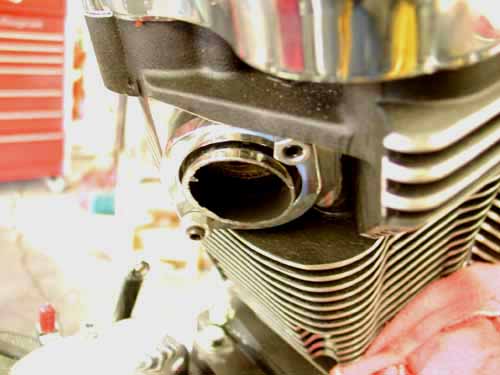
We cut a piece of an Samson Evolution system with a Mikita touse the exhaust port, then started welding other pieces in place. Wecut it back to make a tight turn and create space away from the oiltank.
“Fuck it,” I responded in my best Pancho Sanchezimprovisation, “let’s just start from the port and see what happens.”
We rummaged through a pile of Samson scrap exhaust pipes that wehad scavenged from a dumpster behind the Sampson factory. Flingingout fish tail tips, shot gun systems and swoopy cruiser exhausts,most of them dented and damaged so they couldn’t be re-used. Mr.Samson gave us only the best to modify. We eventually came up withenough pieces to fabricate a Frankenstein exhaust system.

As I grabbed for a section 1 3/4-inch chrome pipe, Imistakenly grabbed a goodly chunk of fur. Bandit’s midget, crazeddemon of a feral cat yeowled in protest and sank his needle-liketeeth into the back of my hand.
“God damn that crazy bastard,” I screamed, “he’s as crazyas a peach orchard boar.” I’m sure Bandit has a mescaline salt-lickfor that freaked out feline.After I extricated my hand from the jaws of Bandit’s feline Cujo, Ireturned to the exhaust system at hand.
Our intent was to minimize the exhaust system as much as possible.We ran the pipe straight down from the front exhaust port, thenturned it to hug the bottom of the engine case. We had originallyhoped to put a flattened pipe under the frame, but reasonable roadclearance dictated a different path. So we tucked it in and aroundthe engine case, then inside the frame, coming out just at the edgeof the back wheel.
“Our first mistake,” Bandit spouted, “we needed a smallerdiameter chunk of exhaust to form guides when welding chunks ofexhaust together. If we had slipped it in one piece even a quarter ofan inch. it would have held each chunk in alignment. That’s onetheory to building pipes. The key to fabing your own pipes is havingenough scrap to slice and dice, then cutting and working each pieceuntil it’s as close to a perfect fit as possible. Finally the tackingprocess is critical. That’s were the guides didn’t come in. If we hadguides we wouldn’t have offset pipes tacked into place. That problememerged severely a week later during the grinding process.”
“It took two days of playing, cutting, fitting and welding toform a completely custom exhaust system in place,” Bandit added.”Make sure you wet towels and form a fire barrior around your tackingarea to protect the rest of the bike. I used a small 0-sized torchtip and common hanger to tack the segments of pipes together. I’m notconfident enough with our new MIG welder with thin sheet metal, so Istuck with the torch.”

” It wasn’t perfect, but it was ours,” Bandit added, “acompletely unique system that would be tucked under the transmissionand attached to the driveline solidly under the tranny backing place.Then we faced the muffler aspect. The pipes were too short to be openor we would have been arrested within a block of the headquarters.”
Needing some kind of ‘standardized’ muffler elements, we went toour local San Pedro Kragen Auto Parts store. With the clamp-on piecein hand, we found parts and pieces enough to create a 7″ mufflercase. “Most of the elements were too heavy and glass packed,” Banditspouted, “We couldn’t weld on a glass pack.”
Back at the garage, with torch in hand, Bandit cut out a sectionof baffles from some scrap Sampson muffler. Spot welding the bafflesinto our jury-rigged muffler, we produced something that may, likeJapanese Fart Wax, diminish the painful ‘Brap-rap-rap’ flutter ofunrestrained exhaust back pressure. A right-angle turn-out willdirect the dragon’s breath exhaust from the screaming 88cc Rev Tech,high-performance engine to an unsuspecting public standingslack-jawed and terrified at the curbed edge of civilization, theirhair-dos blasted straight by the sizzling after-burner of the AmazingShrunken FXR.
“He gets sorta twisted,” Bandit muttered shaking his head.”Actually with the baffle in hand we went to San Pedro Muffler Shopand looked at the myriad of tips and tubing alterations we couldmake. We found a tip and had a chunk of 1 7/8 tubing spread to matchthe tip. That formed the other end of the muffler. We just had toweld the three elements together.”
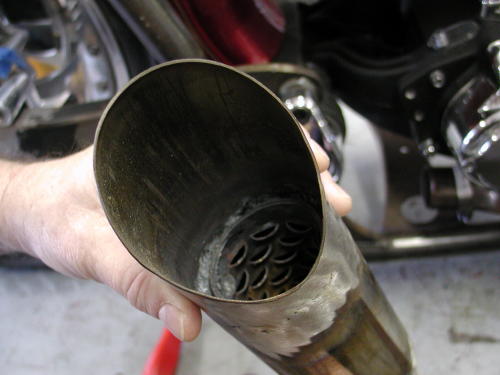
I welded the baffle in place, positioned as it was in theSamson System. I discovered that the two elements didn’t want to weldtogether. I have a feeling the tip was made of an inferior metal.
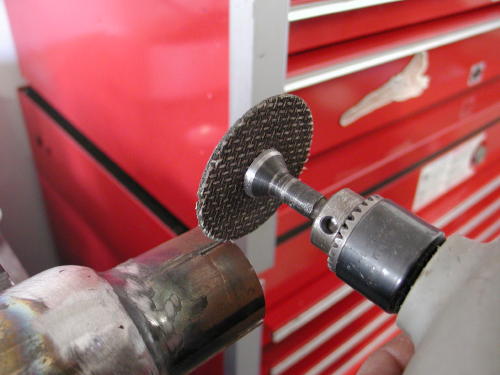
With the die grinder we cut notches for the muffler clamp.
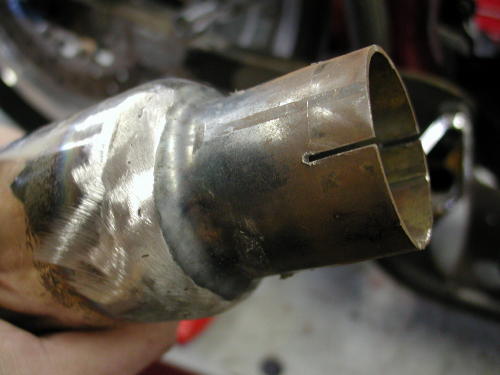
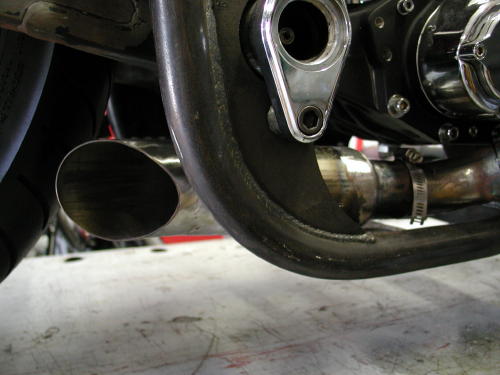
“After welding and fitting I stood back and was proud of ouruniquely tight system that would allow Giggie, from Compu-Fire, tomachine mid-controls for a final touch,” Bandit interupted. Theexhaust played perfectly into the Shrunken aspects of the project. Iremoved the tacked system and began hours of gas welding to make itwhole. That’s when all hell broke loose. While working on anotheraspect of the bike with my back turned to my partner, he began togrind the welds. The college art history professor sought perfectionwith each weld and ground right through the thin walls of the18-guage exhaust pipes. It was amazing. I was sure the system wasruined.”
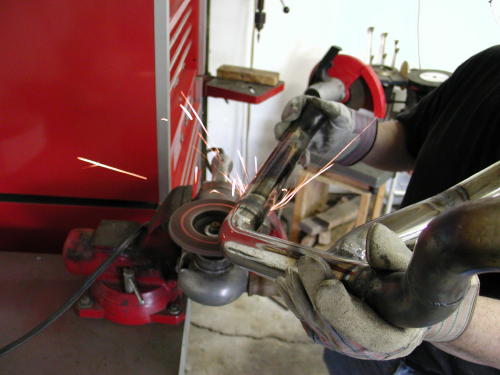
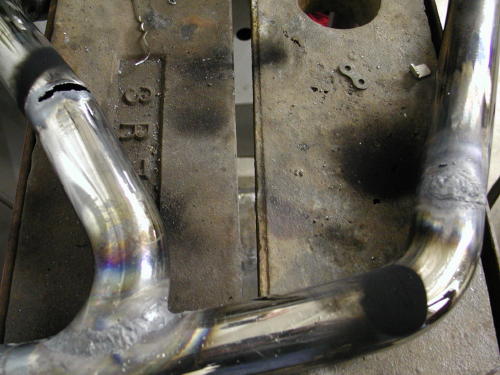
This shows the amount of area ground down so far we were forcedto fill it or destroy the system and start over.
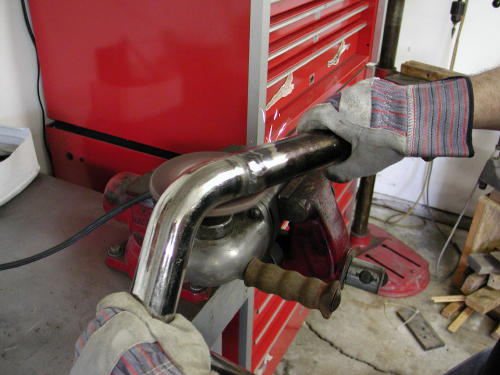
“Some builders tack systems together then take them tomuffler shops for professional construction. I thought that was mynext move. Unfortunately a regular muffler shop doesn’t have themandrels to make the tight bends we had proposed. I was devastated,but the man told me that he could fill the welds with his MIG welder.
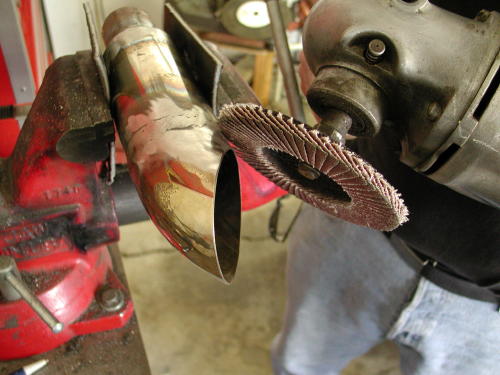
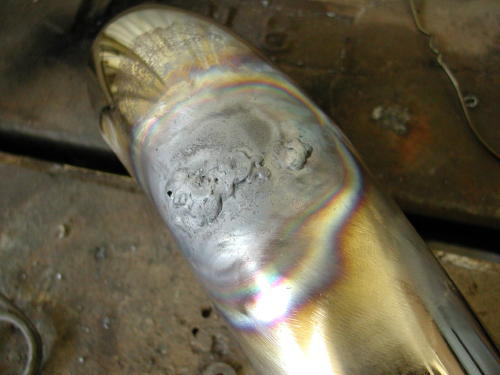
More welds to fill the mad grinder’s cutting work.
“Unfortunately each weld was now a 1/2 inch tall and wide zit atalmost each junction of the pipe. Nuttboy began the grinding processagain. More holes were found and I filled them with gas welding usinghanger rods. I joke now that if the bike runs like shit we blame iton the exhaust system. If it runs well, it’s the same roll of thedice. We’ll see.”
“Making your own exhaust system can be a blast, just don’tget heavey handed with the grinders. Pipe is thin and a little weldthat shows won’t matter much since we didn’t plan on chrome, butblack Jet Hot coating. I’ve sworn off chrome exhaust systems on mybikes for the future.”
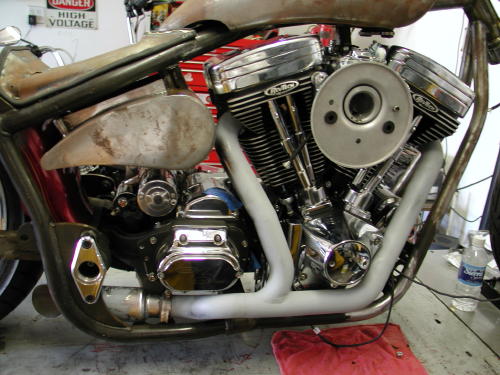
That big bastard just won’t shut up. The next episode in thismechanical adventure will feature Giggy’s attempt a electrifying thesteel monster. Next weekend, barring any new bike projects, Giggy’sinopportune finger damage at the power tools, splattered deer guts,San Pedro political insurrection, Sin Wu’s beguiling charms, a caseof beer, or any other form of diversion or chaos, we will be closerto cranking this monster over.
To Continue……..
Back to Part 2……..
Back to Custom Chrome on Bikernet……..
Back to Joker Machine on Bikernet……..
Sturgis 2001
By Robin Technologies |
Buells are the Harley-Davidson street fighter. They are inexpensive,sharp-handling machines that give the American rider something toshout about, something to fuck with and something to race.
This bike won’t compete with the 200 mph Japanese sportbikes, but it will handle like one, and brake like one. So we gothold of one and evaluated it for the Sturgis 2001 run. Since I come from a custom bike or chopper background, I wasn’t sure the Cyclone would do the job for me. If you ask a guy who rides a custom bike what style of bike he enjoysand why, the answer might be strange. I want something distinctiveand bad. I want it fast and cool. I need it to handle, but be achopper. Perhaps an oxymoron of conditions, yet there’s a mixture offactors that go into any ride and machine. Last year I rode astretched rigid with a 14-over front end. What a machine. For a rigid,it rode like a dream. For a 14-over front end, it handled well and Ipassed everyone I dared to pass, generally because I had the groundclearance to shove it close to the pavement and the raked tripletrees allowed me to turn the front end where I needed to go.
Each year the trek to the Badlands takes on a differentdemeanor, and this will be no different. After a week, I discovered a serious sense of enjoyment about straddling the M-2 Cyclone. It’s light, fast, a nimble handler that stops on a dime. I needed to learn to ride it like a race bike with my toes on the soft rubber pegs to enhance turning radius and ground clearance. There is also a notion that in the sportbike position, you’re forcing too much weight on your wrists. I discovered quickly that if I put my ass down,the weight on my wrists was not a problem. The force is substantial, however, when braking with a passenger on board. Ultimately, after riding two Buells, I decided that this motorcycle deserved a shot at aSturgis trek. It had class, felt sporty, even nasty, and I could makeit rumble. So I stood back and thought, “Can I make it even cooler?”It didn’t take long to discover that I could strip it down evenfurther than stock. I picked the Cyclone over the model with hard bags because of its bare bones feel. The crew here at Bikernet.com developed a five-pronged approach. One, we wanted toenhance the Harley-Davidson marriage with Buell and downplay thelittle-known name Buell for the time being. We also wanted to enhance the Sportstermotor and bring out the looks of the Harley-Davidson power plant, andchop it in a Buell way without altering the geometry of theframe, the front end length or lowering it, which is a tradition withour custom bikes. There’s more. We wanted the bike to sound more likea Harley and we wanted to enhance the performance without disturbingthe long-range reliability.
Our team included myself, Professor NuttBoy, consulting fromPaul Davis of Charlotte, Gene Tomasen Jr. from the Harley-Davidson fleet center, and a number of Bikernet readers who knew about and were testing Buells. This is the first of several techs on the modifications and the experiences we have with the M-2. We collected and ordered parts, then ran to the fleet center to get thejob done. The initial plan was to unleash the natural performance ofthe bike without breaking down the engine. We started by removing thecarburetor.
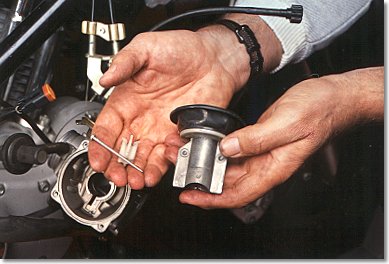
We replaced the needle in the slide with an ’88 Sportsterneedle, and drilled out the carb body above the idle adjustplug.
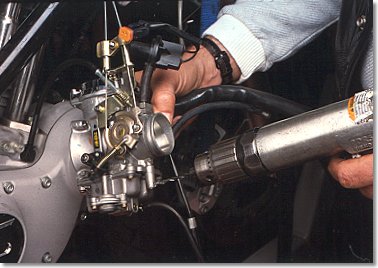
That allowed us to knock out the plug and back outthe idle adjuster 2.5 turns.
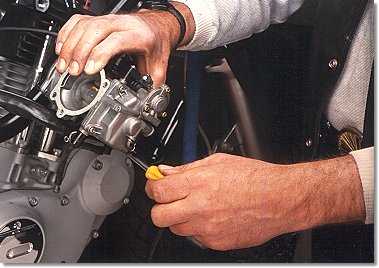
Stock carburetors are adjusted from thefactory to a very lean condition. Usually they are so lean that warmup takes a long time and you get an occasional cough through thecarb.
Others have recommended drilling directly through theplug, but Gene warned that if you slip, you will drillinto the adjuster screw and possibly damage it. Gene also recommendedhead work ultimately coupled with a 44 mm CV carb, manifold androller rockers in the future. I had a Screamin’ Eagle air box for a BigTwin, which I modified for the carb with an open K&N filter. We alsodropped the float bowel and replaced the 42 pilot jet with a 48. Becareful not to strip the screws holding the float bowel in place.Treat them with respect or they’ll cause you nightmares.
We set the carburetor aside and began to remove the timingcover to replace the cams. It’s important to take a scribe to thetiming plate so that you can duplicate the timing once you havereplaced the cams. Then pull the plate and the rotor cup, which isscrewed into the No. 2 cam. Before you go any further, remove the rockerboxes and the rocker arms to unload the tension on the non-adjustablepushrods. Now you can remove the cam cover, but don’t forget todrain the oil first.
At this point we decided to add a racy feature to theappearance of the bike by shaving the cam cover plate. First removethe oil line. Unplug the timing plate wire, dismantle the connectorand pull it through the plate.
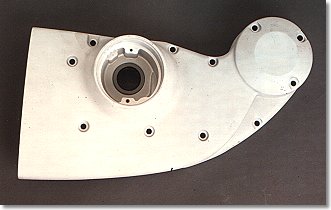
Gene used a Sawzall and a grinder toremove the aluminum underneath the bolt holes.
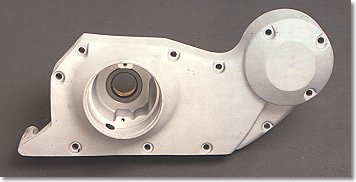
You will note that there is a series of seemingly endless webbing in this area which is for noisereduction.
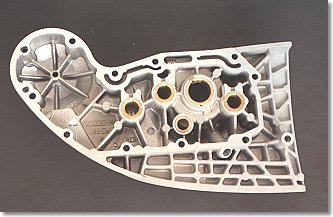
Notice that in the lower left hand corner, there is a dowelpin. Gene chose to leave it in place as a wiring guide and carve thecover around it.
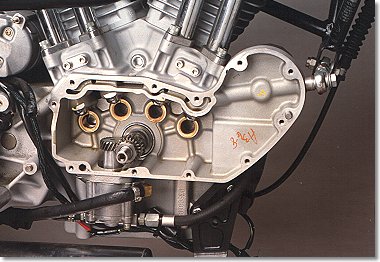
The pushrods are color coded: pink or red forexhaust and brown for intake. The cams are numbered like you readfrom left to right, or back to front, 1 to 4. Make sure you pull theplugs for ease in turning the motor over. Install No. 4 first with redline assembly lube; No. 3 has two index marks. Slip No. 1 in next andNo. 2 last. It has three index marks to line up the cam with the pistonposition and the other cams with an index mark that aligns with aslot on the pinion gear.
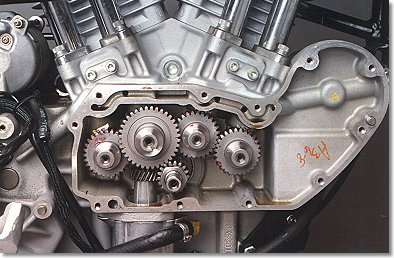
This is where we noticed that the pitch onthe Screamin’ Eagle race cams was different than the new pinionshaft gears. An emergency run to Bartels H-D was in order for partNo. 24055-91, or No. 24061-91. The factory changed to a new pitch in ’99.When replacing the cam cover, keep in mind that there are fourdifferent length Allens holding it in place. Make sure you have theright length in the right hole. The torque setting for the cam coverAllens is 17 foot pounds. After the cover went back on, it was timeto reinstall the rotor cap and the timing plate.
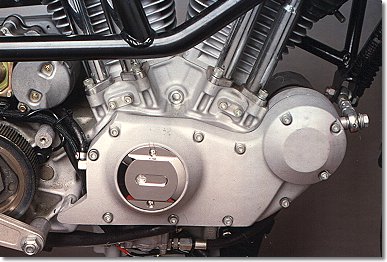
These modifications will help it run better. Buells usually run hot from the factory because of hotter cams and ThunderstromHeads. At this point we re-ran the wiring to the regulator behindthe oil pump for a cleaner appearance. We only had to extend onewire, to the oil pressure switch. Gene Jr. handled it with solder andshrink tubing. Removal of the gastanks is a breeze and access to the heads and top end is easy. But ifyou need to remove the engine, the fact that it is an integral partof the frame and suspension creates unruly problems. The entirechassis must be supported.
At this point we replaced the pushrods from the top of theengine and replaced the stock rockerbox covers with chrome units.Don’t use anything on the self-sealing gaskets except a dab of greasehere and there to hold them in place.
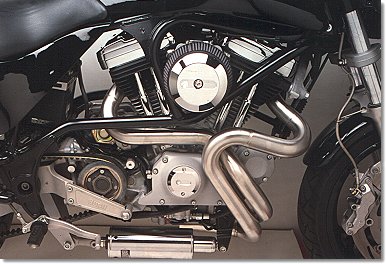
With the engine assembled, we replaced the stock exhaustwith a Buell race header kit and module. While Gene Jr. was out oftown, I spoke to the Buell tech of the demo fleet, Alan Varsi, who hasworked at Bartels Harley-Davidson for more than 11 years. The Buell racemodule retards the timing 5 degrees and eliminates the rev limiter.The stainless steel header is 11 inches longer than stock, which makeseach exhaust runner equal in length. The muffler is an aluminumcanister type that is high flow with low resistance for additionalperformance at the high end.

That’s it. Laughlin is right around the corner, along with our firstlong ride on the Harley-Davidson Street Fighter. We’re lookingforward to every desolate mile. We’ll report upon ourreturn. A new paint job is in the wings, along with some cosmetic modsto brighten the look of this bad-ass bike.
Road King 1/7/04
By Robin Technologies |

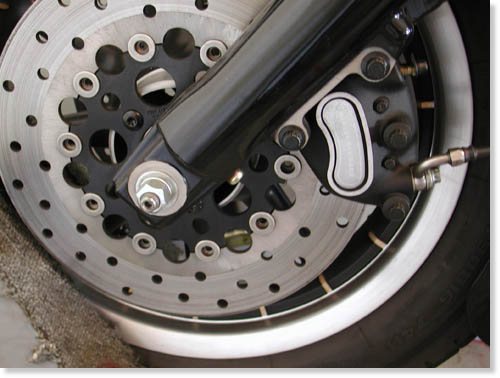
I had a bad feeling about this mod. First, I don’t like to pack anyone, any time. If you want a ride on my Panhead, carry a hand-towel and a bungie cord. I avoid giving a girl a ride home from the bar, even a babe with gigantic hooters. I would preferred to follow her home. I’m not the kind of rider to take a woman on a long run. I would rather have a variety of women in various towns and cities. Okay, I’m a bastard.
Okay, so the pressure’s on. Sin Wu want’s to ride once in a while, and I want to get laid daily. Gotta give up something. I kept the stock Road King classic seat for additional passenger comfort. It’s covered with dust, in the corner, but that quick change aspect is covered. I ordered the custom billet tab for the rear of the stock seat, and had it powder coated black, so both seats were ride-ready. When you purchase a new saddle, it doesn’t always come with the rear tab. The base is plastic and screwing fasteners in and out will wear out the threads.
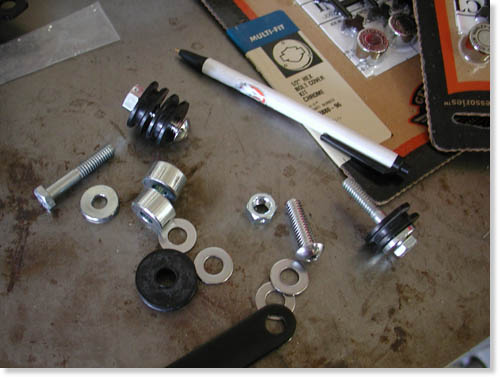
Here’s a handful of the fasteners and bag bracket spacers.
I ordered the front and rear detachable docking hardware kits, but be careful. I leaned toward the new lower backrest/sissybar for styling, which wasn’t in stock, but the pad was. I bought it, then the backrest was back-ordered so we bought the taller sissybar for immediate gratification, but when we got home the pad didn’t fit and we were forced to buy the tall pad. Watch out for this dilemma when ordering. Make sure to check all the installation instructions to make sure you have the correct puzzle pieces. There are several back rest options so watch that aspect when ordering.
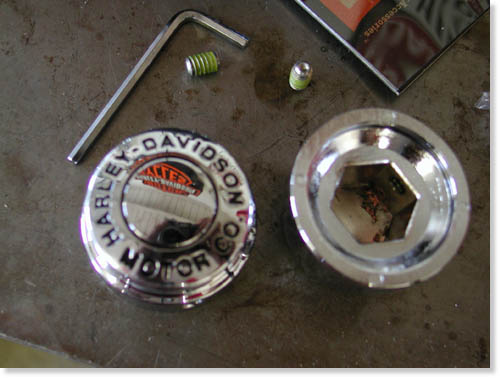
Here’s the massive chromed Classic H-D axle dress hardware.
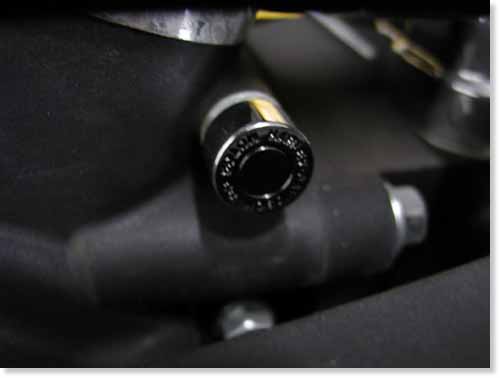
This is simple installation. Slip on the plastic wedge and the cap grips over it. Push them into place–done deal.
We also ordered some classic hex bolt covers and stainless Allen caps to begin an engine detailing process. We purchased chrome caps to detail the front brake calipers and classic chromed front axle covers. We didn’t use the plastic chrome caps ultimately but brush painted the raised edge of the calipers black. I’ll tell you why in a bit.
This was supposed to be one of the easiest mods we undertook, but we learned quickly, that wasn’t the case.
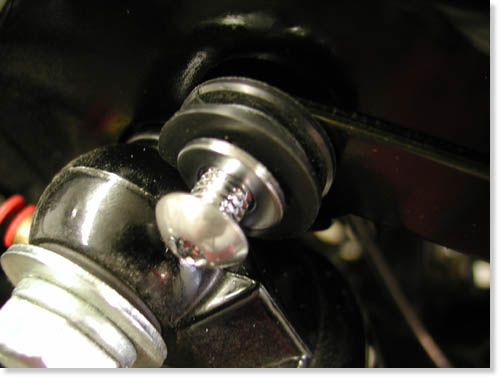
This is the front docking port in place, but not tightened.
When we black powdered a ton of components previously, we assembled the bike securely with Loctite and care. That was our undoing. The Phillips-head beside the shock needed to be replaced with the front docking hardware. Take one bolt out and replace it–no problem, right? The Phillips screws wouldn’t budge and we proceeded to strip the heads. First, I wished I had an impact driver.
I discovered an aerosol spray by Chemsearch called Yield in the auto parts store that loosens rusted bolts instantly. It worked like a charm, with a little patience the bolts came lose. An American Rider reader complained that this product isn’t available in retail stores. That’s true. My longshoreman connection hooked me up. You may need to find a factory worker or mechanic who has a connection.
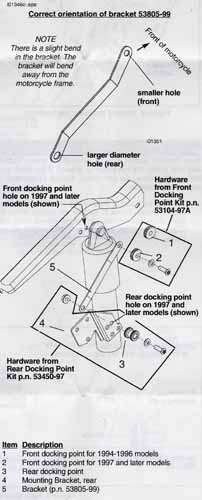
After reading the Low Detachable Backrest kit info that came with the taller kit, the Backrest Docking Hardware kit directions, the Front Docking Point kit instructions and the 100th Anniversary FLHT and FLHR Backrest Pad kit directions, I guzzled my first Corona.
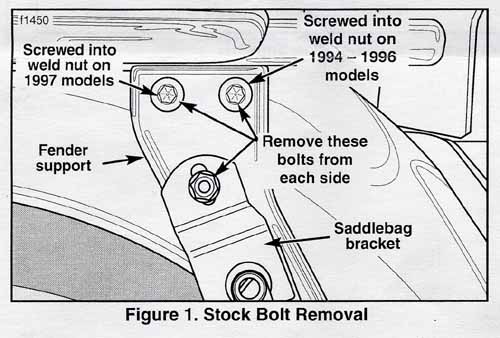
I opened the next Corona. The operation would have been simple if the directions were. I read them over and over. There were too many variations between years and configurations to sort through. The Front Docking port directions confused me with illustrations involving rear bag support spacers designed to bounce out the saddlebags and clear the release button on the backrest.
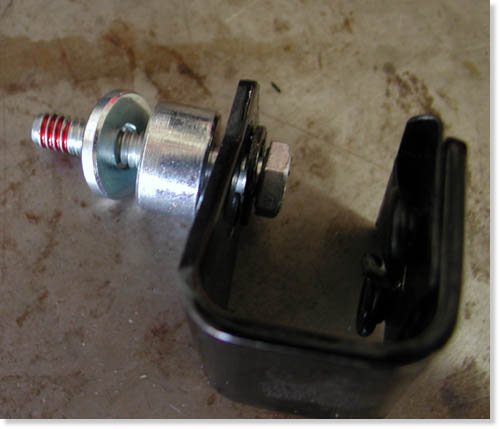
This was a matter of trial and error.
If you’ve built choppers as long as I have, there’s always a way to make anything work, so ignoring the confusion, we spanked our asses in gear. I ignored the spacers, installed the front docking rubber that was designed specifically for the King with a notch for the shock.
There’s a bracket that runs from the front docking station to the rear, but first the rear docking port bracket needed to be installed. On some models equipped with air shocks the shock filler bracket must be removed. The directions said I didn’t need to remove it on the 2003, bullshit. It was directly in the path of the docking bracket, so off it came.
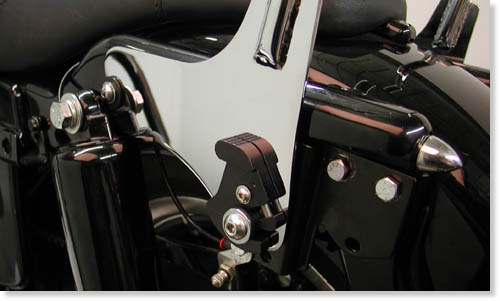
This shot shows the bracket in place, with the shock air port moved. Note the single empty hole in the bottom of the bracket. That’s where the rear bag mount bolts into place. The trick of the night.
Three lousy bolts had to be removed, the rear bag bracket 1/4-20 fastener and the two 5/16s fender support bolts. First the 1/4-20 spun the thin, tin clamp that holds the nut in place. Then the 5/16, once removed, could hardly be replaced. Nothing aligned properly. My lovely assistant had to squat and lift the tip of the fender, and in one case we were forced to remove the lower bag rail to align the top bolts.
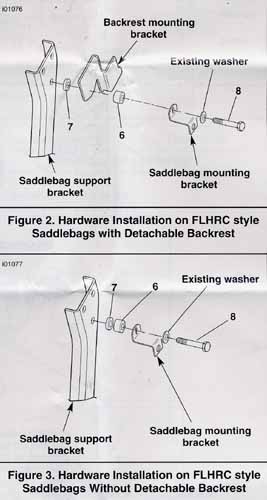
This still doesn’t totally jive. Actually washers had to be fed behind the top Backrest mounting bracket also.
“Can I let go of the fender, now?” Sin Wu asked grunting. The top docking port bolts are packaged in two sizes, 1 inch and 3/4 inch. The directions warn that if the rear inch-bolt comes too close to the fender, replace it with the 3/4. We replaced both and used the 1-inch jobs in the front holes on both sides.
Without the rear fender rack detachable bracket, another option, two washers were thrust under the rear docking port bracket to make up for the thickness of the rack bracket.
Part of the confusion was the numerous detachable elements available for various models. There’s also the two-up detachable rack front docking kit that surfaced from time to time.
That’s all there was to it. We bolted all the elements in place and tested the back rest and bags. Sure enough the King Classic bag lid smacked into the backrest latch when opening. We ultimately spaced the rear back bracket out only about an 1/8 of an inch and we were good to go.
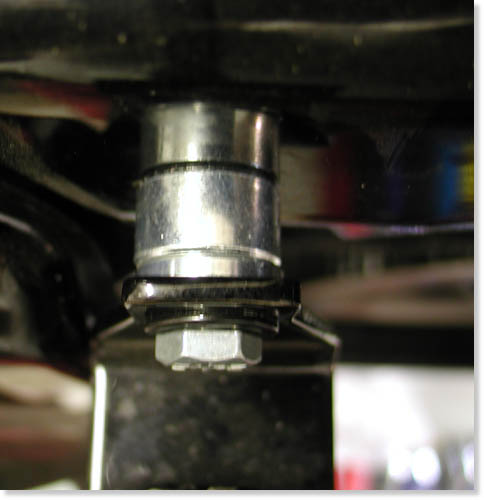
We tried it with the spacers, without, then with smaller spacers that worked perfectly.
Sin fed me chips and salsa and dabbed my sweating forehead with a bandanna, while I slipped the saddlebag bracket, 1/4-20 nut, into place using a long magnet. It worked on the right side. On the left we unbolted the entire fender support, replace the nut, adjusted the thin, tin tabs, and bolted the sucker all back together, only to have the nut fall out again. In this case we squeezed a slim square 1/4-20 nut behind the docking bracket and bolted the back bag bracket on with a spacer. It worked like a charm.
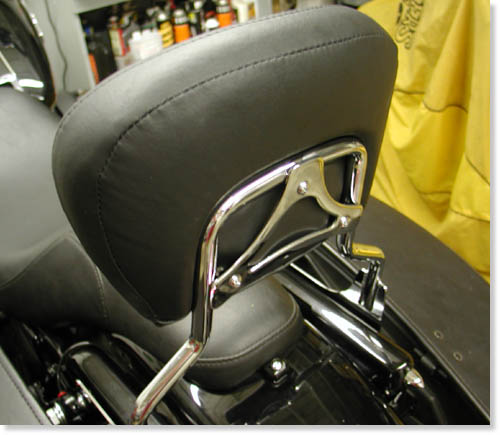
“Can we ride?” Sin cooed. I told her to gear up. We were just about ready to roll.
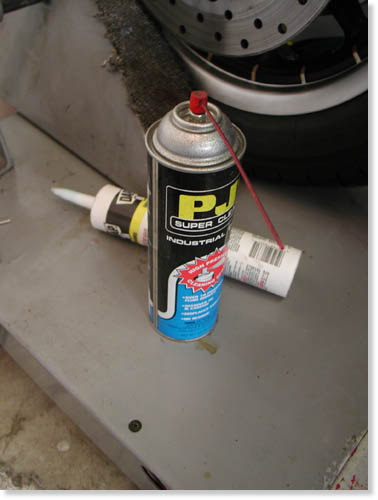
I used electrical contact cleaner to loosen the tin insignia plate, but discovered that wasn’t the intended plan. Leave it be, goddamnit.
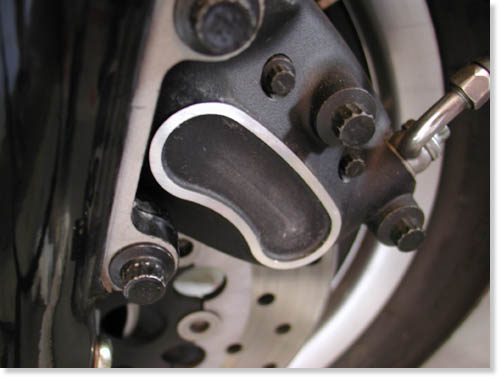
Here’s the totally clean caliper. Big mistake.
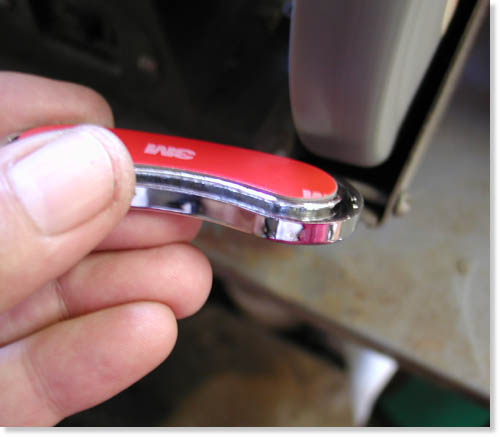
I ground the lip unevenly, but it then fit into the recessed slot on the caliper.
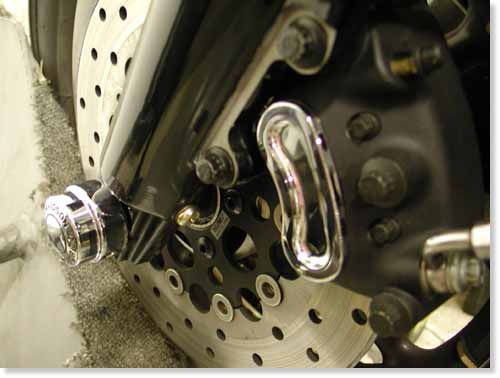
After grinding, all was well. Sorta.
The air in the garage eased as I warmed to her company. For an easy half-hour we played with the details of the bike by installing nut caps and front axle caps which I snugged down against a coating of silicon to prevent vibration.
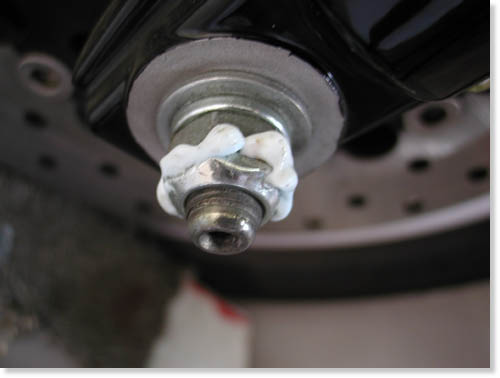
Some silicone on the axle nut will prevent vibration that may loosen the cap.
I discovered that the front chrome caliper caps stuck directly against the existing tin insignia. I took one off and cleaned the area thoroughly with electrical cleaner then the self-sticking surface didn’t reach the base.
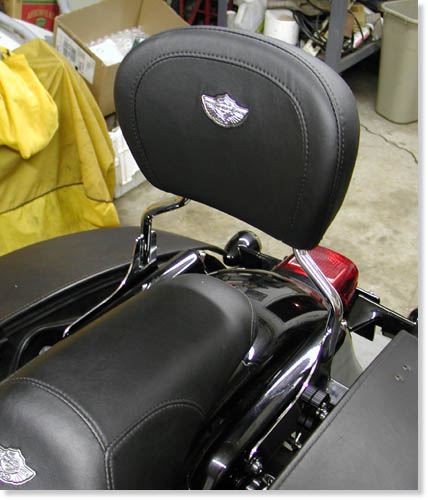
Here’s the 100th Anniversary backrest that will not fit on the short back rest bracket. We sent the short unit to Custom Powder Coating, in Dallas, for a coating of black.
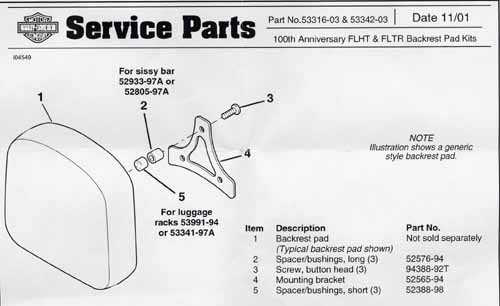
Note that there are various pads and various fasteners and spacers for different applications. Don’t try using common sense.
I ended up with 1/2 pint can of Rust-oleum paint and a small brush for touch-up details. I sent Sin Wu in the house to prepare for the ride. That meant striping out of her threads and waiting for me in bed. It’s the code. We must workout before we ride.
–Bandit
Editor’s note: I’m sniveling through this, but I’m sure with some experience this would have been a breeze. I suppose that’s what dealerships are for.
































